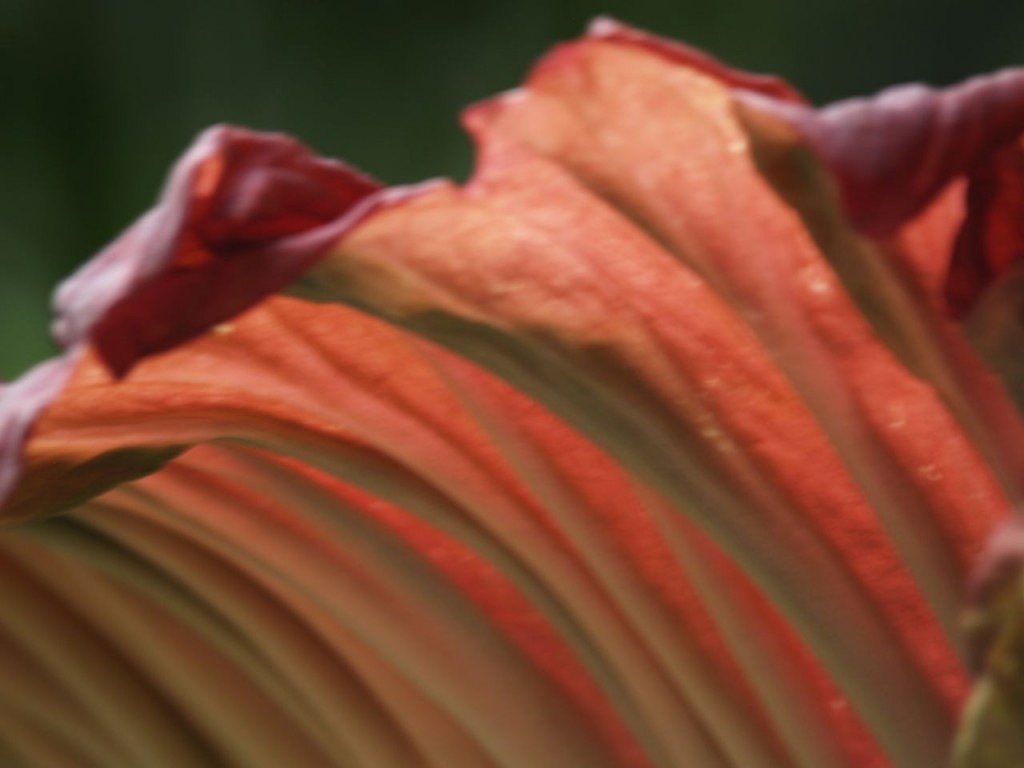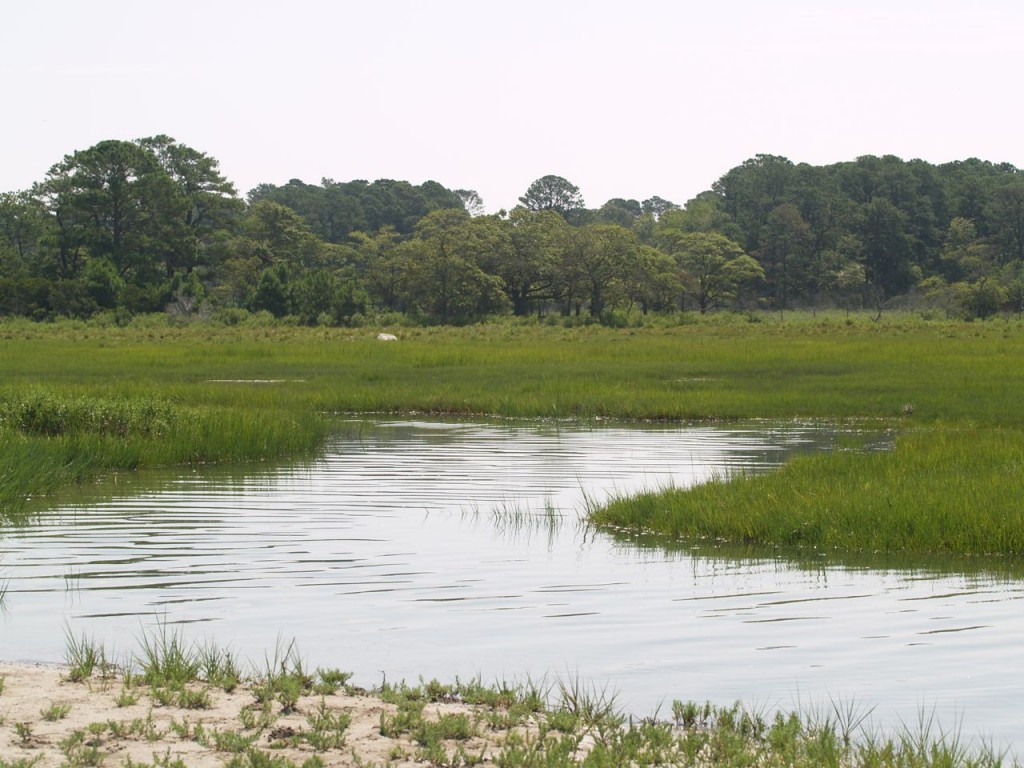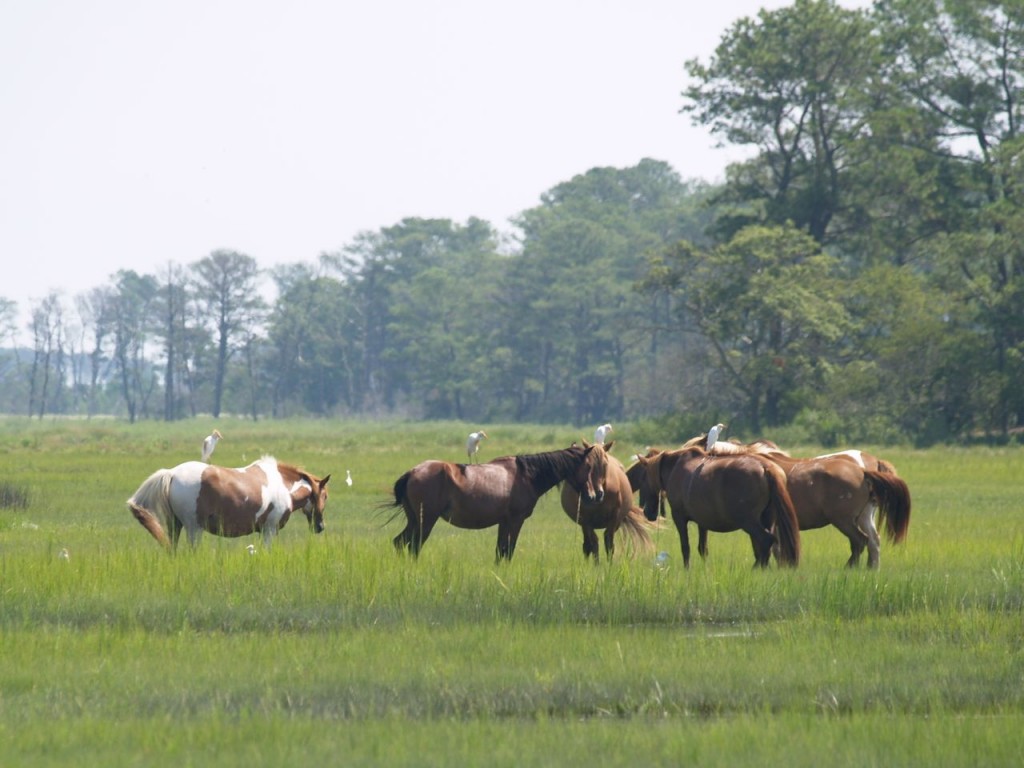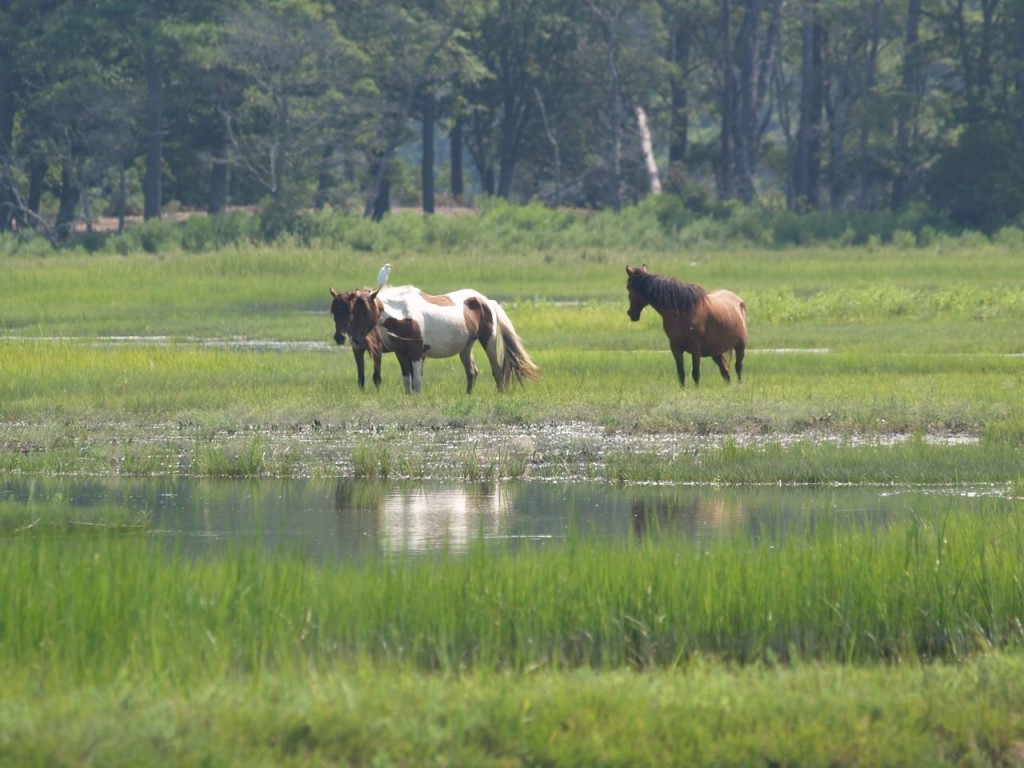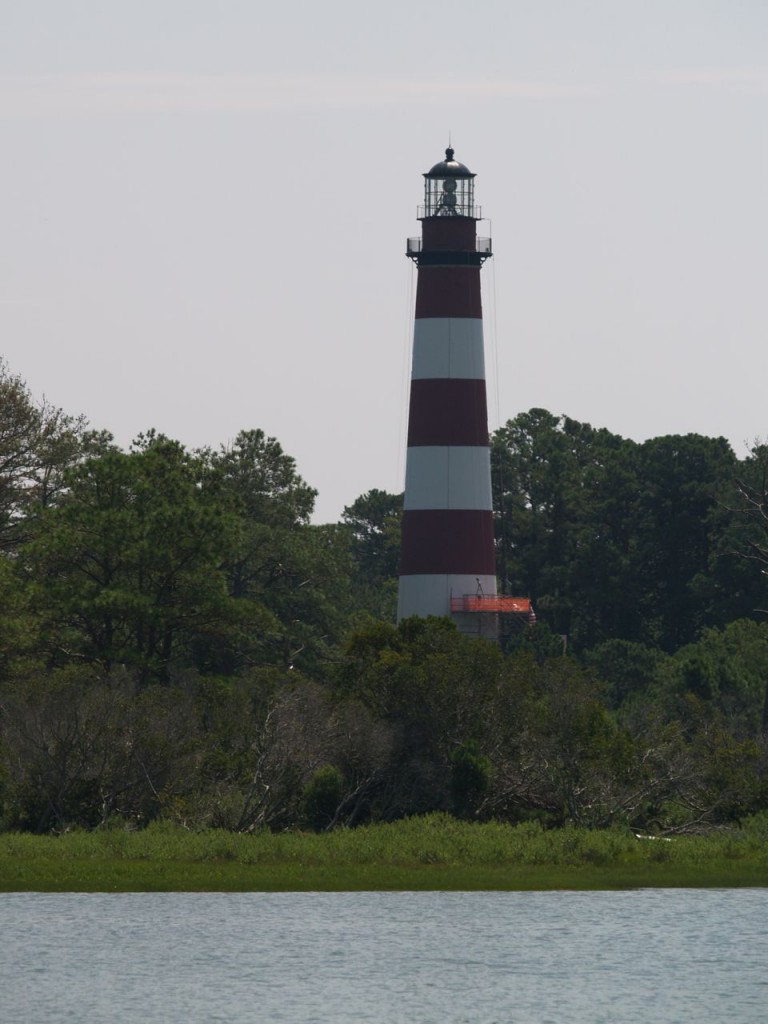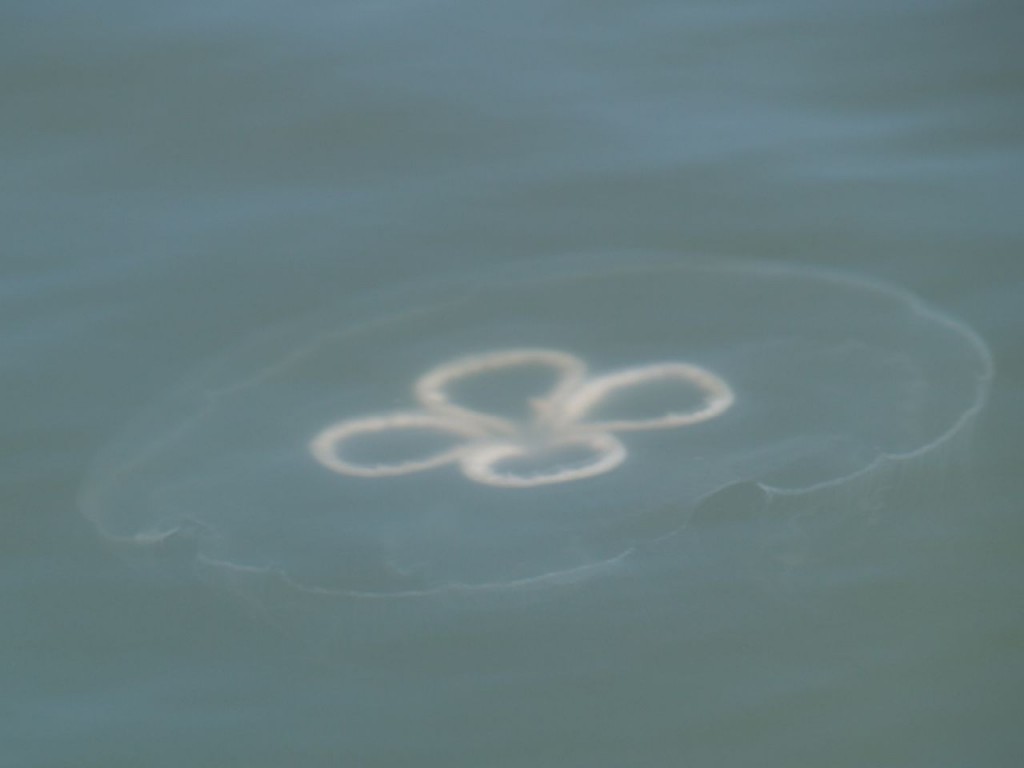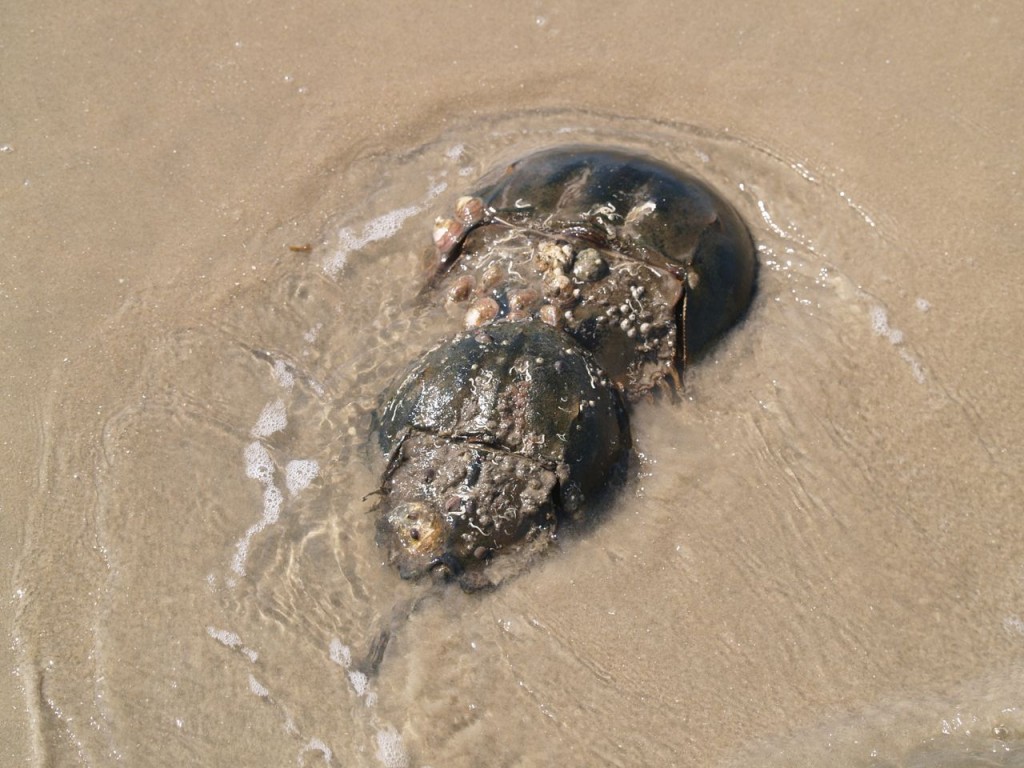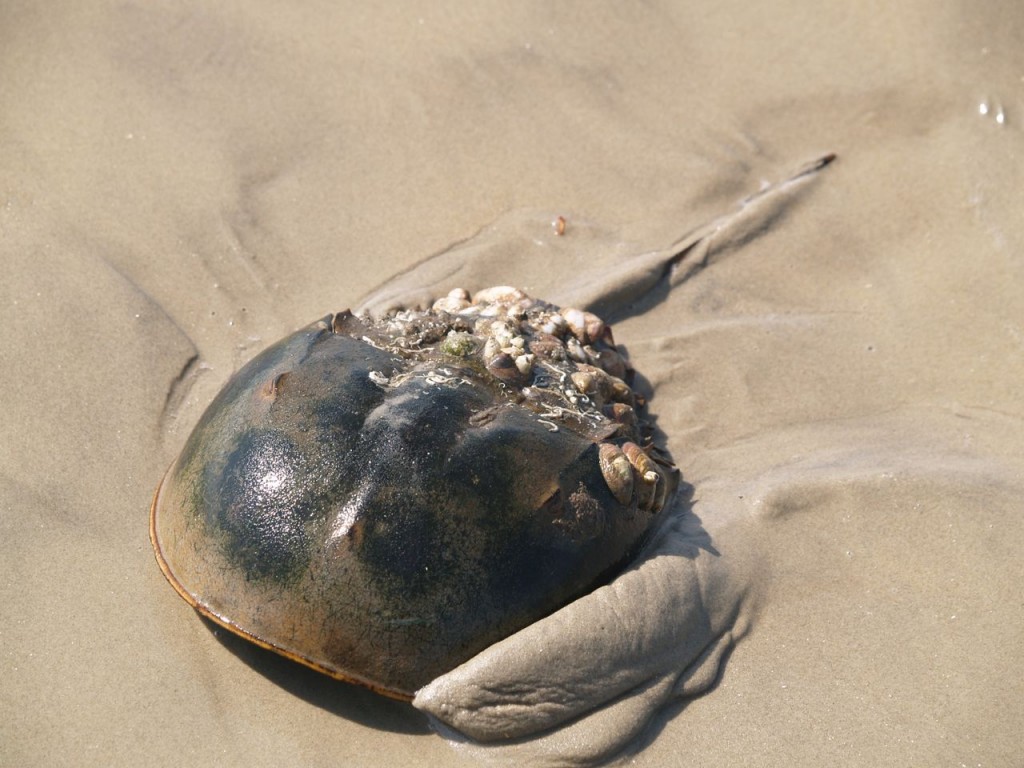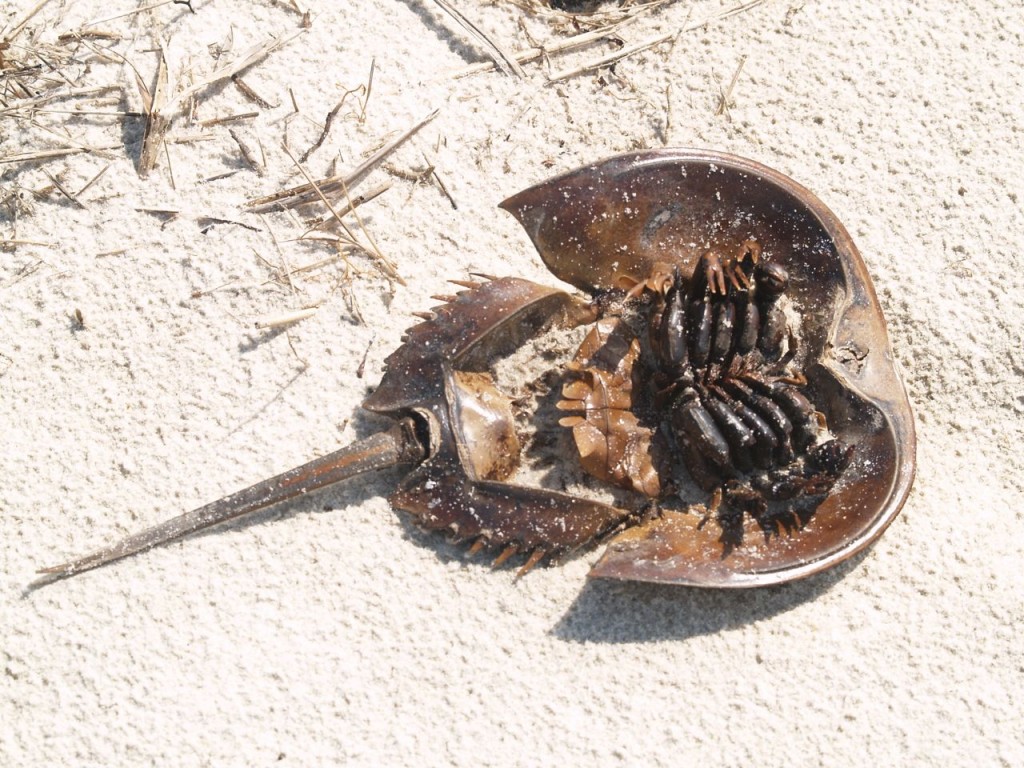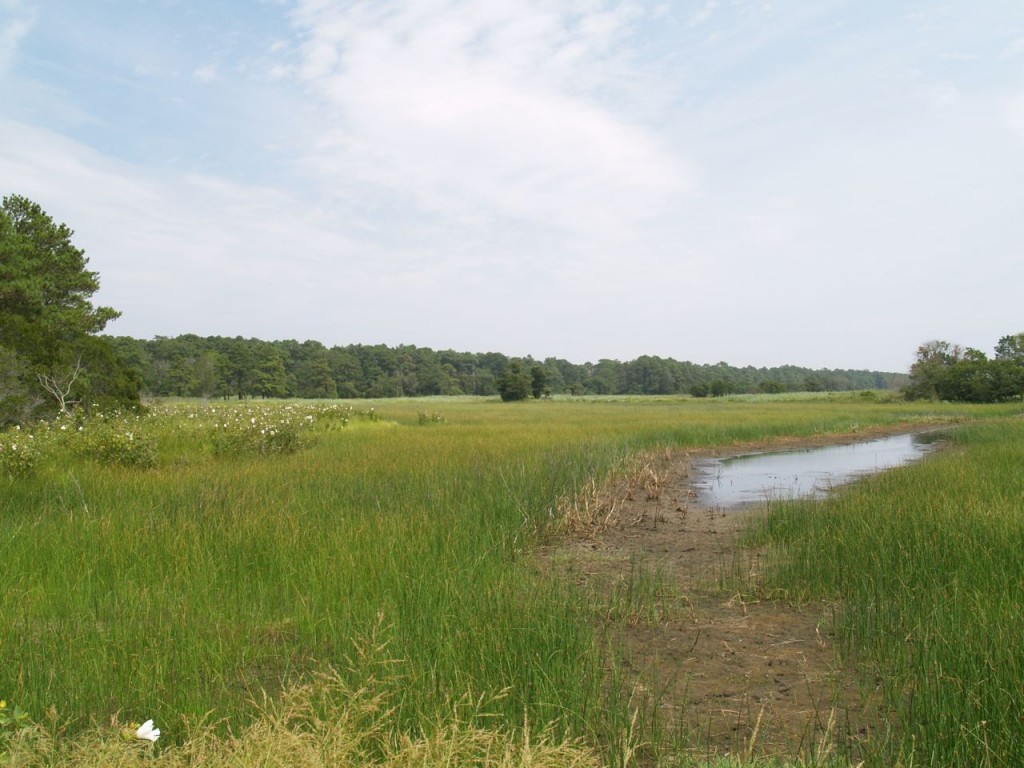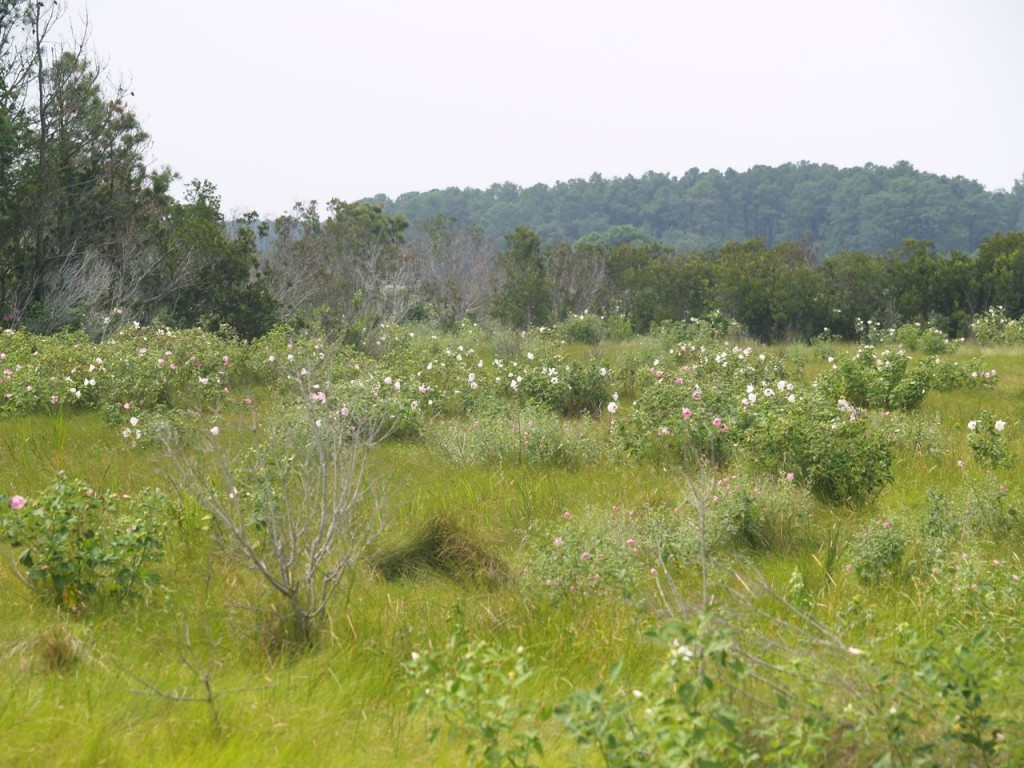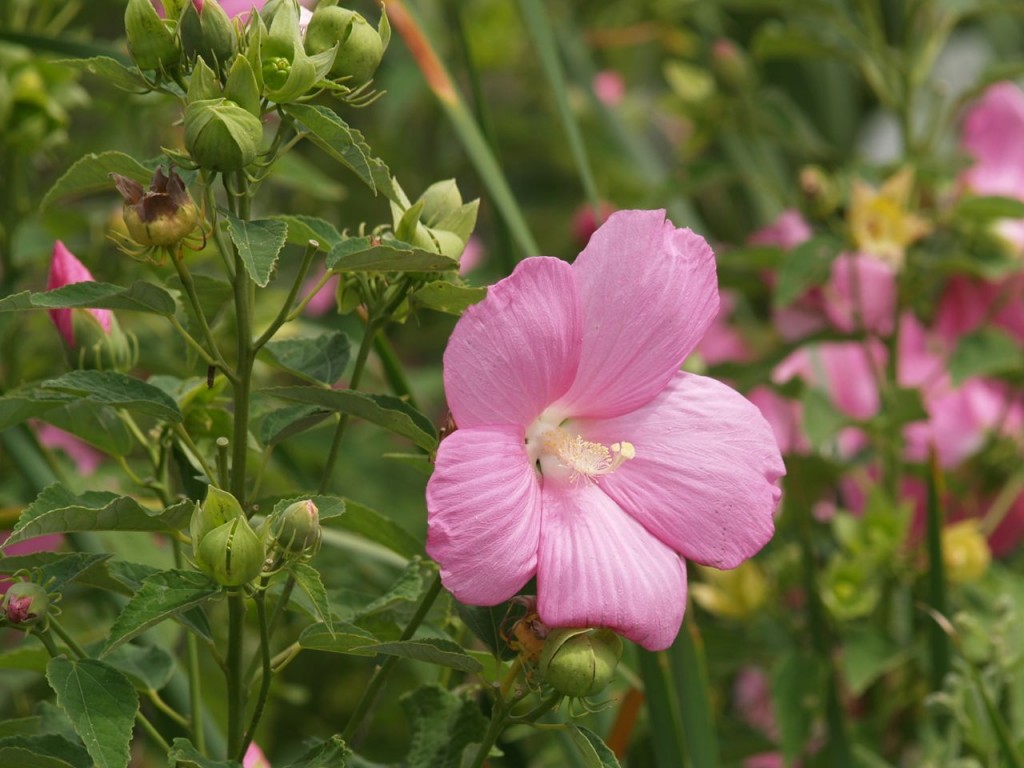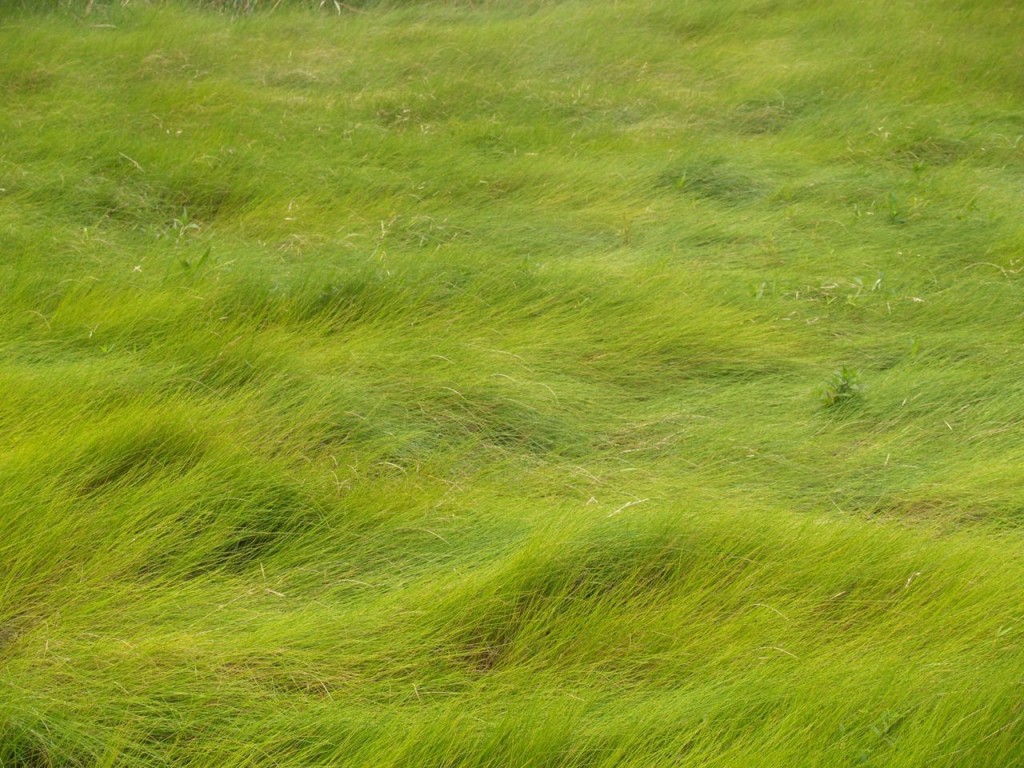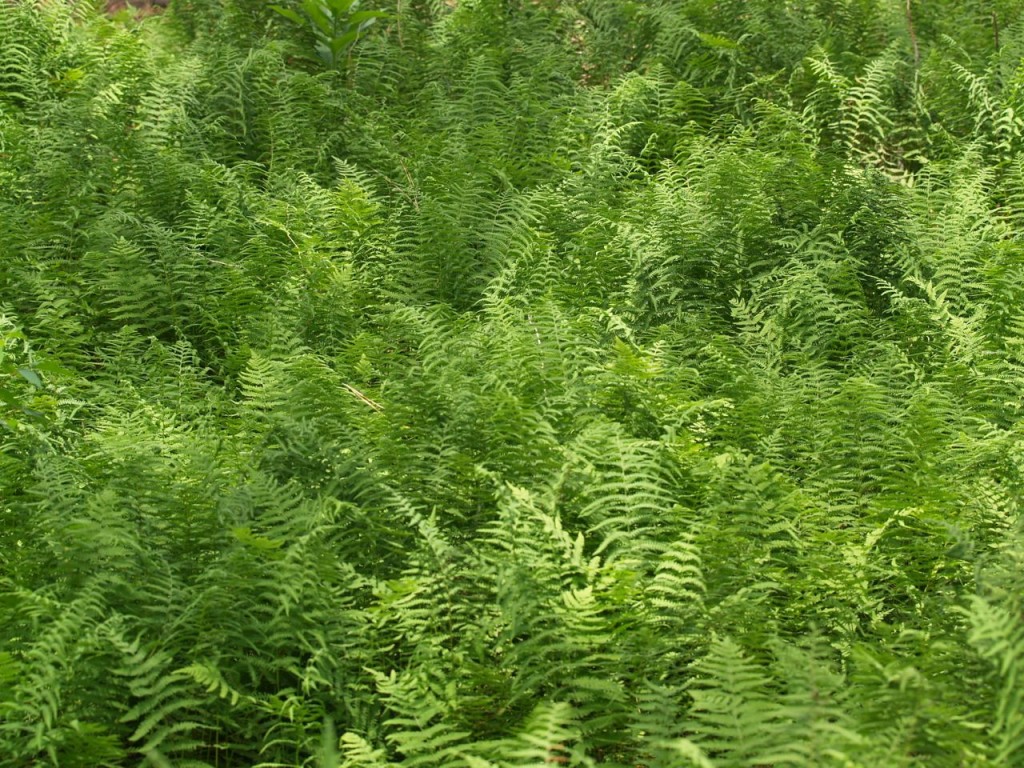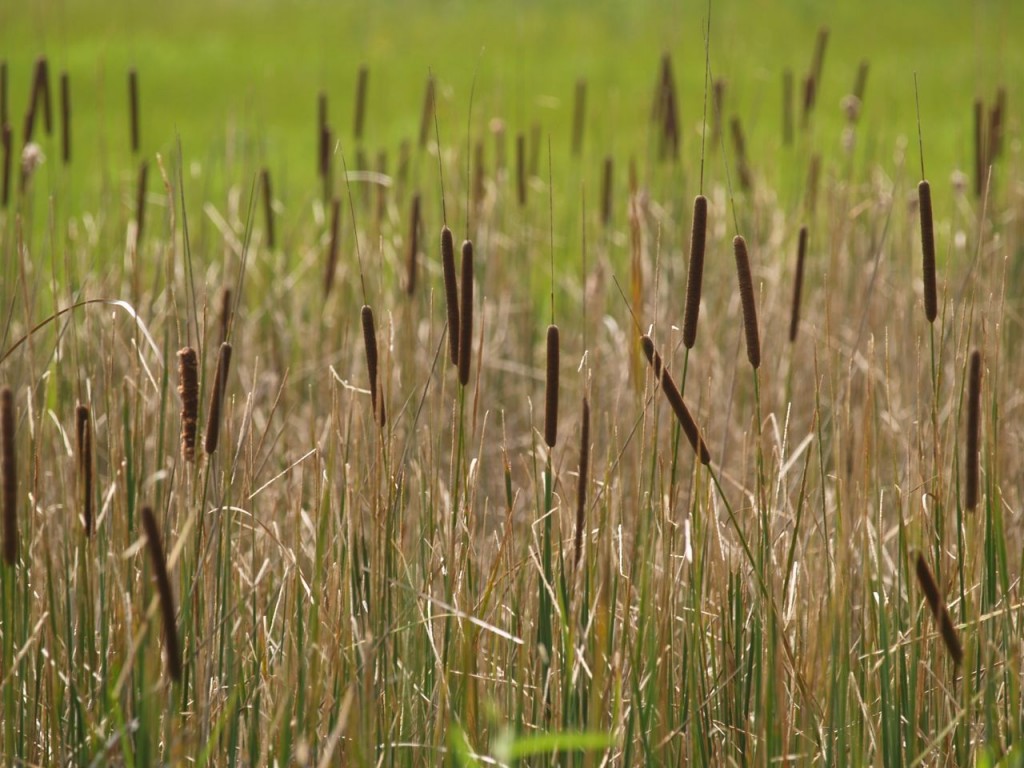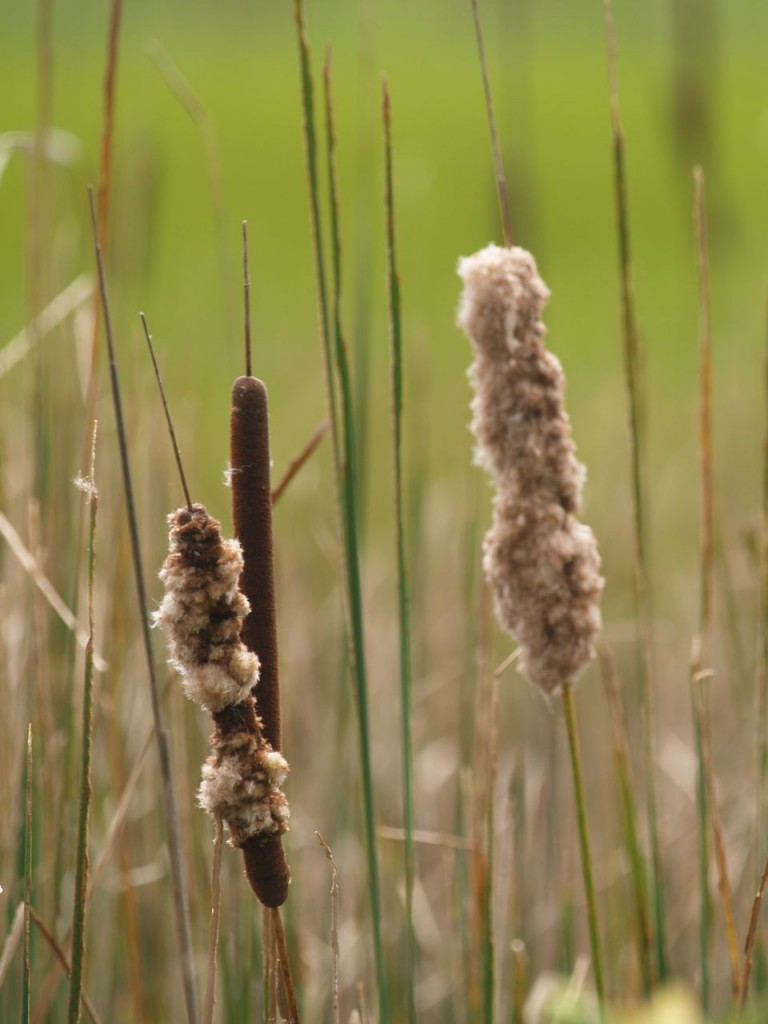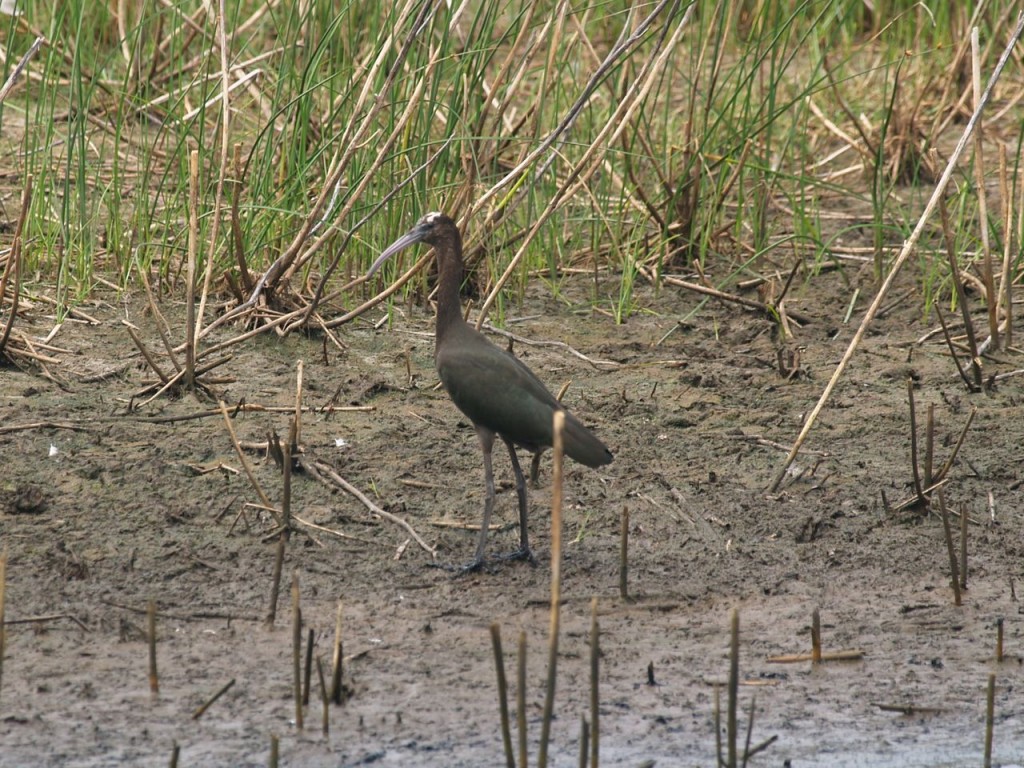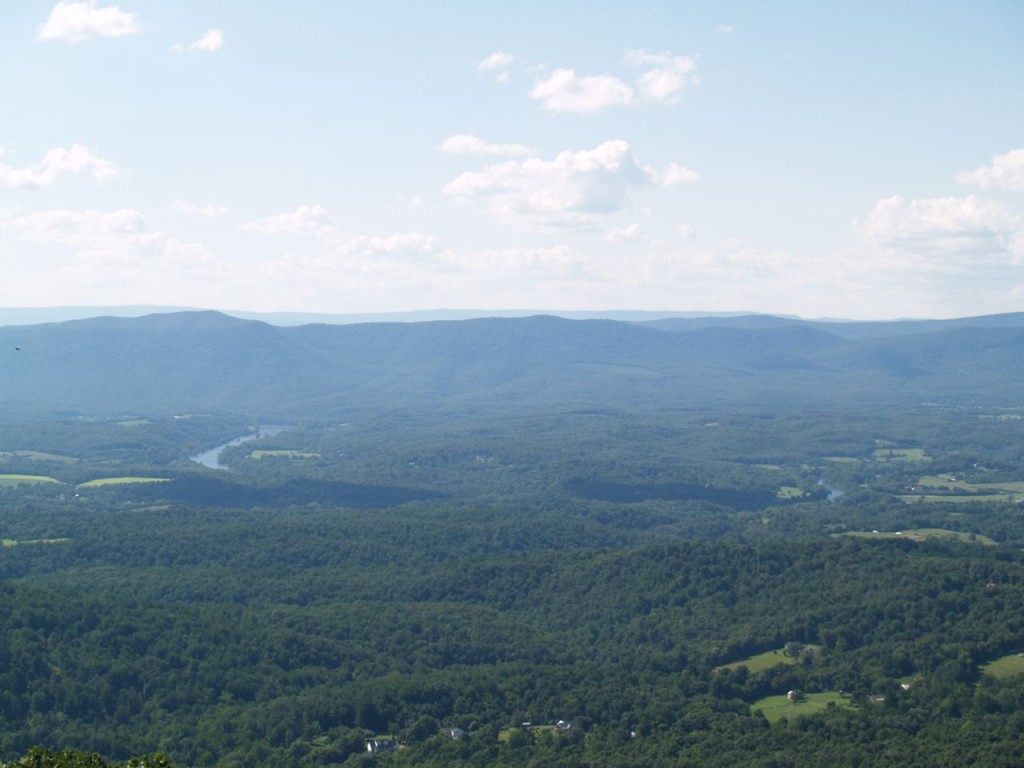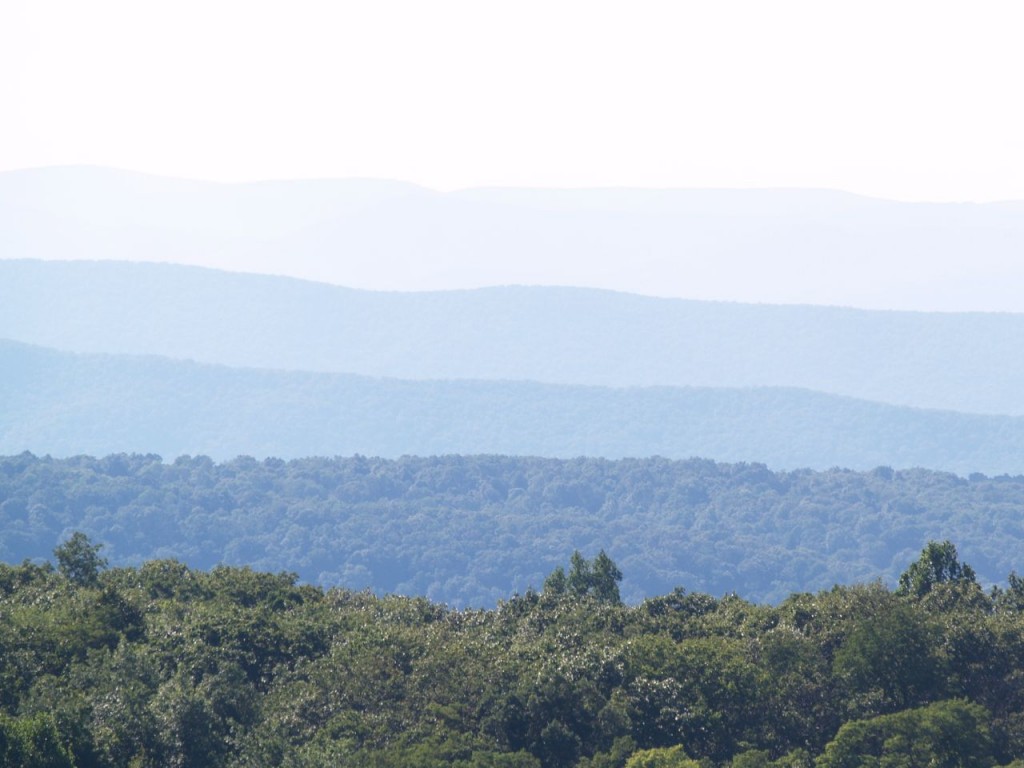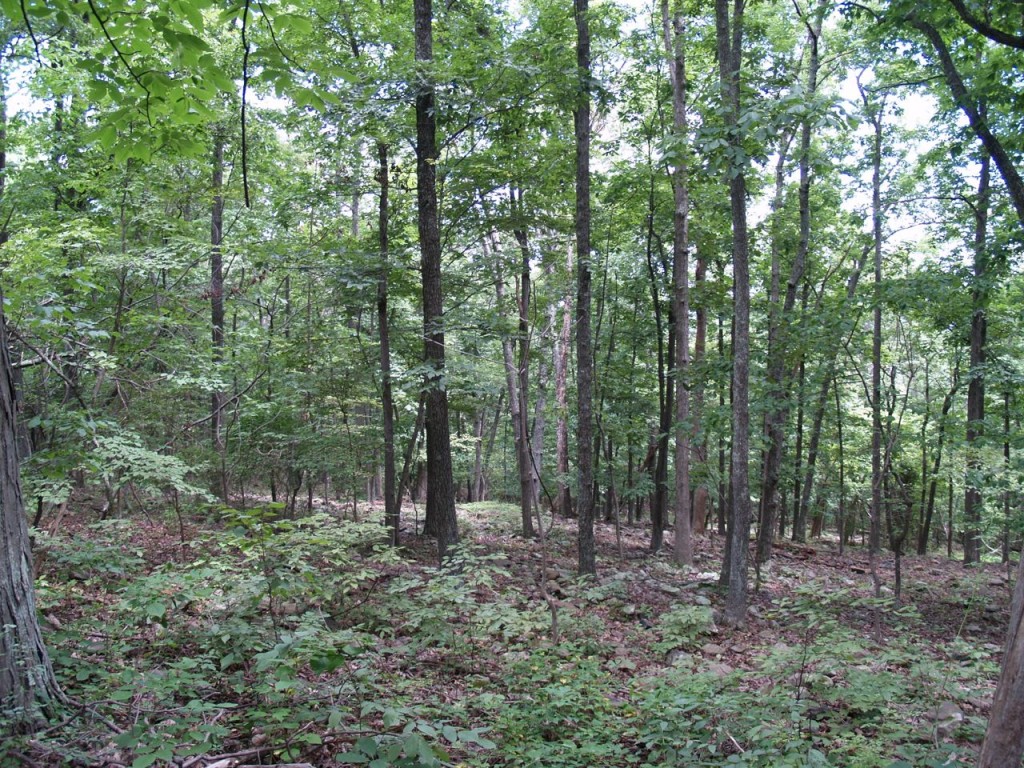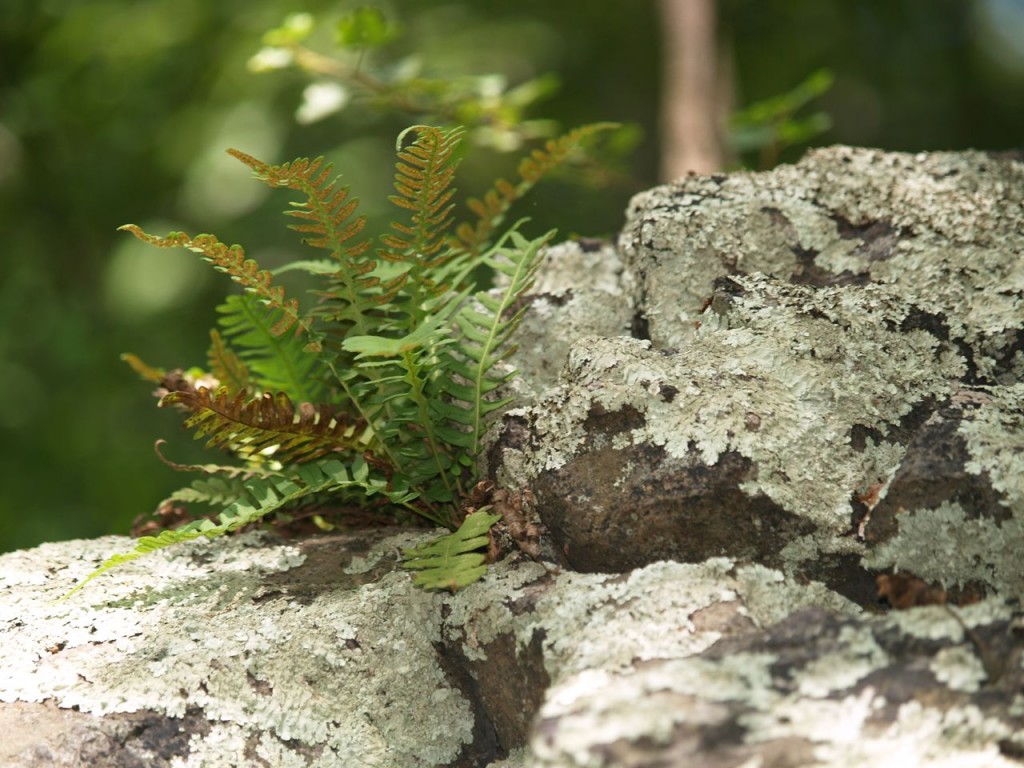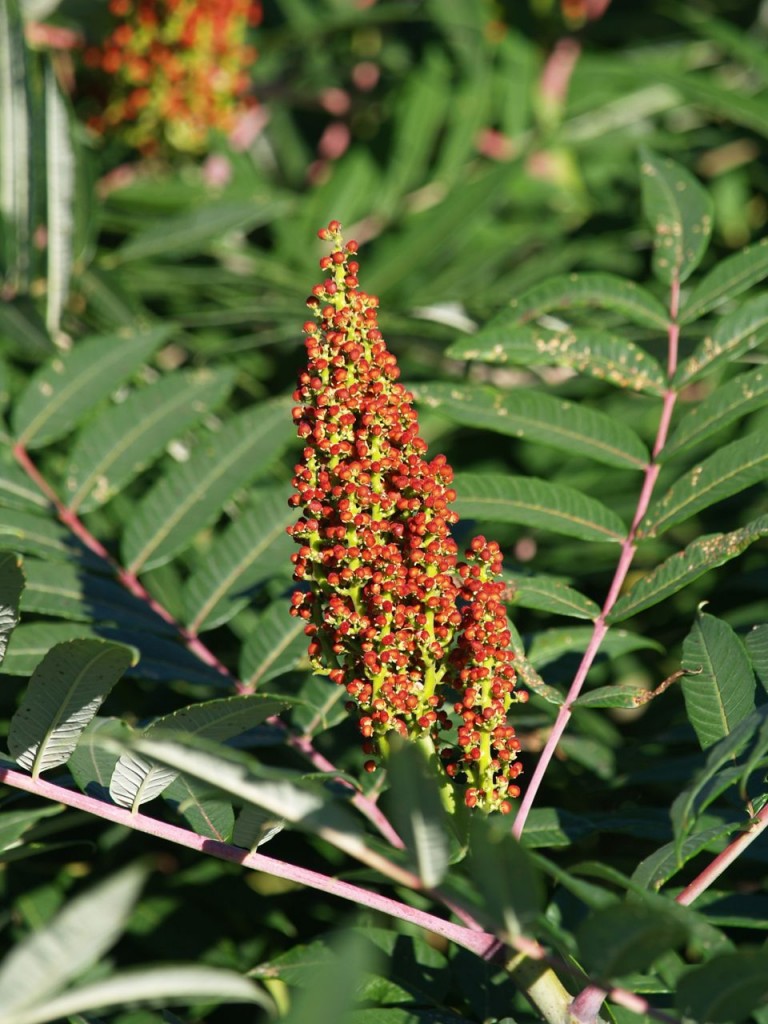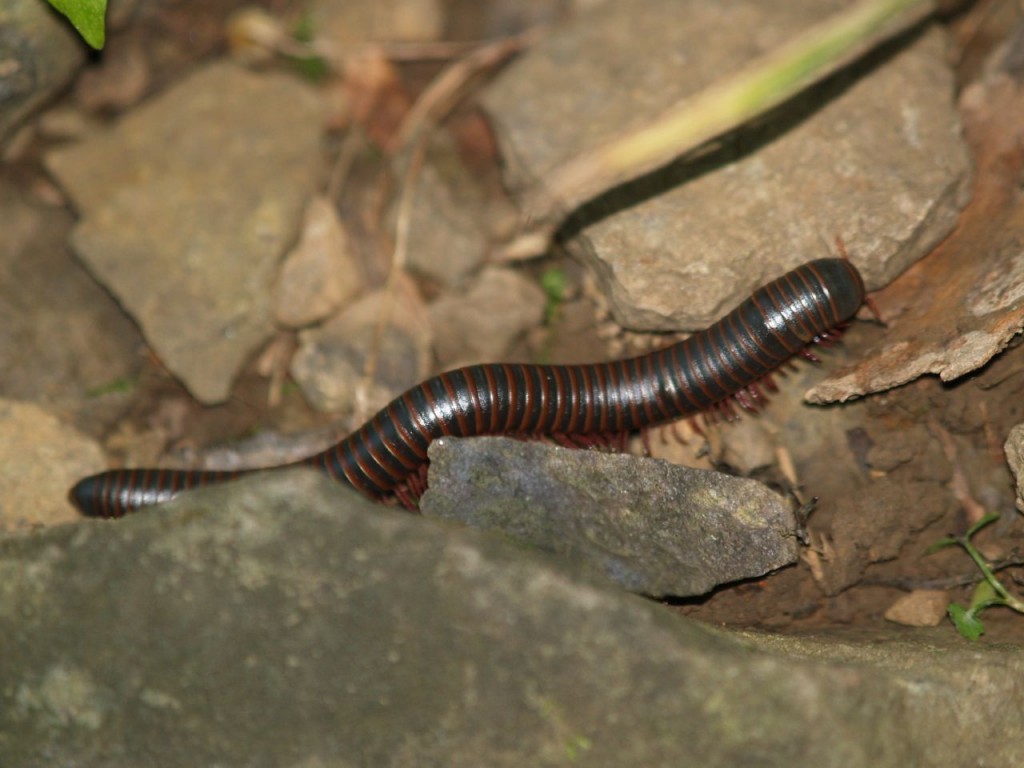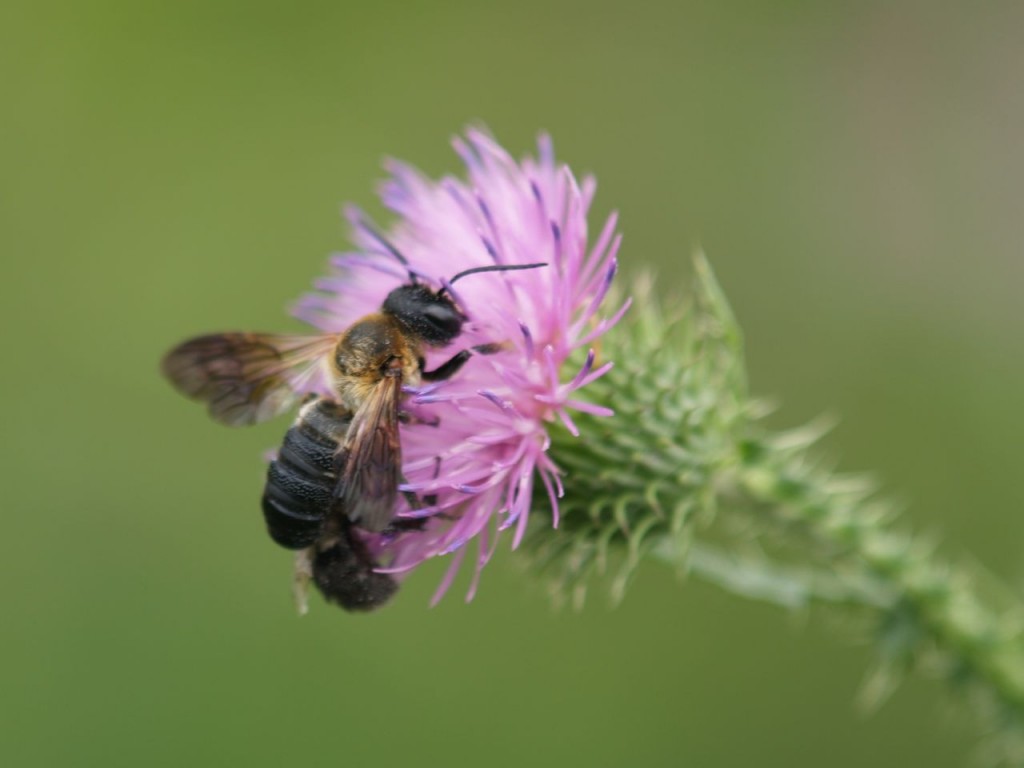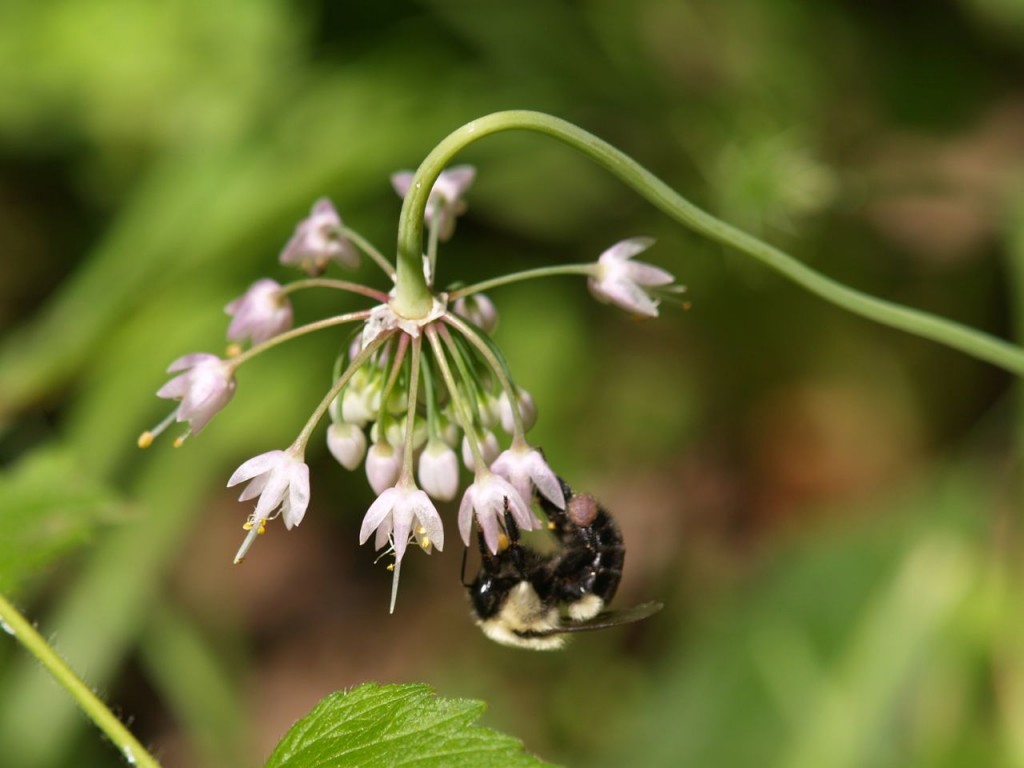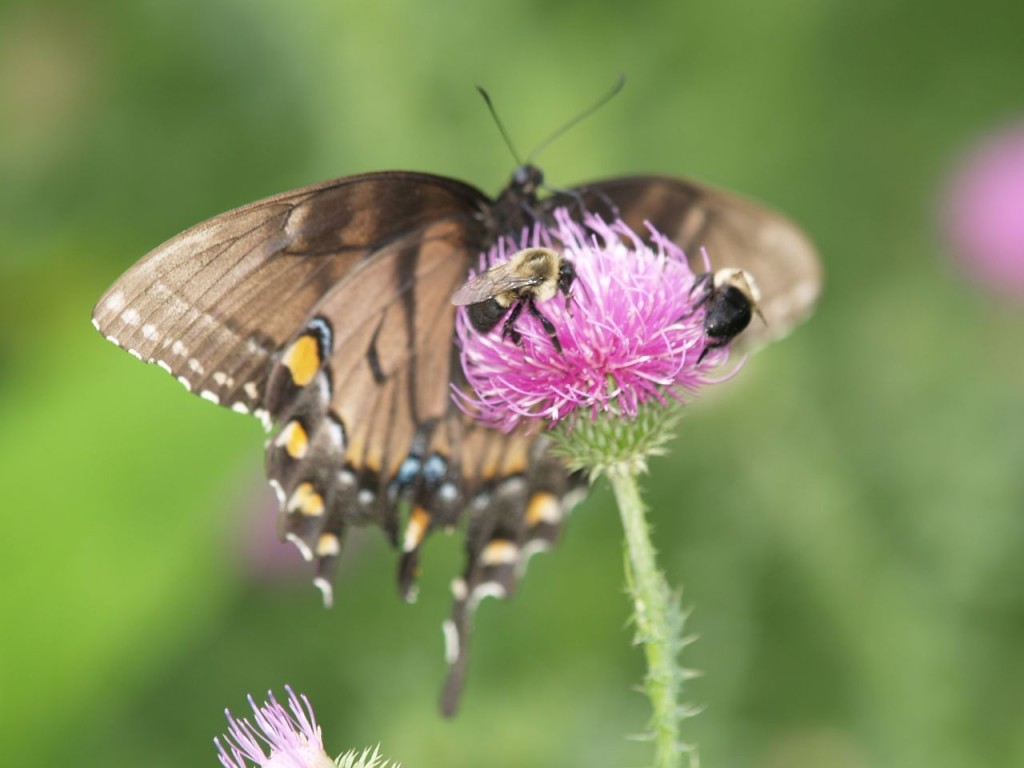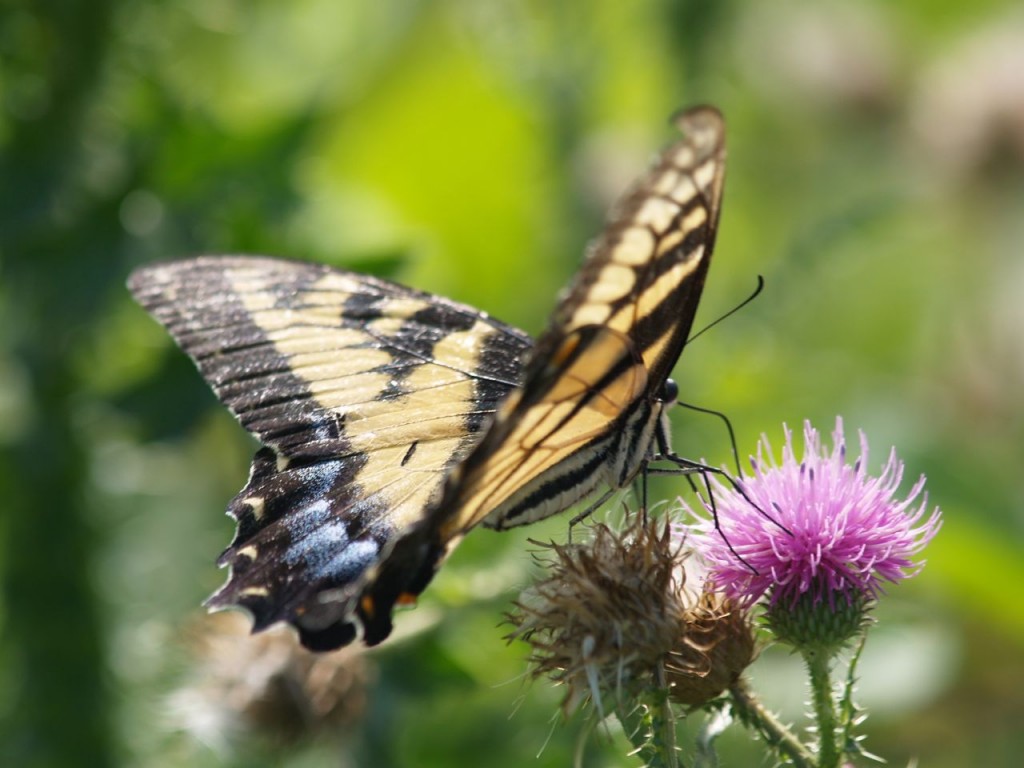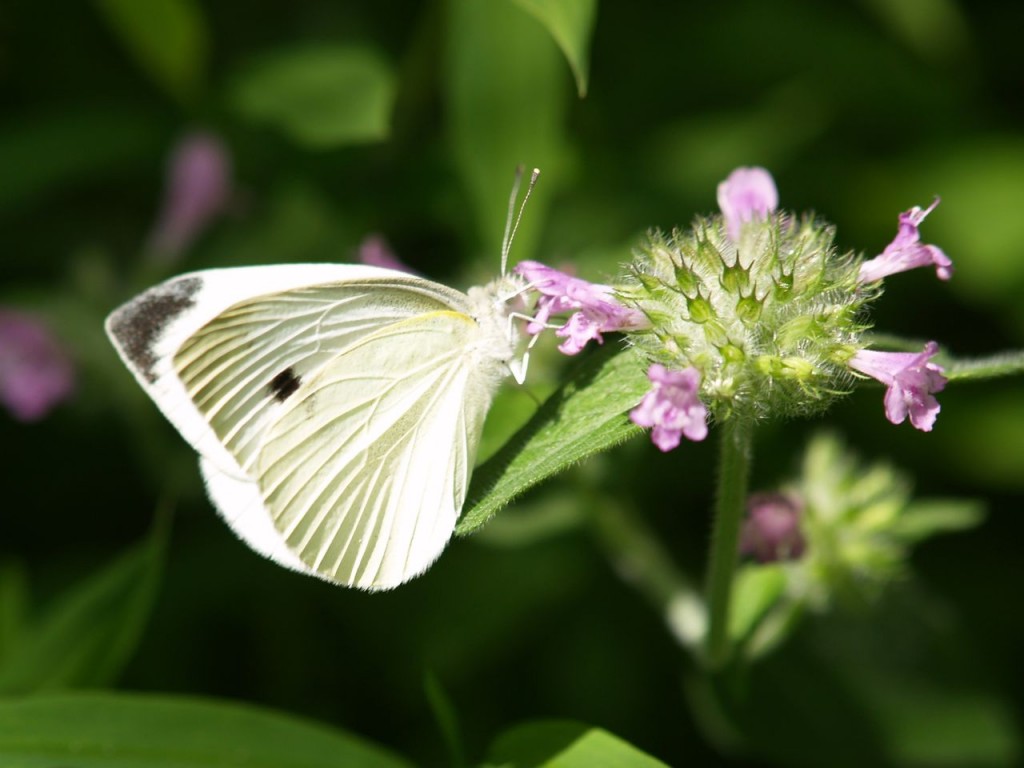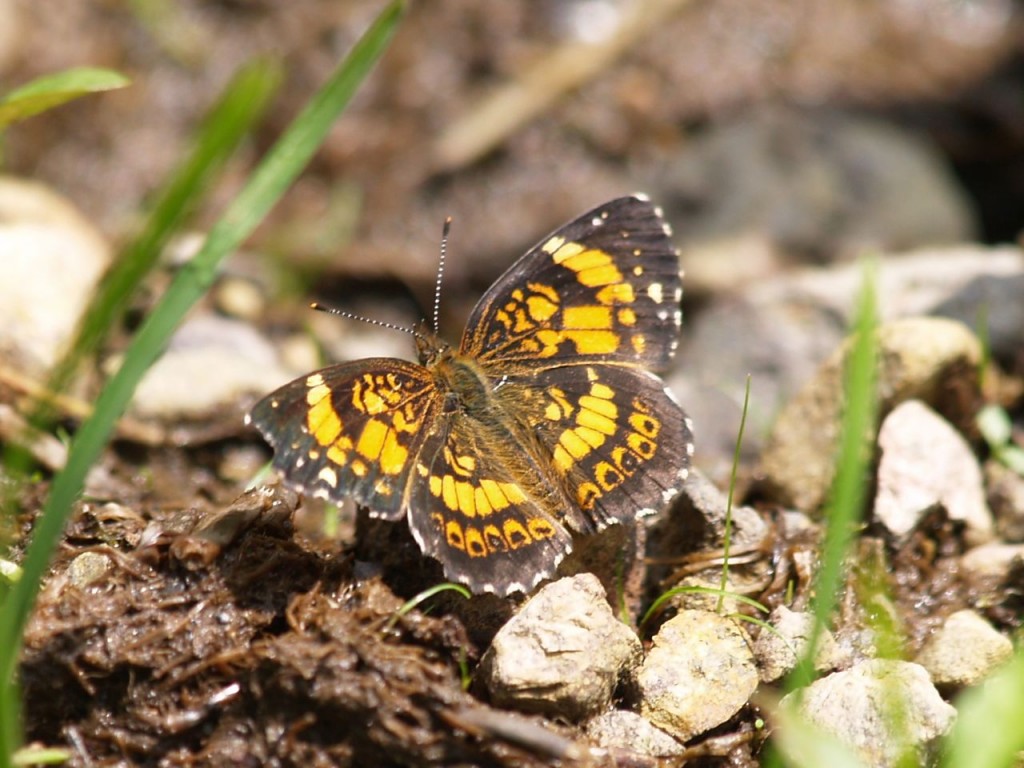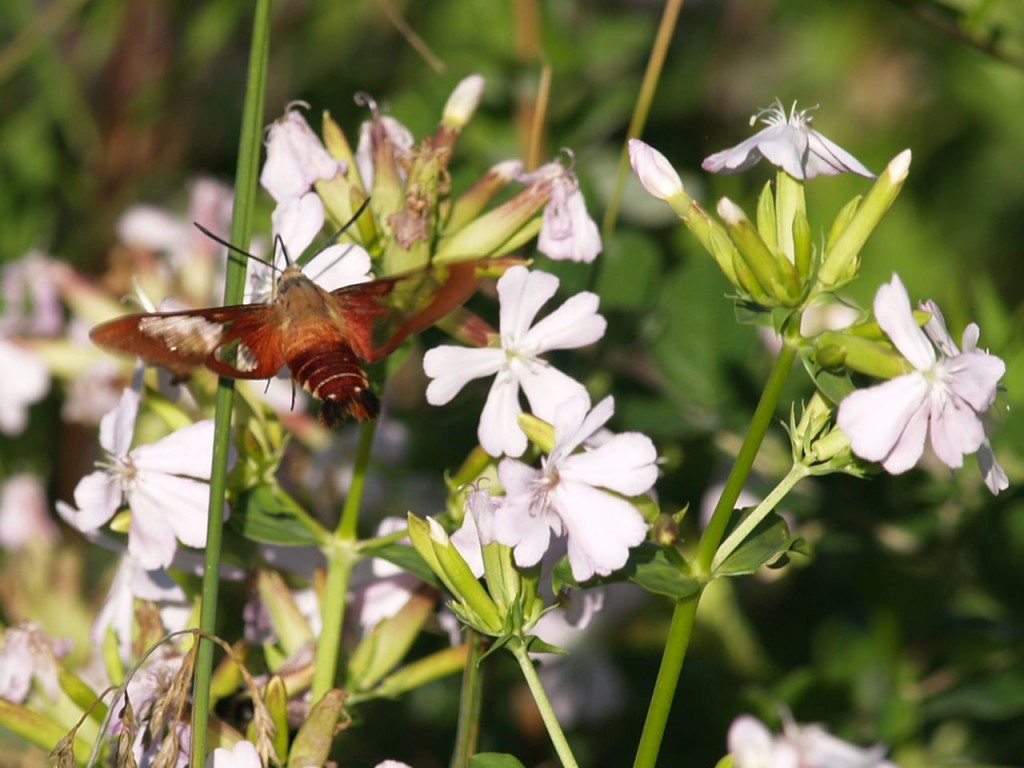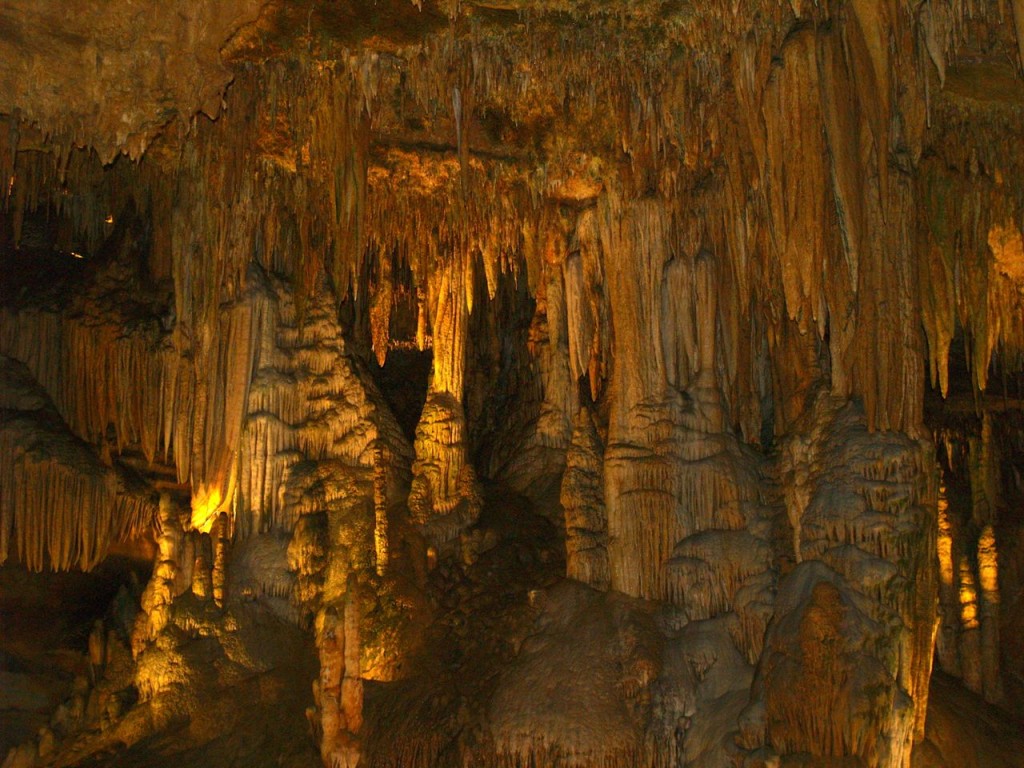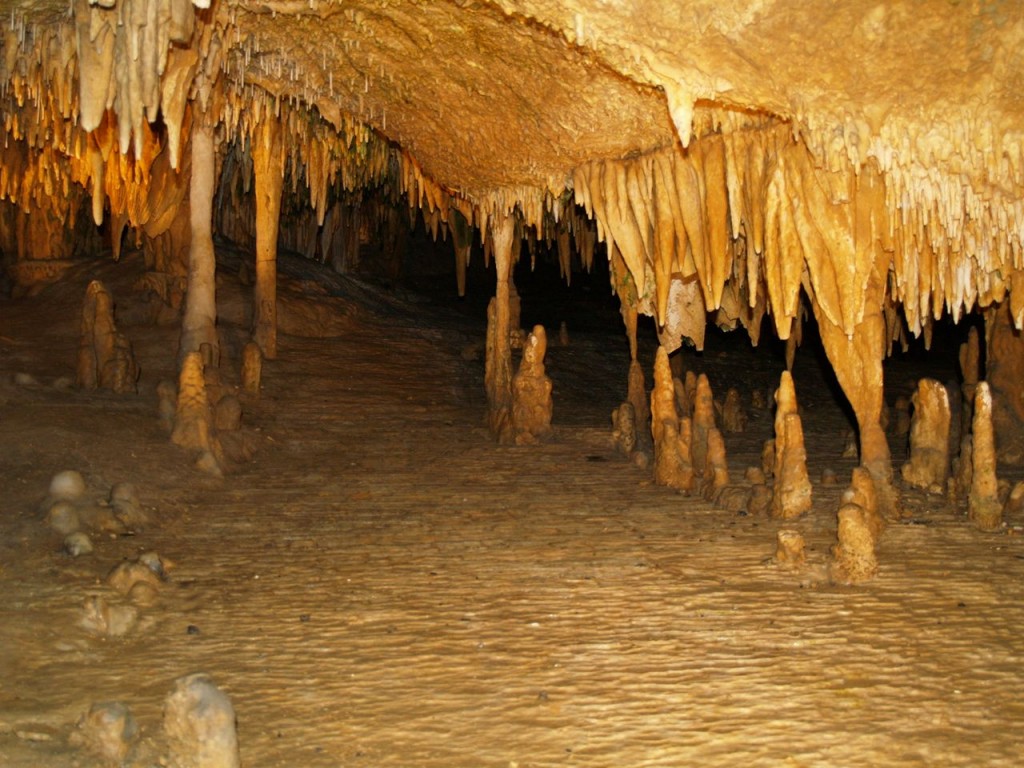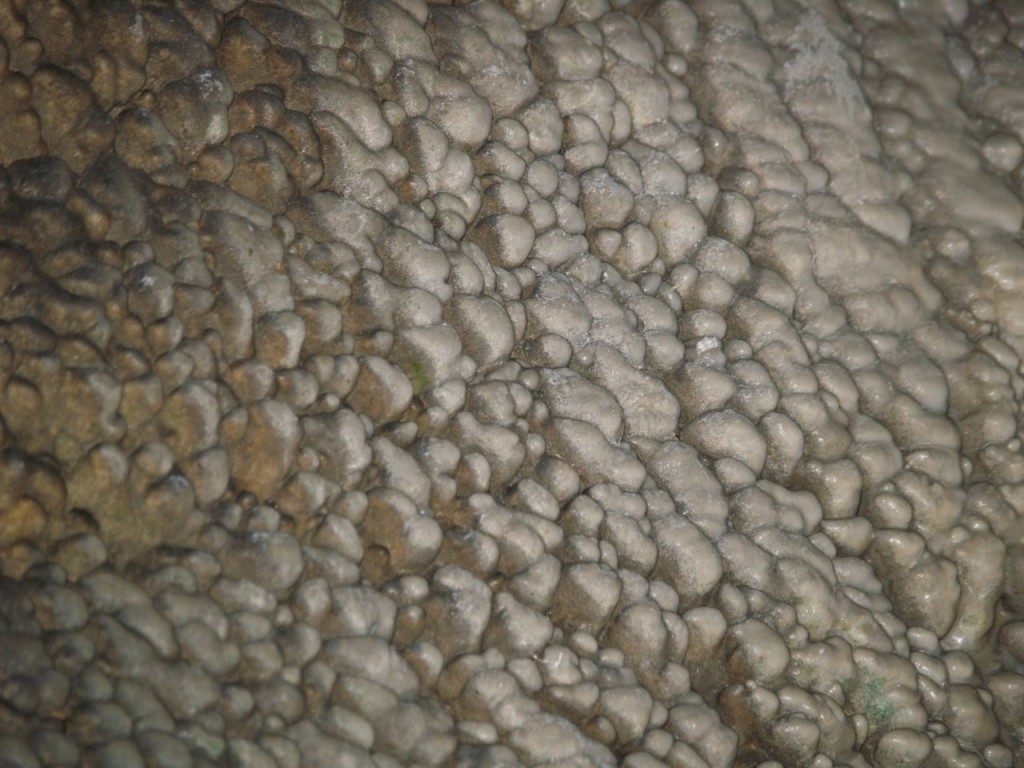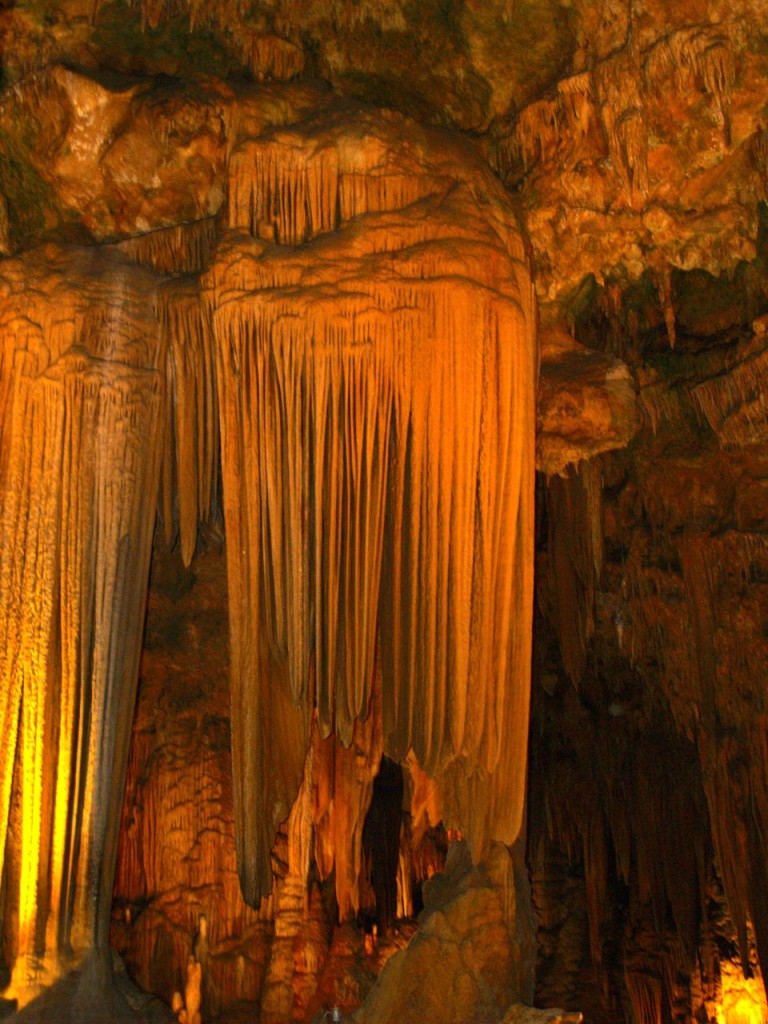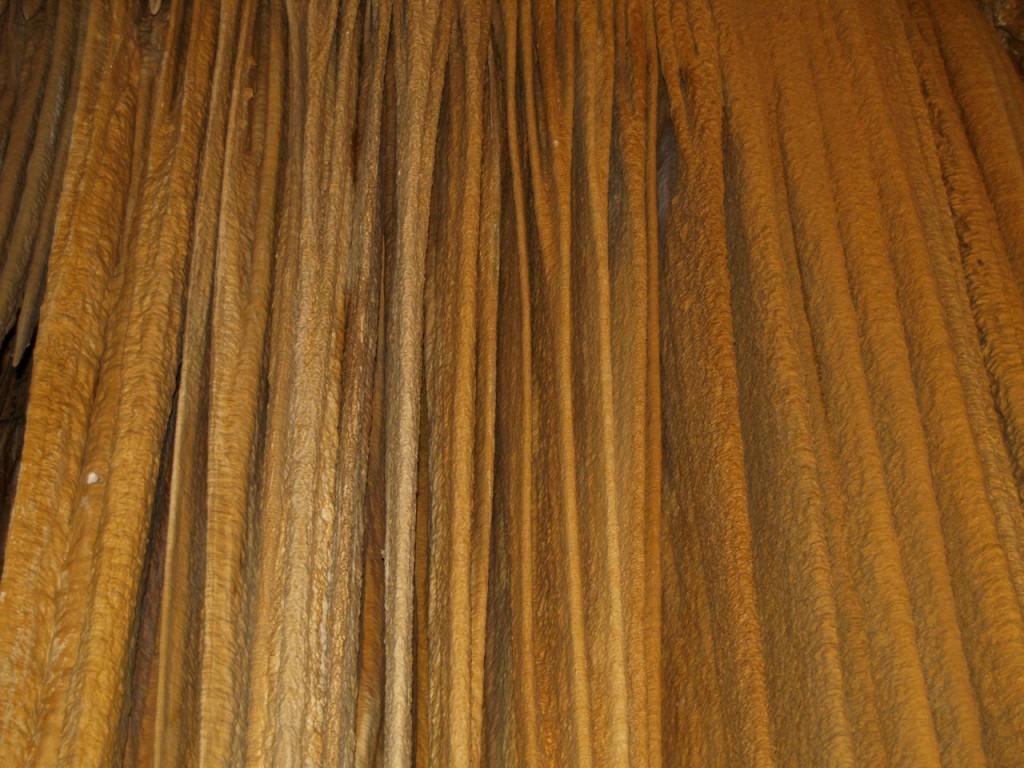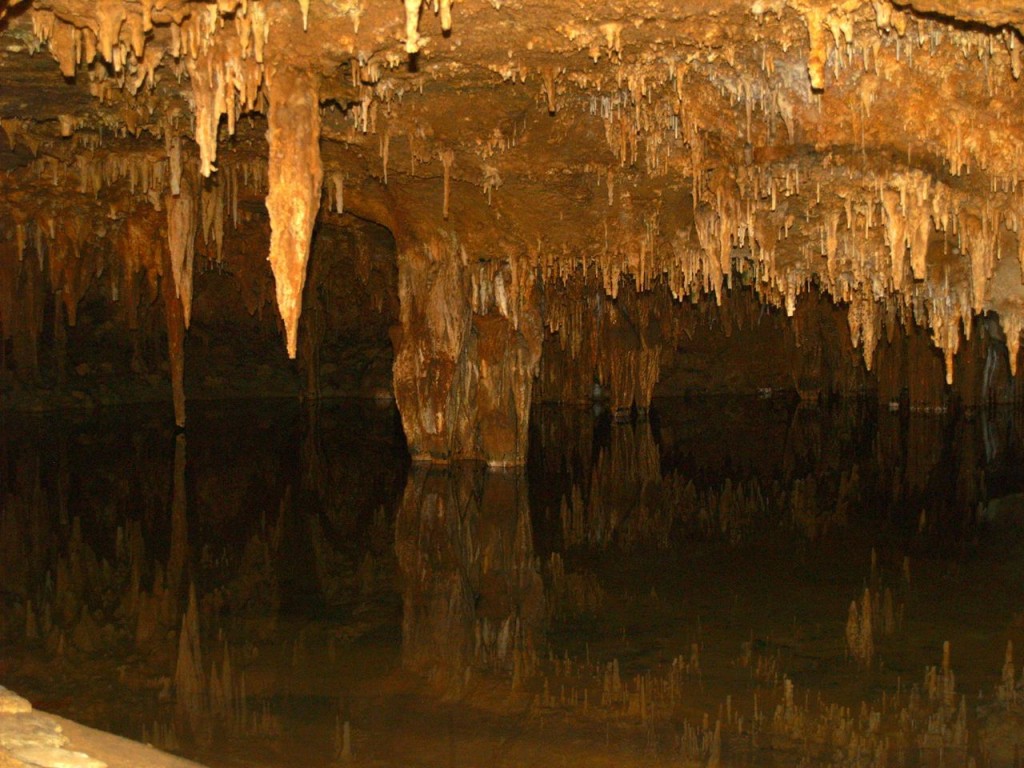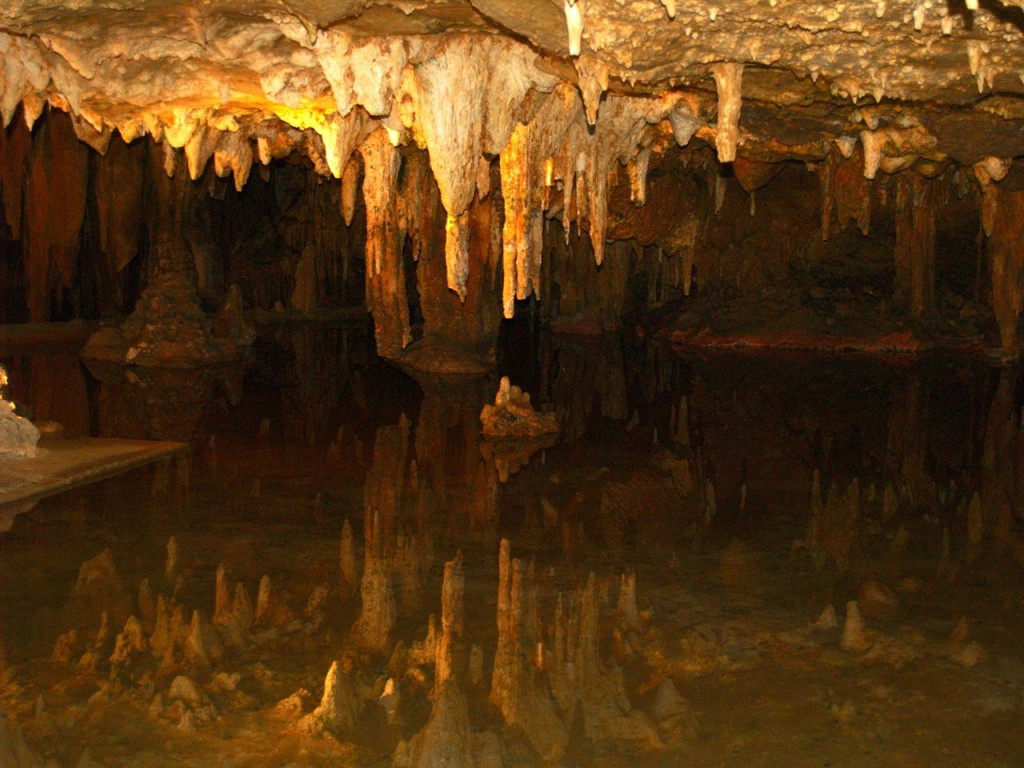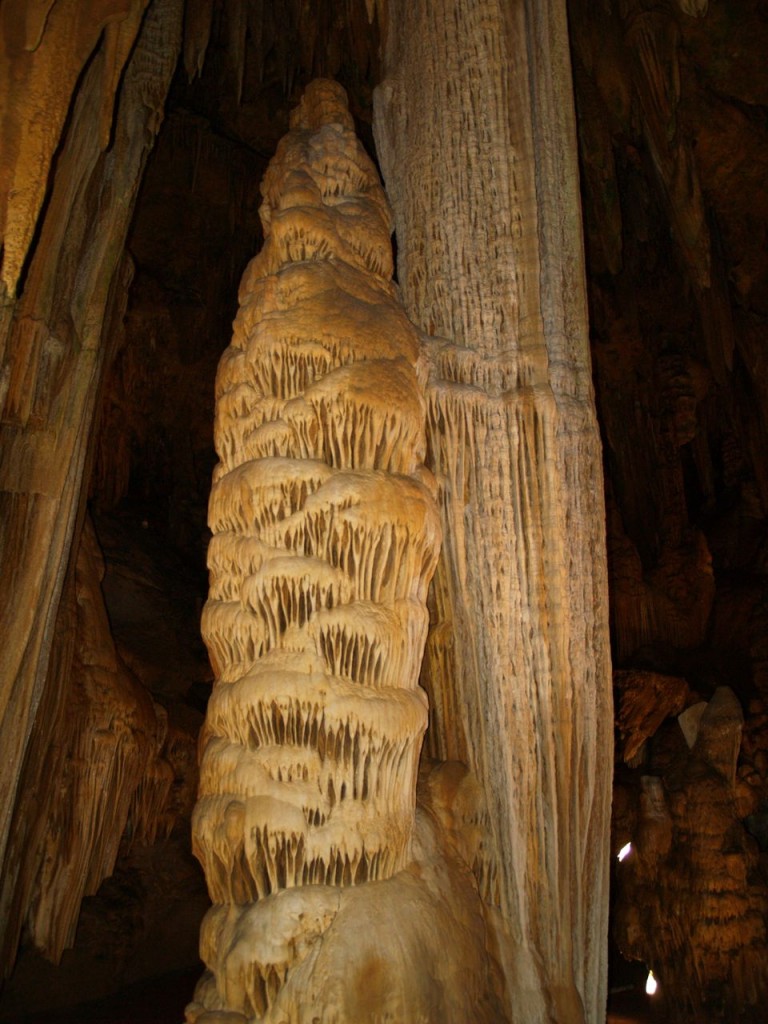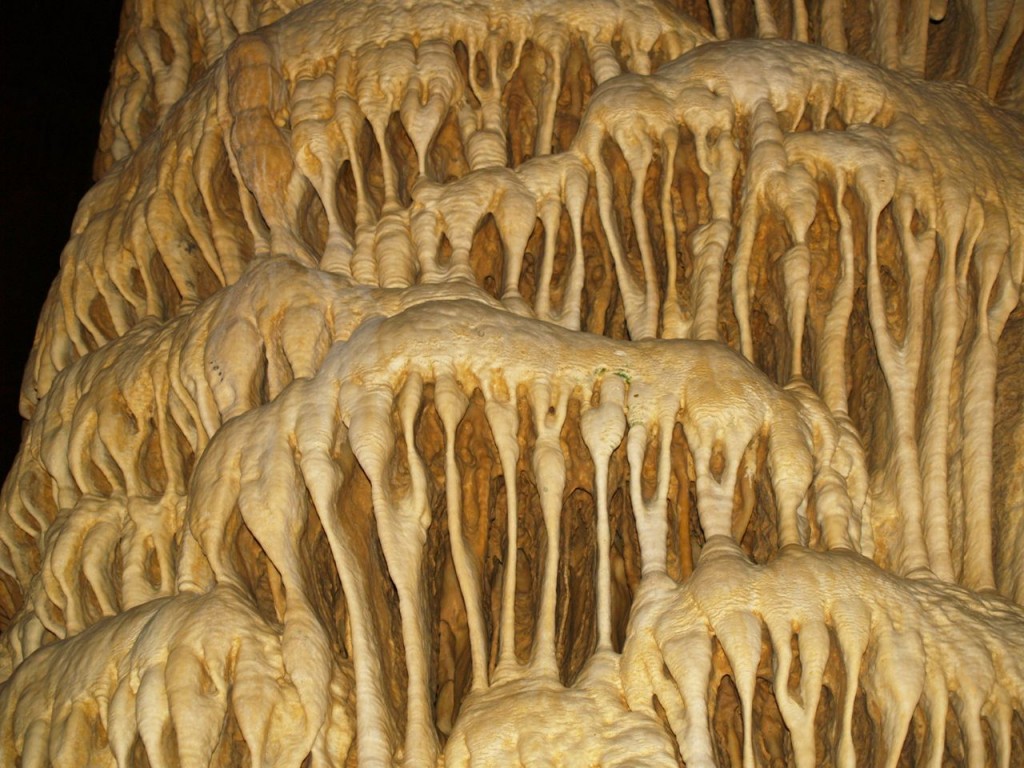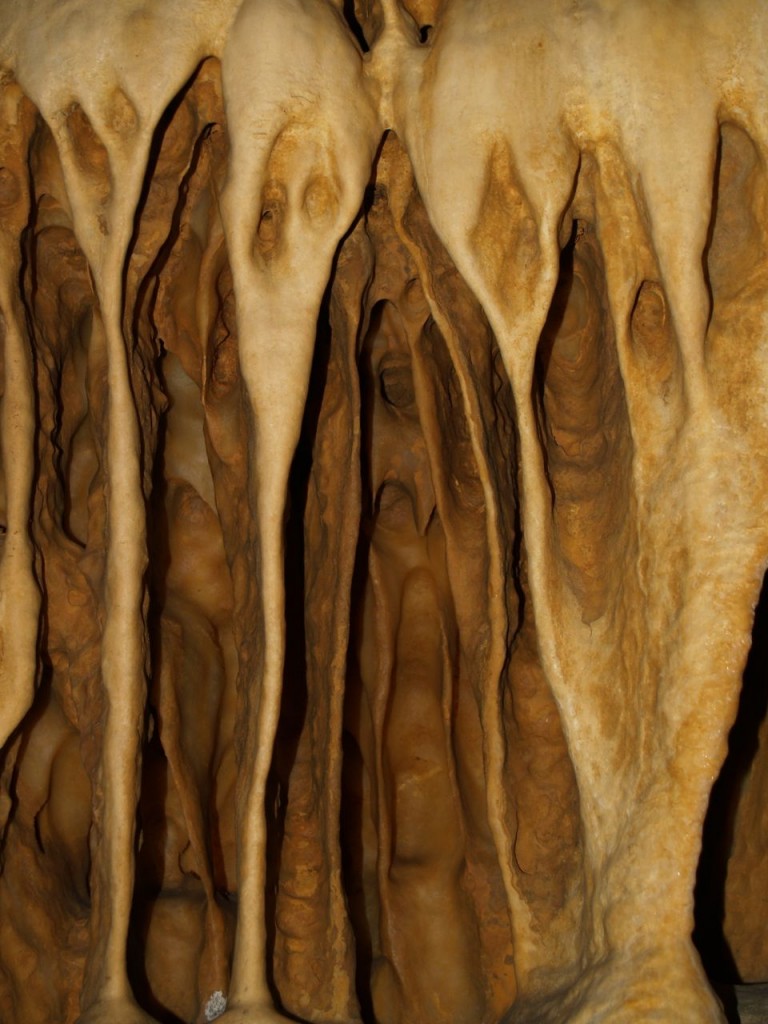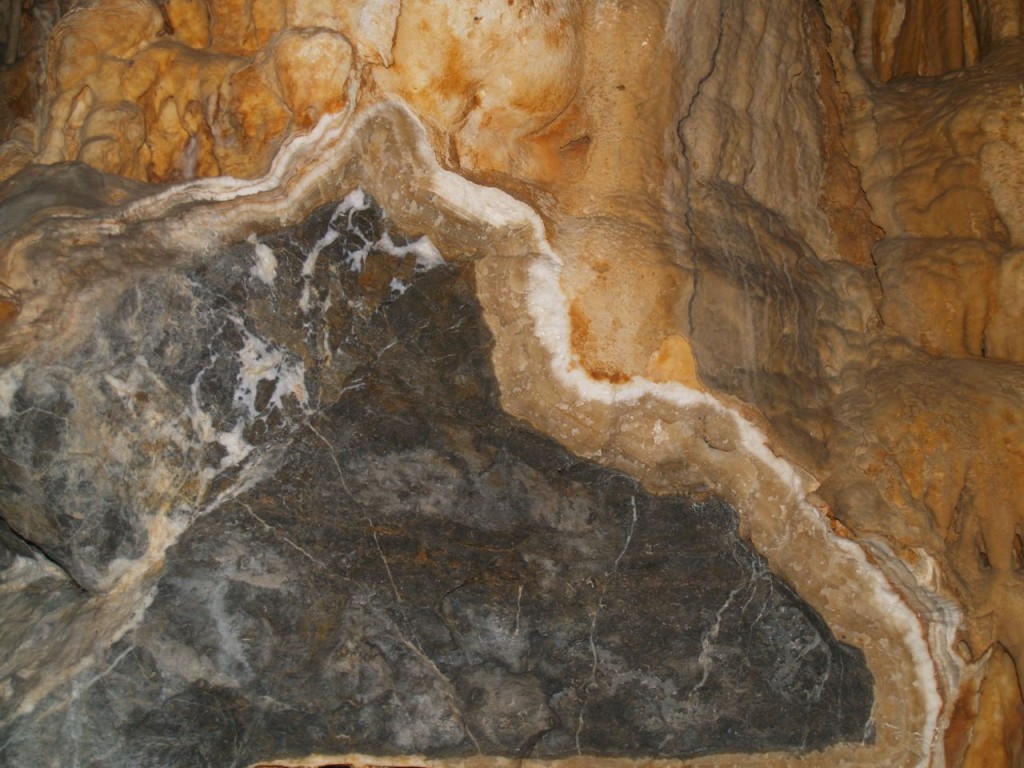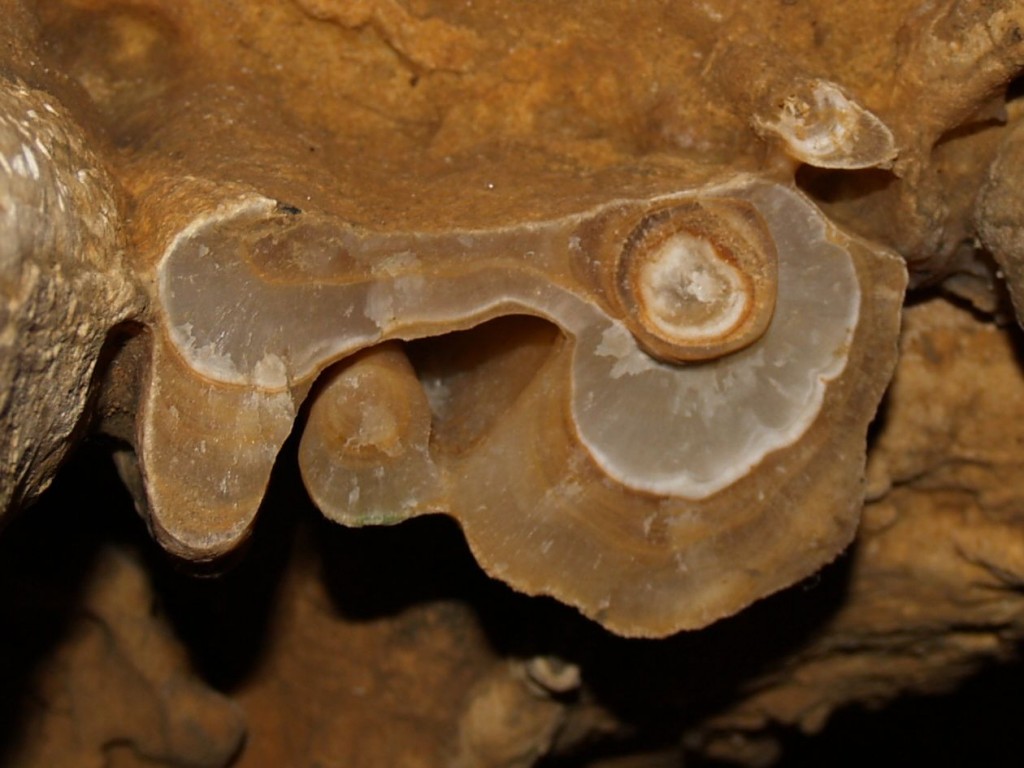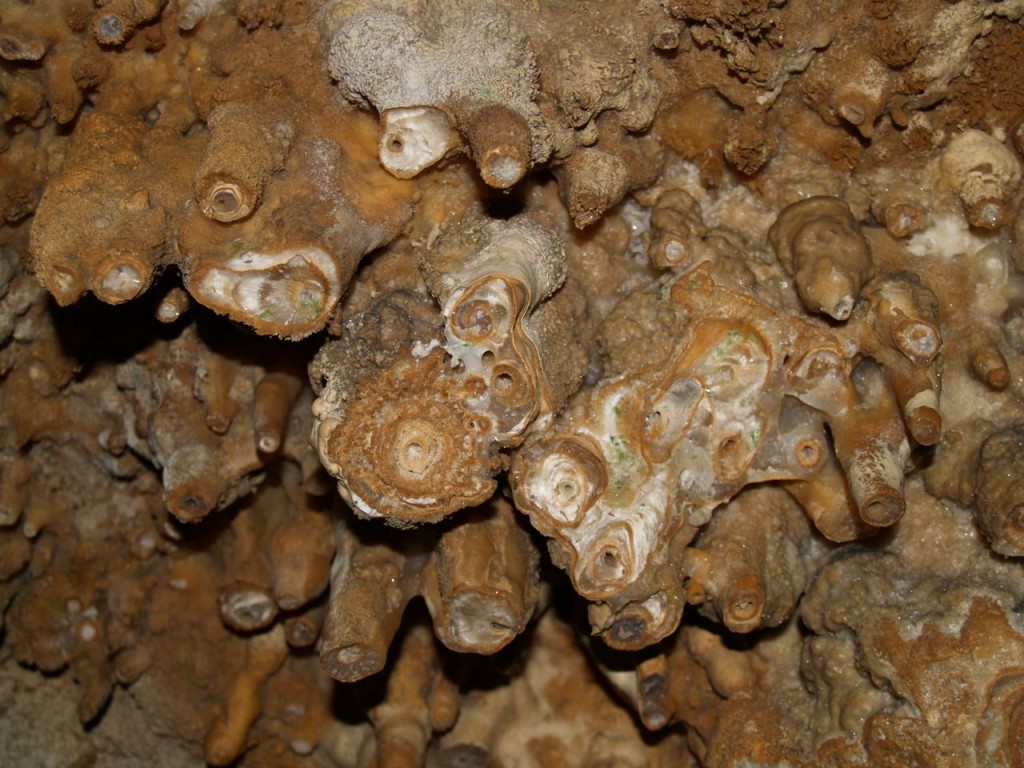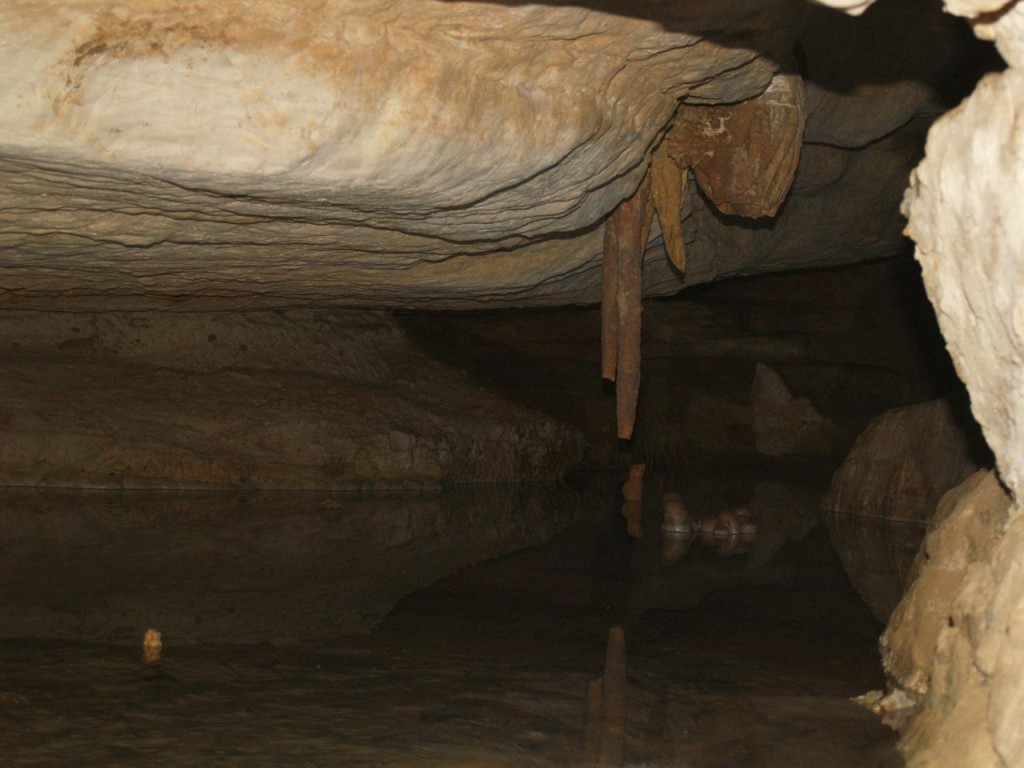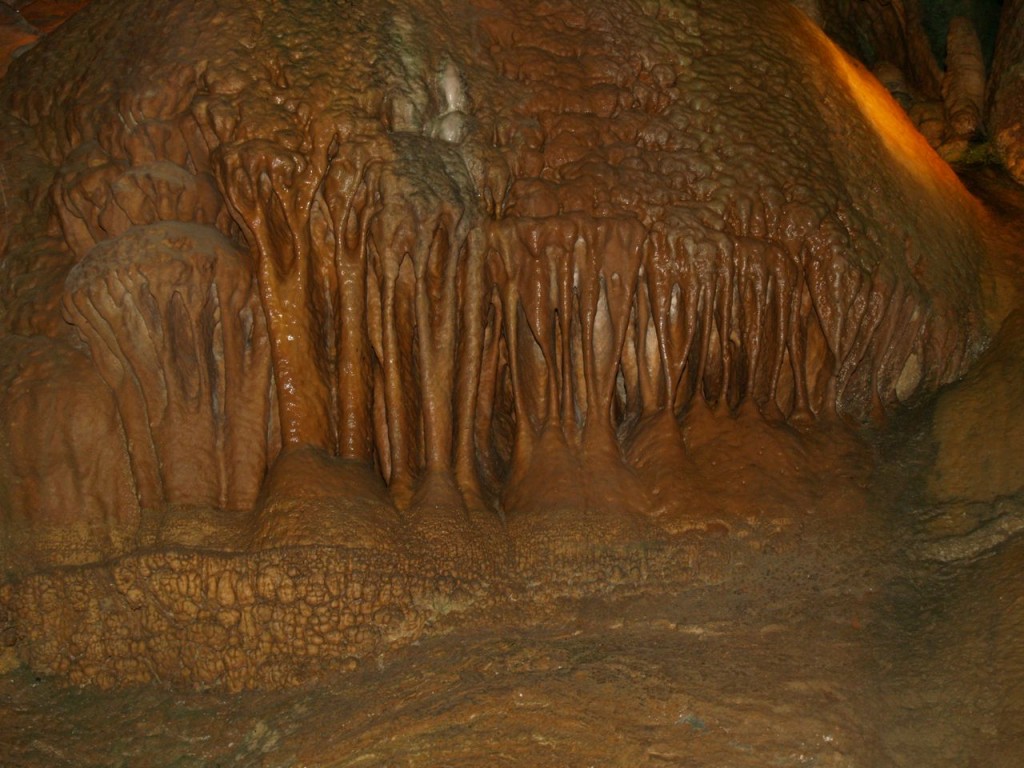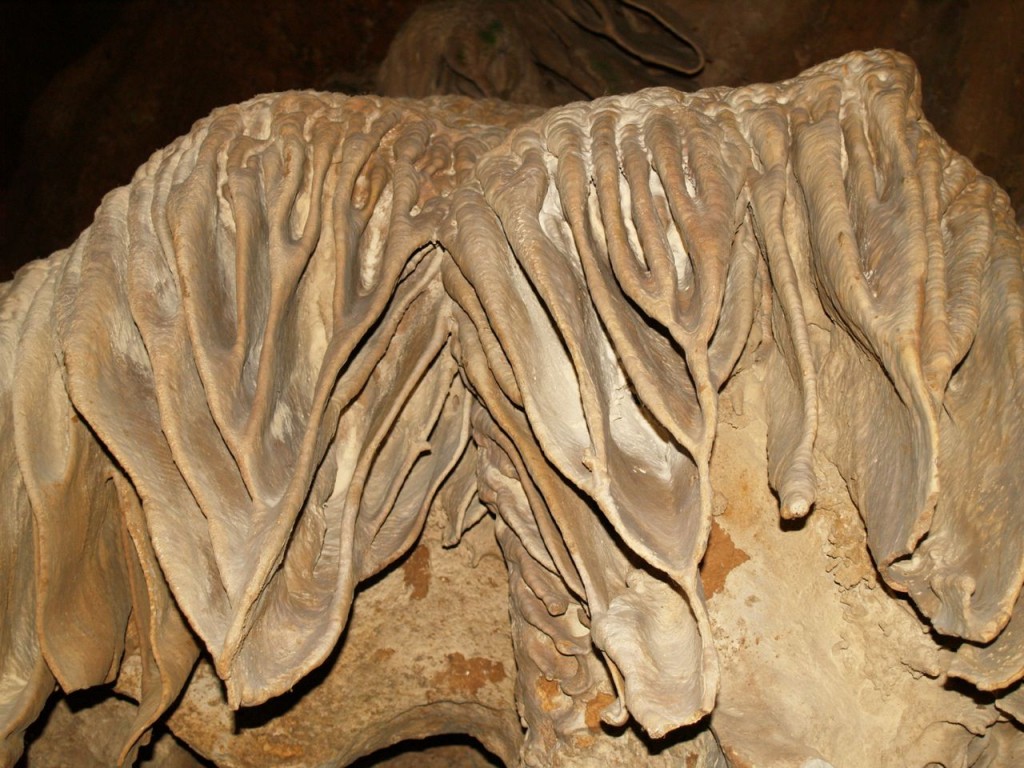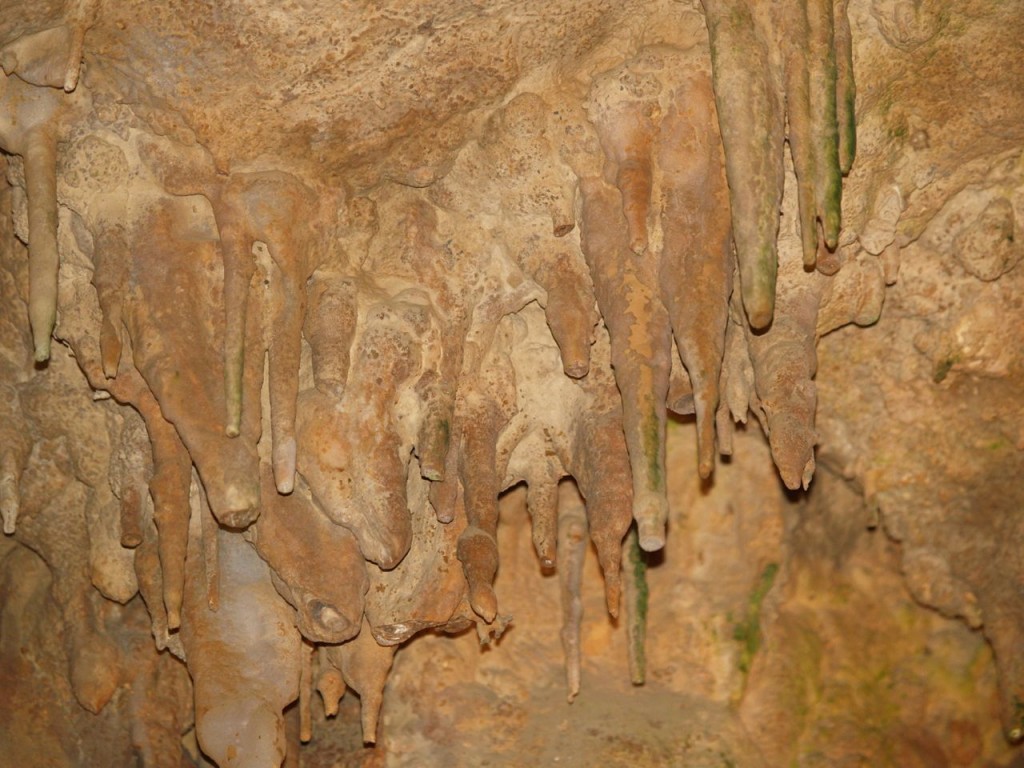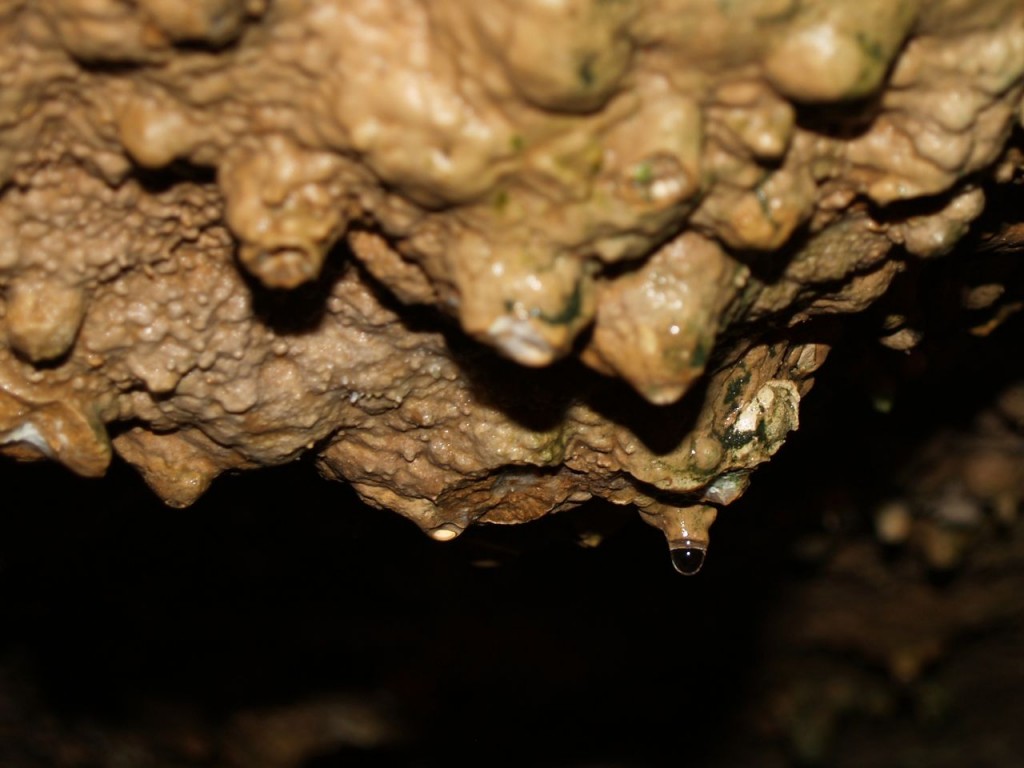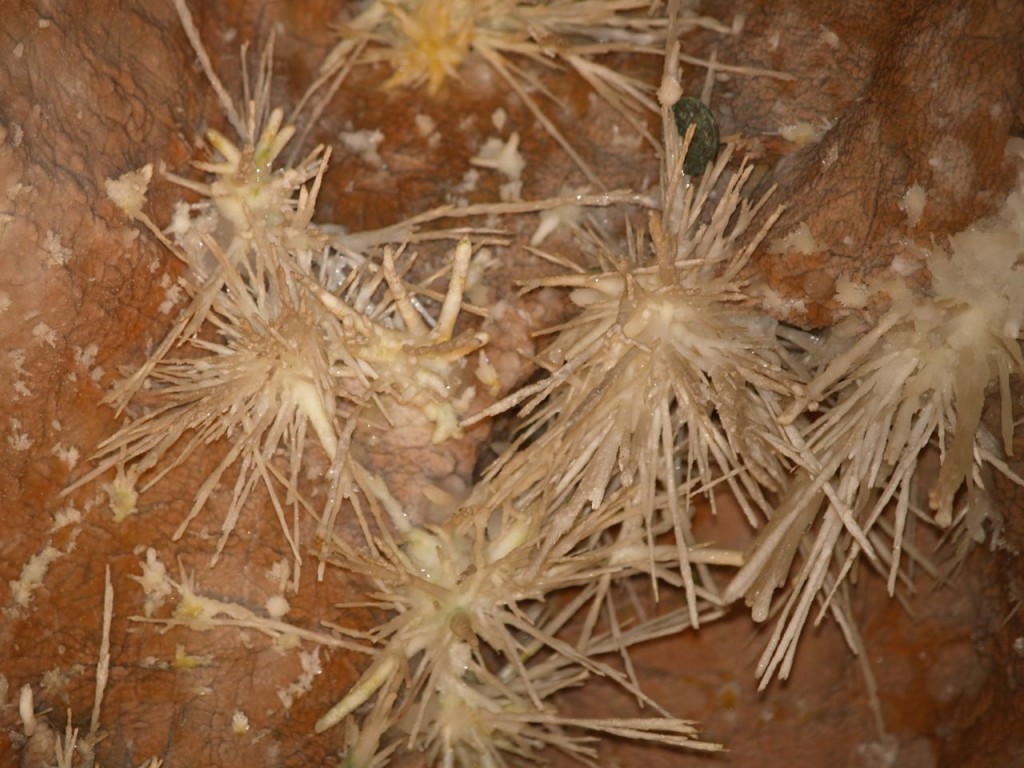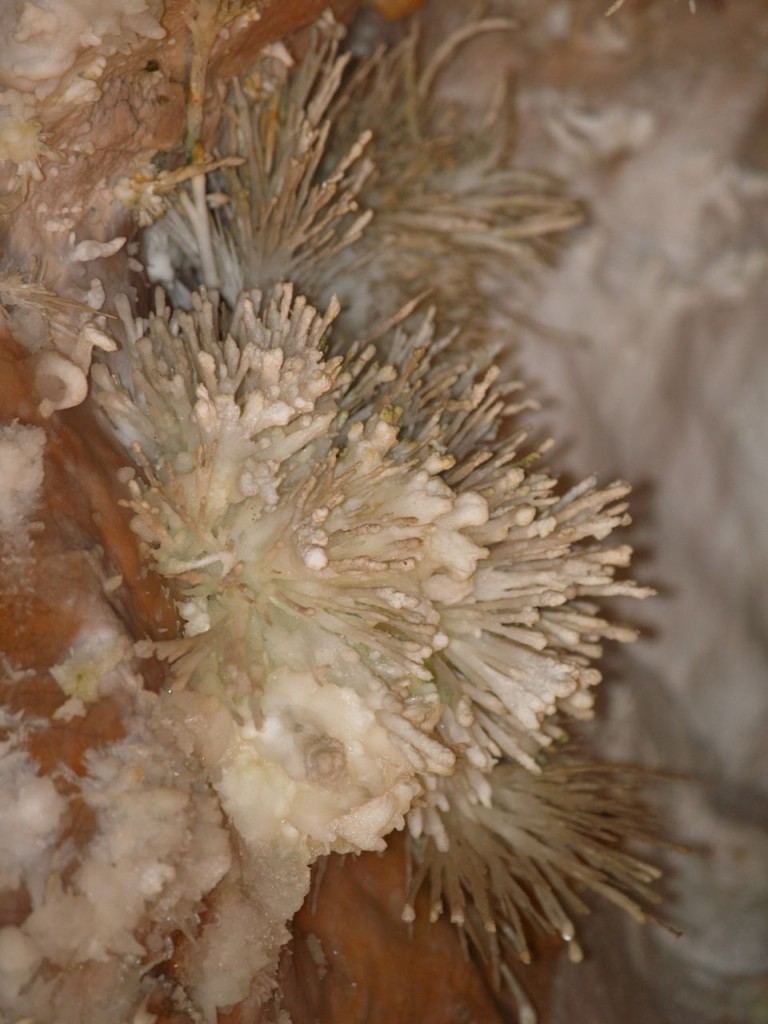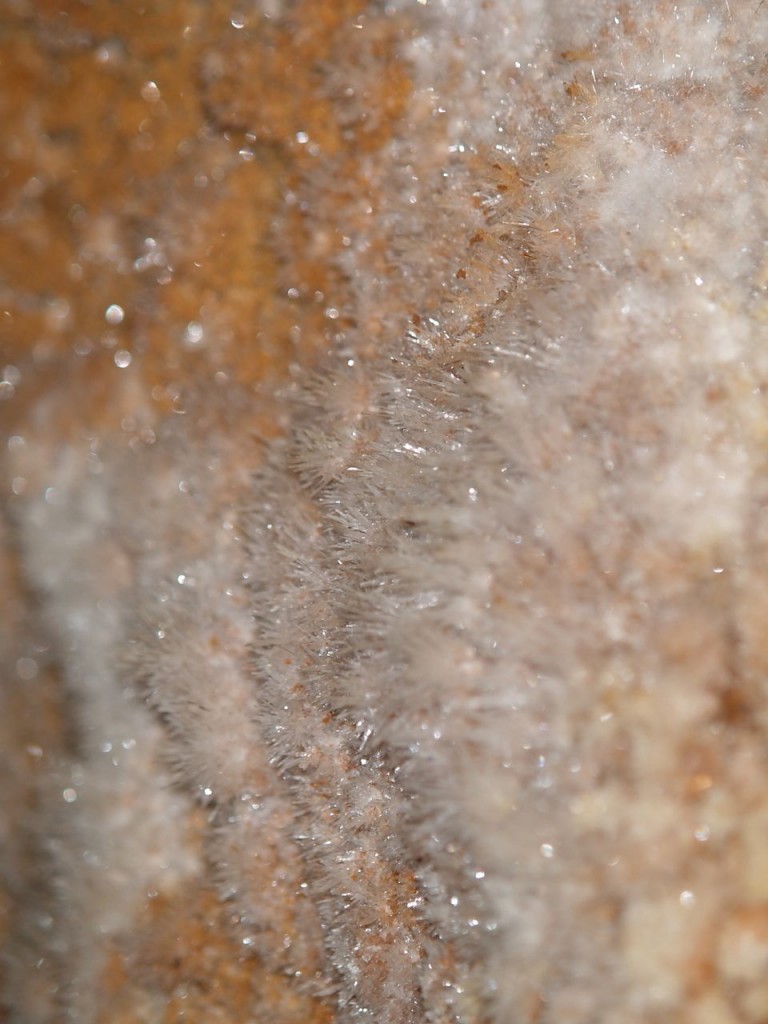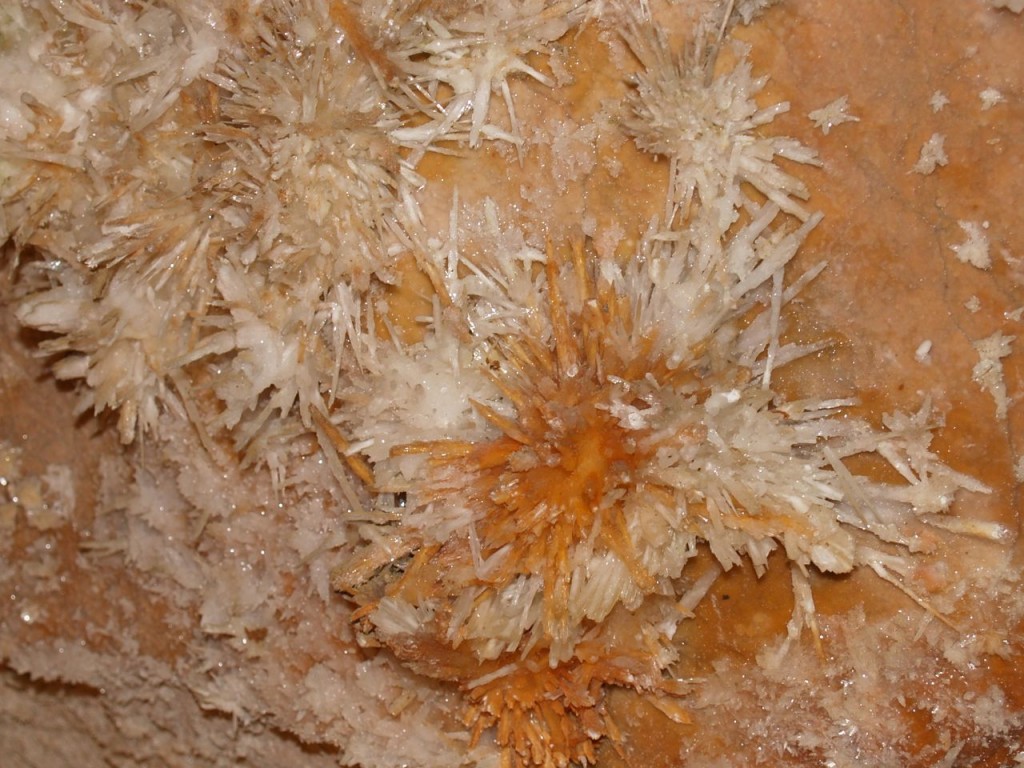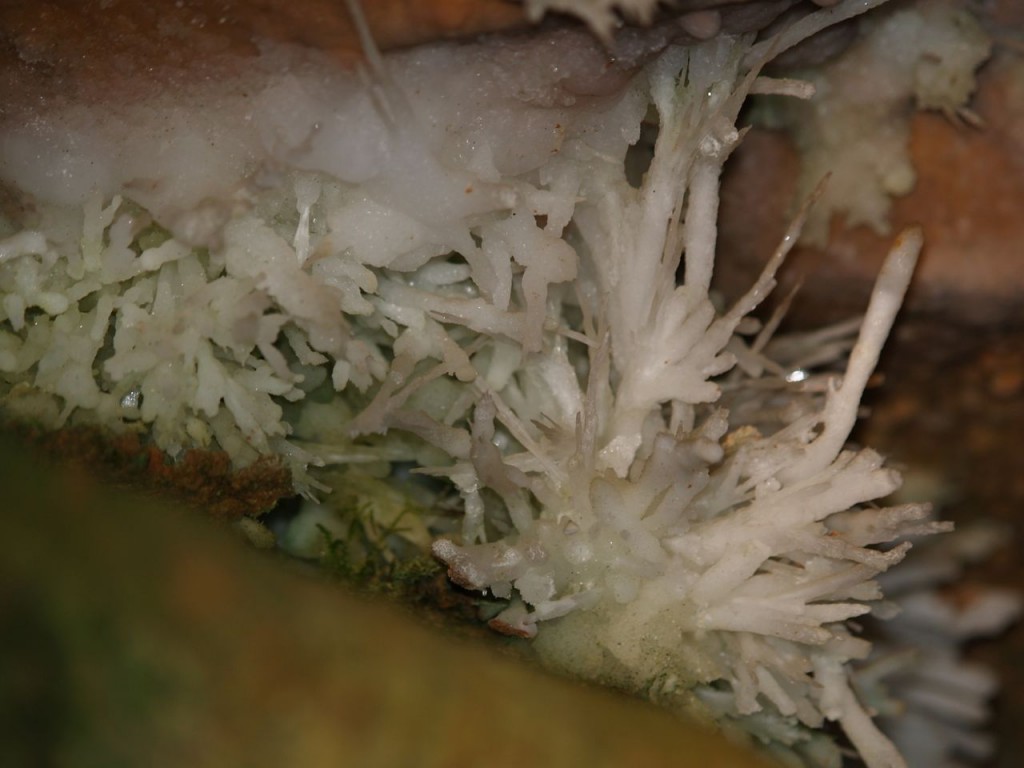I took a two hour cruise around the waterways of Chincoteague Island and Assateague Island today with Chincoteague Cruises and Nature Tours. It was a lovely day for a cruise, and I thoroughly enjoyed myself. Unfortunately we didn’t find any dolphins, but we did see some birds, Chincoteague ponies, horseshoe crabs, and jellyfish. We saw lots and lots of jellyfish in fact, such that I would never swim in the area where we cruised. The area is just beautiful, and the beauty becomes more clear when you can get away from all the tourists.
Author Archives: geek
Chincoteague National Wildlife Refuge
Chincoteague National Wildlife Refuge is lovely, but it really should just be called mosquito paradise. If you go here and want to walk on any of the trails, insect spray will be necessary. I hate bug spray, but the mosquitoes are so bad, even I resorted to using it. However, the walk around the swamp was nice except for the mosquitoes. There were more swamp rose mallowes (Hibiscus moscheutos) in bloom than I have ever seen. I saw a few birds, but not that many. I would guess however that this is a great area to bird during migration season.
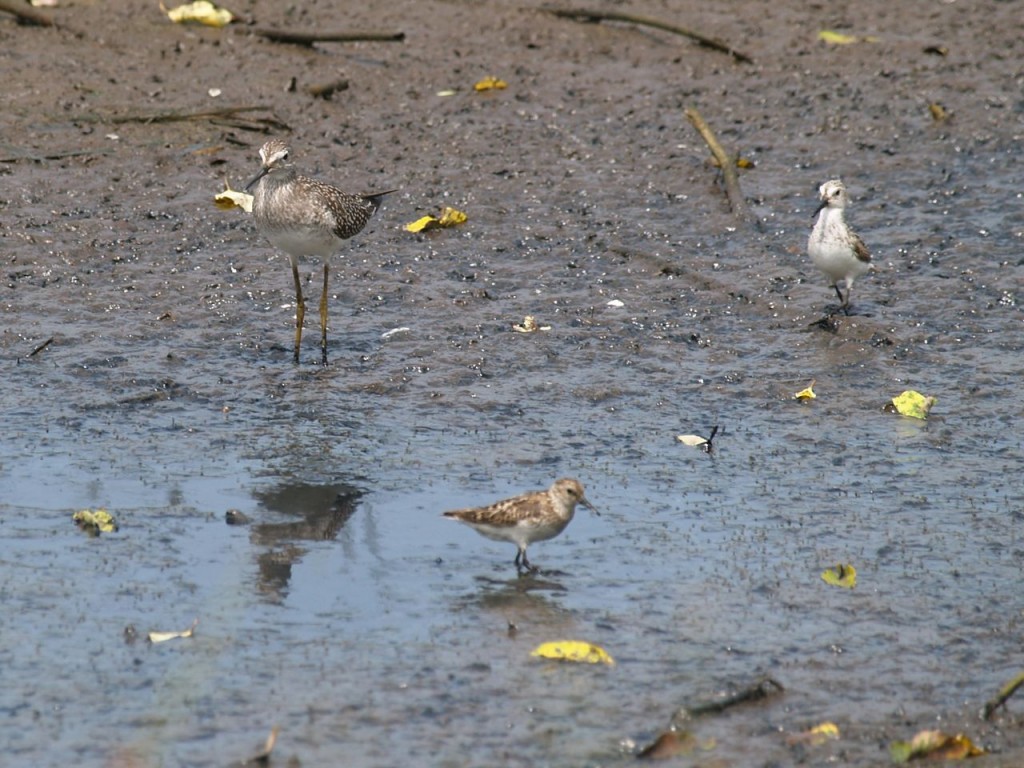
Greater Yellowlegs (Tringa melanoleuca), Semipalmated Sandpiper (Calidris pusilla), and another shorebird
Shenandoah National Park
I spent the day hiking and driving in Shenandoah National Park in Virginia. It is a beautiful park, and the weather was perfect. I was also treated to many insects going nuts on the flowers. The park has wonderful views of the area, including views that make it clear how the Blue Ridge Mountains got their name. I have identified the insects that I can. If anyone who happens to read this can identify or correct my identification, please contact me. I love to get the identifications correct. Edited to add: Thanks to Derek and friends on Twitter who have helped me identify the animals on this page!]
Luray Caverns
Unlike Skyline Caverns, which I visited yesterday, Luray Caverns let visitors take self guided tours through the caverns. This was very nice, as there were employees along the way to ask questions of if you had one, but I didn’t have to listen to a guide telling me what the various formations look like. Luray Caverns has fantastic stalactite, stalagmite, and column formations. It has a couple of small ponds that create perfect mirrors for the formations above, and it is absolutely beautiful and amazing to view. Luray Caverns also has the Stalacpipe Organ, which plays music by hammering stalactites instead of using pipes. It is rather interesting to hear.
Below is a video of the Stalacpipe Organ. It has a few still photos of the organ’s parts, and then a video with audio of the Stalacpipe Organ playing. Turn the volume way up to hear it.
Skyline Caverns
I visited Skyline Caverns today in Front Royal, Virginia. I have decided that caverns and other attractions that have some science involved need to have two different tours: one for people interested in the science, such as the geology of cave formation, and others who just want to see the pretty stuff and be told that a particular formation looks like Snoopy. Skyline Caverns has some nice formations and some neat underground rivers and lakes, The lakes are really neat to see because the water is completely still and forms a mirror reflecting all the formations above it. The best part of the tour of Skyline Caverns was the anthodites, which are absolutely beautiful six-sided calcite crystals. According to the tour guide, their existence was first discovered in Skyline Caverns by Walter Amos, the geologist who discovered the caverns.
Science Education with a Corpse Flower
During my two weeks of daily visits to the US Botanical Garden (USBG) to see the corpse flower, I talked to many people about the corpse flower at the USBG, on Twitter, on Facebook, and face to face in many other places. My website got record traffic. The news media ran stories about the corpse flower. On July 22, the day it was in peak bloom, there was a mass of people waiting, including me, to get into USBG before it opened at 10 am. My post for that day is titled Corpse Flower: July 22 am because I intended to get a second set of photos that afternoon. However, when I went back that afternoon at 5 pm, there was a line three blocks long of people waiting to get in to see it. I decided I didn’t have time to wait in that line. People were clearly interested in this plant. It was a big thing. I and thousands of other people were watching this plant every day on a live cam. To be clear, while this plant did grow amazingly fast, it was not so fast that you could see it growing if you just stared at it. We were watching a plant sit there, and many of us were obsessed.
Even better than this obsession watching it, was people’s interest in knowing more about it. Everyone wanted to know when it would bloom and why does it smell. Many people also wanted to know where it was from, was it really the largest flower in the world, where is its leaves, and how does it reproduce. Many of the people I talked to were perfect strangers who did not have a science background or would normally be interested in science type topics, but they found this plant interesting. It was a perfect opportunity to educate people about science, nature, and conservation. While I was happy to see how some employees and volunteers at USBG responded to all the interest, I have to admit I was really disappointed at some very squandered opportunities of which USBG on the whole did not take advantage.
Part of my disappointment with USBG is that I am comparing it to what happened when a corpse flower named Lois bloomed at Houston Museum of Natural Science (HMNS) in 2010. HMNS set up a live cam also and also set up a Twitter feed to run on the same webpage as the live cam where any tweets with a designated hashtag would show up, so people could discuss the corpse flower. Like many corpse flowers, Lois was unpredictable and seemed to be taking too long to bloom. So while everyone was waiting for Lois to finally bloom, someone not associated with HMNS, set up a parody Twitter account called @CorpzFlowrLois, and the first tweet was “Maybe I’ll bloom, maybe I won’t.” This pretty much summed up the plant. The tweets from @CorpzFlowrLois kept getting funnier and funnier as Lois was given a diva personality complete with a personal assistant who was constantly late bringing her her cappuccino, an ex-boyfriend back in Sumatra who wanted her back, and the real life HMNS horticulturist whom she thought touched her too often. HMNS had no idea who was behind @CorpzFlowrLois, but they just went with it and linked to the account on their website with a disclaimer because as @CorpzFlowrLois got more and more followers, HMNS got more and more admission-paying visitors to the museum as well as website visitors. HMNS hosted webinars and educated everyone about the corpse flower and the related science.
Thus, it is probably slightly unfair for me to compare USBG to HMNS because partially thanks to @CorpzFlowrLois, Houston and the internet went absolutely nuts over Lois. I saw two different parody Twitter accounts set up for USBG’s corpse flower, but neither of them were as prolific or as funny as @CorpzFlowrLois. Also, for whatever reason, USBG did not embrace social media at all. Even though they knew they were going to get more visitors and interest because of the corpse flower, they didn’t seem to know what to do with it. The fact that they don’t charge admission may have something to do with their response. However, they also didn’t do what I think would be incredibly easy things to help educate people and satisfy their curiosity. They had two small posters set on either side of the corpse flower with some information about and photos of corpse flowers. They passed out pamphlets with some information and also had some information and photos on their website. However the information was somewhat basic and did not answer many of the questions I constantly heard people ask them. They also did not have many photos, and to be blunt, I think my photos were much better. When I talked to people at USBG, I always referred them to my website to see more photos, especially if they wanted to be able to see the progression of it growing as you couldn’t do that on USBG’s website.
People, including myself, were asking them everyday if the corpse flower was still growing or how tall it was. The staff measured the height and width of the corpse flower daily if not more often, so generally the staff member who was near the corpse flower would know the latest information and could answer those questions. While I suppose I should have suggested it, I don’t know why they didn’t just set up a white board or post on the website the growth information so people wouldn’t have to find a staff member to ask. People wanted to know more about the reason for the smell and how the plant reproduced, but the information that USBG had was minimal.
However, my greatest annoyance with USBG was with a few of the staff members. To be clear, most of the ones to which I either talked or listened, were knowledgable and great, if somewhat exhausted from the nonstop questions. However I heard two different staff members not only not take advantage to educate but also just plain use wrong terminology. On one of my daily corpse flower visits, I heard a man tell some people it was the largest flower in the world. I turned around, smiled, and said it is actually the largest unbranched inflorescence. He said well yes, of course, that is actually a spathe, but he finds it best to avoid technical terms around non-technical people. I later realized he was actually a staff member, but he didn’t have his ID badge displayed prominently. He said he was plant educator and if you use technical terms, which evidently includes spathe and spadix, then people get disinterested and confused. I said I found the opposite to be true, if the subject is explained well, then people can not only understand technical terms but want to know more. For example, if you explain that what they are looking at is not actually a flower, then people want to know where the flowers are and why. Further, if you give a person the wrong information like calling the copse flower the largest flower in the world, then how exactly did you educate them?
This is not just my opinion though of people wanting to know the technical terms and full explanation, it is my experience. As I stated, I talked to complete strangers while at USBG. Many times our conversation would start off because someone would state to their friend or just out loud to whomever “I wonder when it is going to bloom” or “why does it smell.” When I could do so without seeming to be a know-it-all or intruding in their conversation, I would engage them in conversation and educate them when I could. If the question was about when it was going to bloom, I would often show them some of my photos on my iPhone and describe the changes. I would always state I am no expert, but here is how it has changed. I would also state what I heard from staff and what I could observe, such as there was one last sheath (green petal like structure) that needed to fall or the staff member said it grew another six inches yesterday, and it needs to stop growing before it will bloom. I had wonderful, sometimes long conversations with people, and I always used proper botanical words when I knew them, showing the people how the structure we were waiting to open was actually a spathe that was protecting the real flowers inside it. Never once did a person get disinterested or tell me they didn’t understand me. They just asked me more and more questions that I tried to answer if I could. Many times while talking with one or two people, I would essentially draw an audience, and 15 minutes later I was surrounded by people all wanting to know more about the plant. I would always be forced to give everyone a disclaimer that I am not a botanist, I am just obsessed with the corpse flower and spend too much time on the internet.
When talking about the copse flower, if you just call it a flower, then you can’t really explain why it smells or other topics people were so interested in knowing. Sometimes when talking to people I would use the word blossom initially instead of spathe. I did that so that I did not incorrectly call it a flower, but once I talked more about it, I could explain how it was really an inflorescence. When talking about the corpse flower to people, I think back to high school chemistry where students are originally taught the Bohr model of the atom. The teachers explain, this model is not correct. but it was a good way to initially describe the atom, and later students will be confused with the quantum model of the atom because no one really understands the quantum model of the atom. As the statistician George E.P. Box stated “essentially, all models are wrong, but some are useful.” Thus calling the corpse flower a flower is a wrong model, and it can be useful, if and only if, the true structure of it is later described.
I did not write this blog post to bash USBG. I really appreciate how they set up the live cam, had extended hours (although I wish they had extended their hours on the night it actually bloomed), and made their staff available to educate people who came to see this magnificent plant. I just wish they had taken more advantage of the amazing opportunity to educate people who would normally not come to a botanical garden about nature and science. It can be difficult to interest people in nature and science, and when something comes along that grabs people’s interest, you have to take advantage to educate. I took advantage of it to talk to and educate friends and complete strangers about the science of this fascinating plant and how amazing nature is, and it was a wonderful experience that I will never forget.
USBG Corpse Flower: July 25
The corpse flower at Washington, DC’s US Botanical Garden (USBG) is rapidly going dormant. The spadix has collapsed, and the spathe continues to wither. The USBG staff cut two holes in the base of the spathe. The female and male flowers can be seen through those holes (see photos below). A staff member told me that they harvested the pollen today. I forgot to ask if they pollinated the female flowers, but I would assume not as they would have bloomed four days ago when the plant was in peak bloom. As always refer to my photos from the past two weeks to see changes (July 11, July 12, July 13, July 14, July 15, July 16, July 17, July 18, July 19, July 20, July 21, July 22, July 23, and July 24). Also, see the “Corpse Flower” page on my website that has photos from everyday that shows the whole plant so the photos can be more easily compared as well as a video that has a slide show of photos. Finally, I continue to give the smell report for old time’s sake. There is no smell.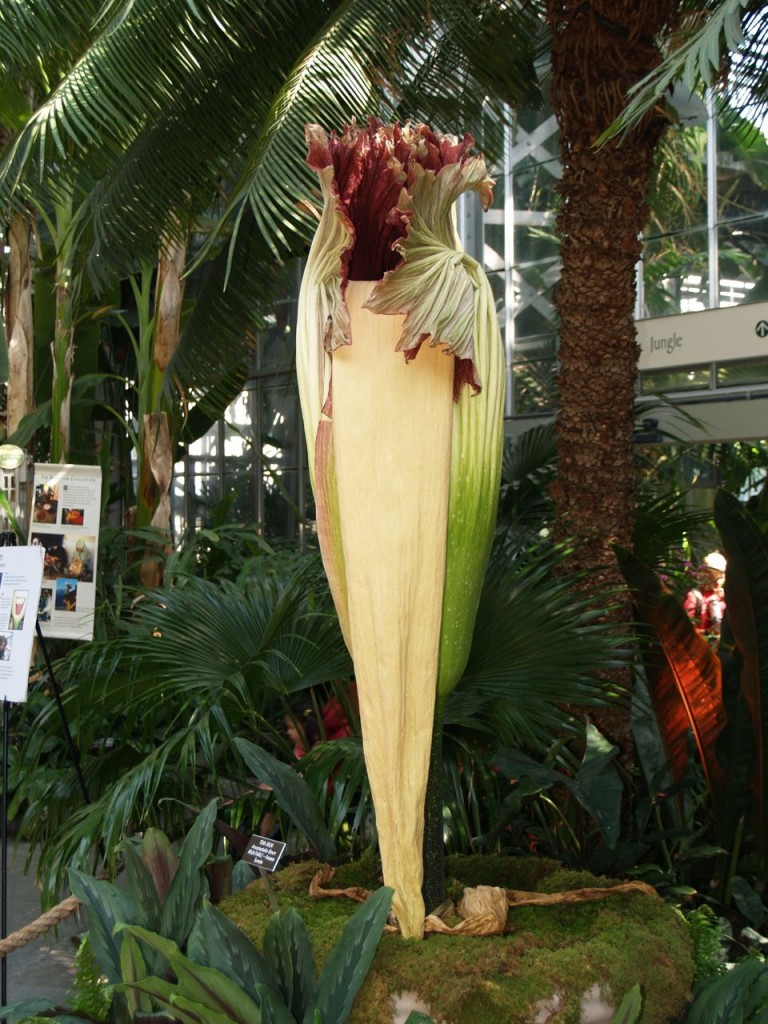 On the left side of the spathe base in the below photo, one of the holes created when the staff cut into the spathe can be seen.
On the left side of the spathe base in the below photo, one of the holes created when the staff cut into the spathe can be seen.
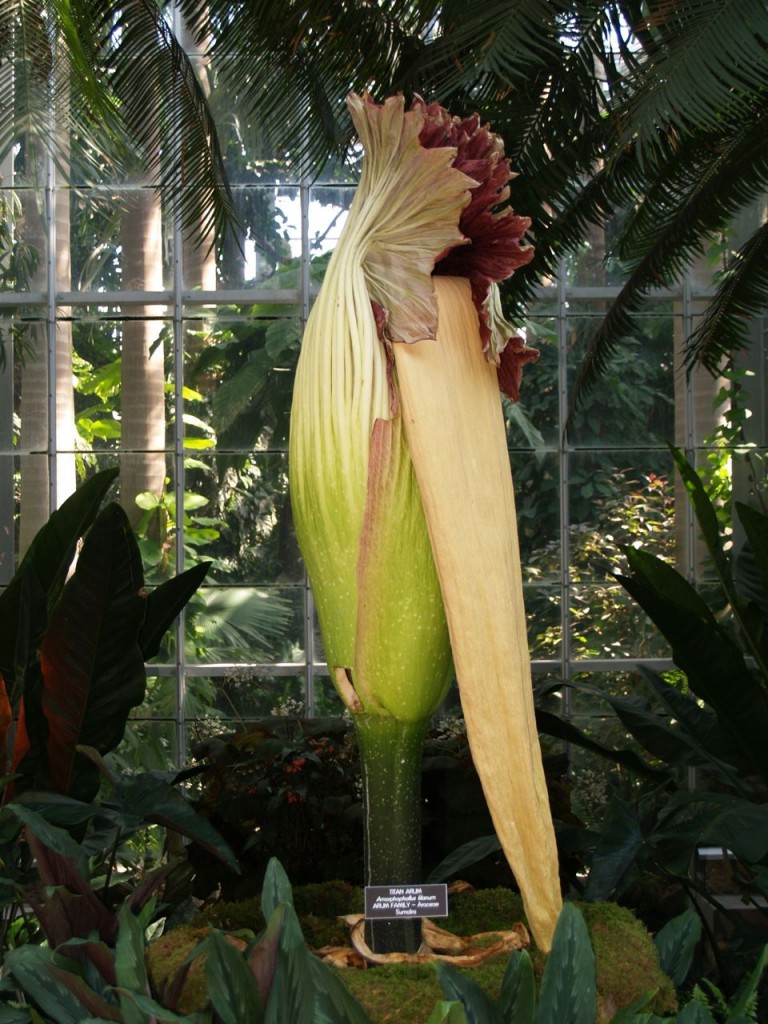
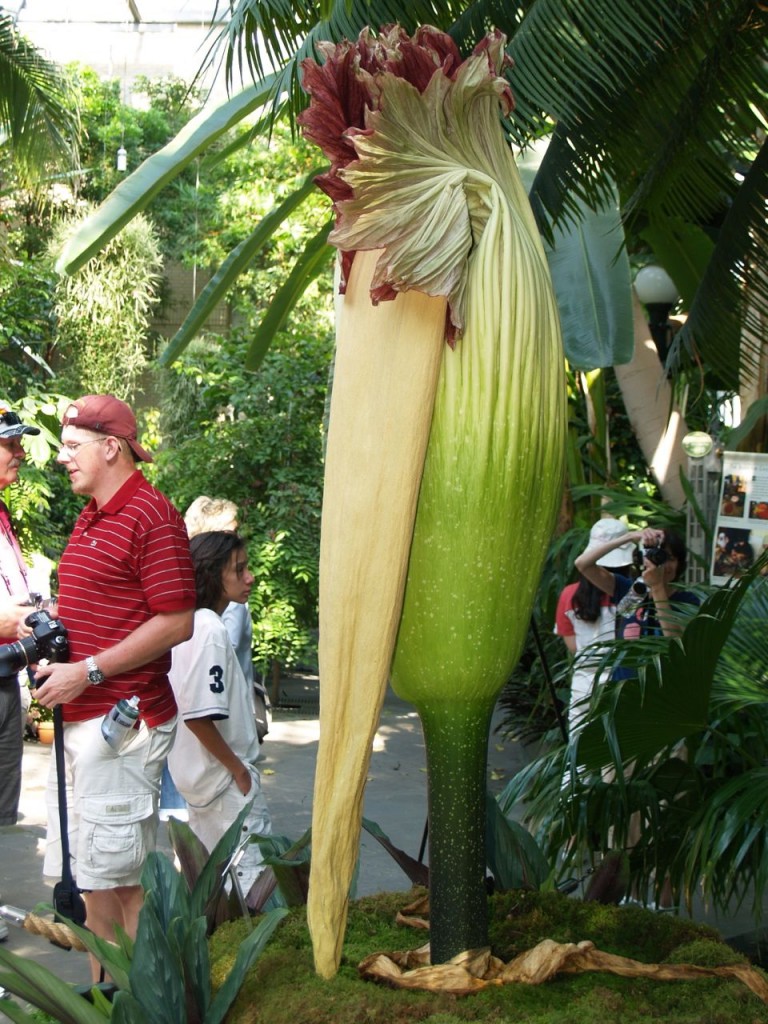
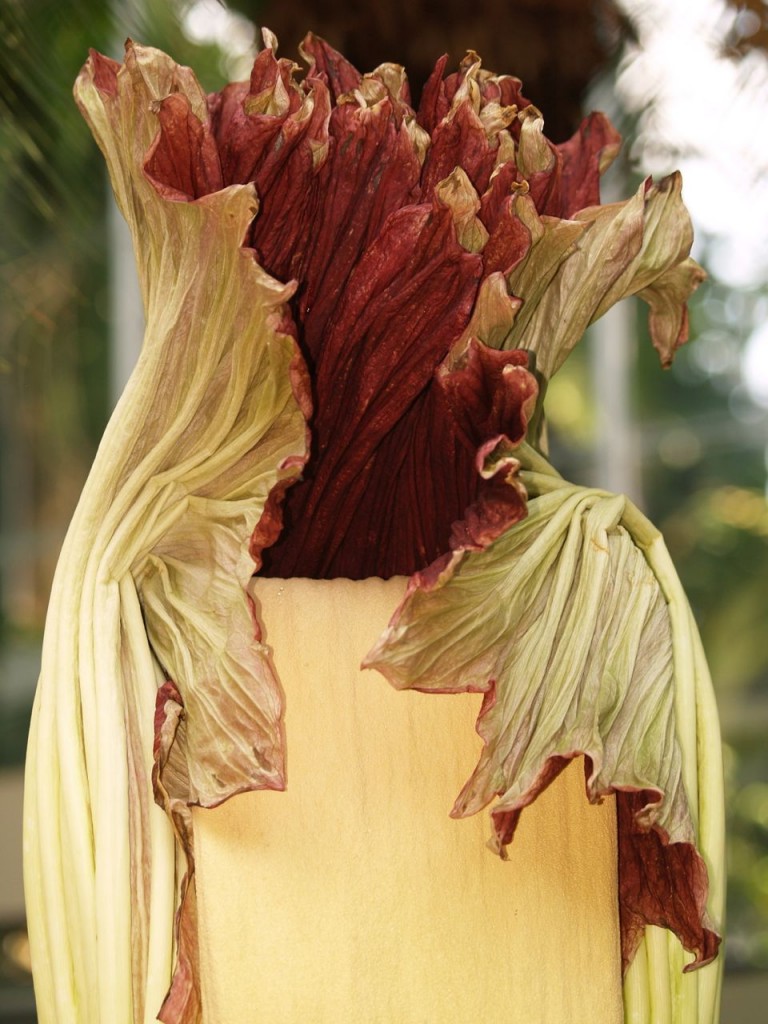
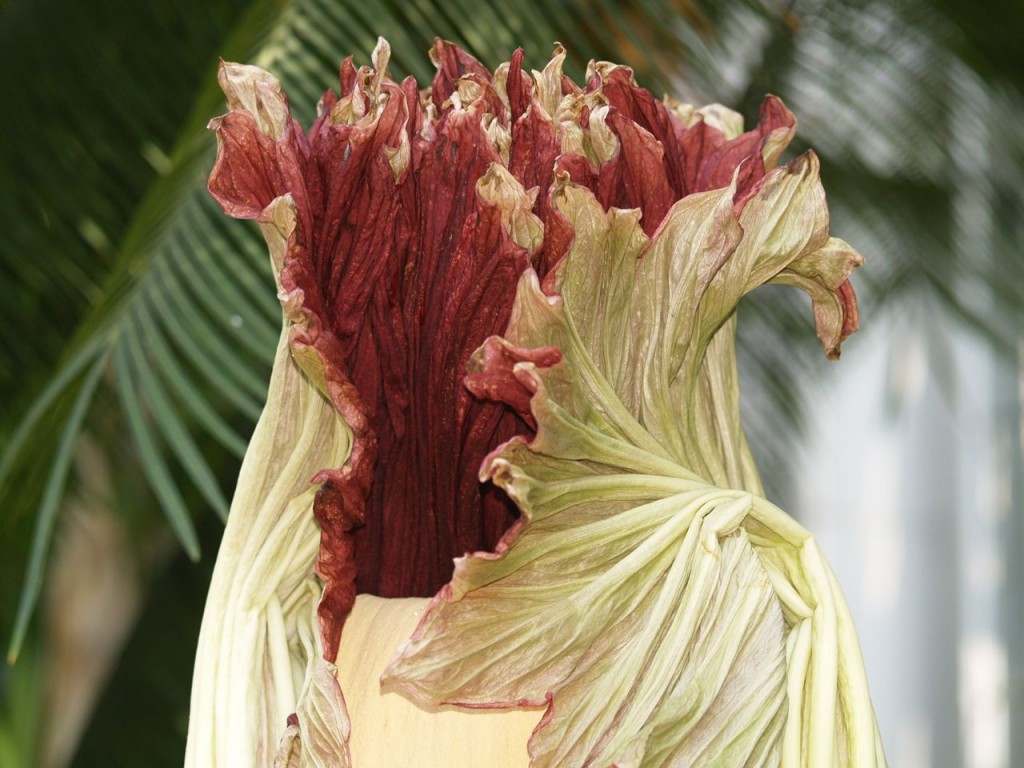
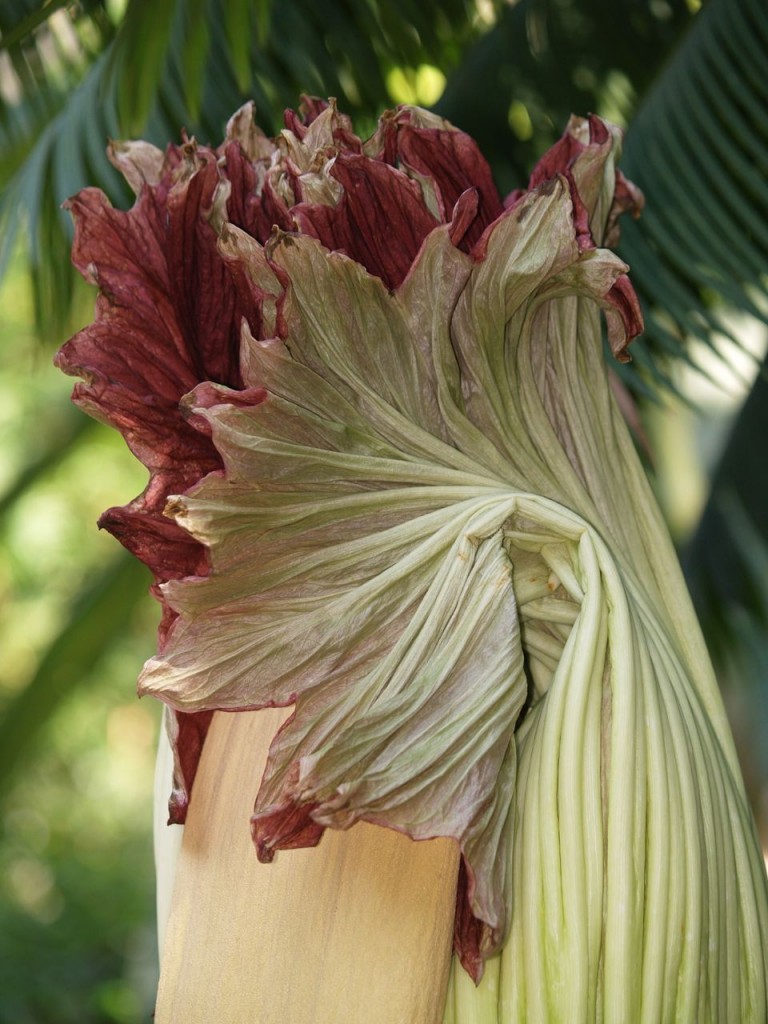
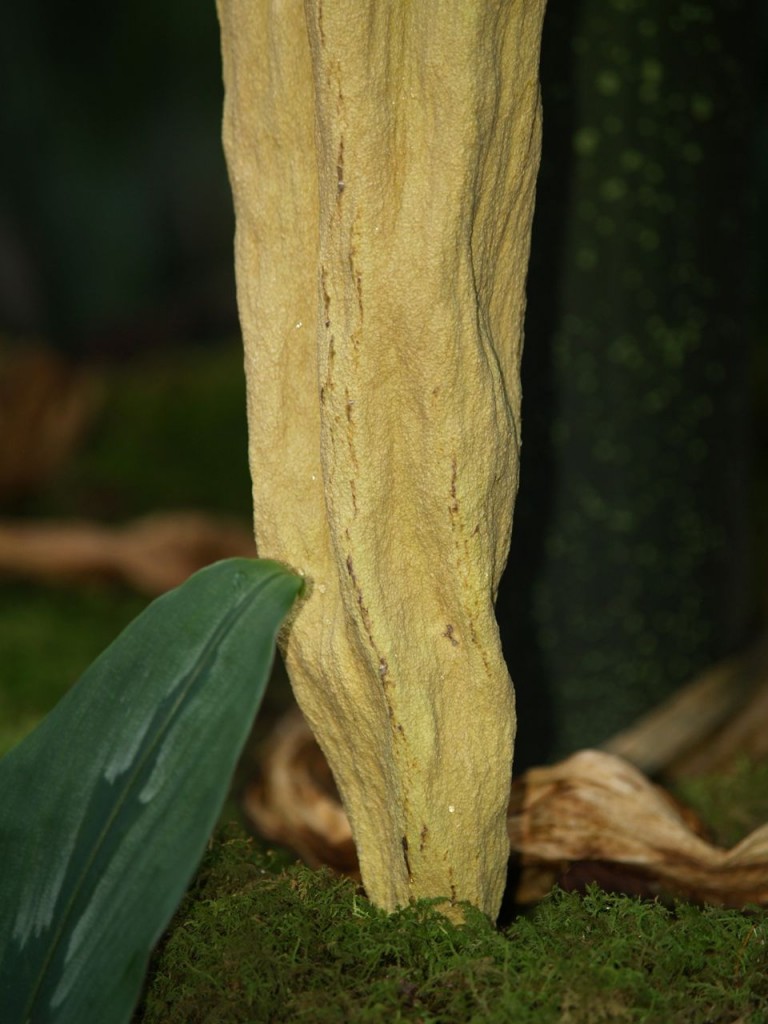 Below is the view through the lower hole cut in near the base of the spathe that shows the female flowers.
Below is the view through the lower hole cut in near the base of the spathe that shows the female flowers.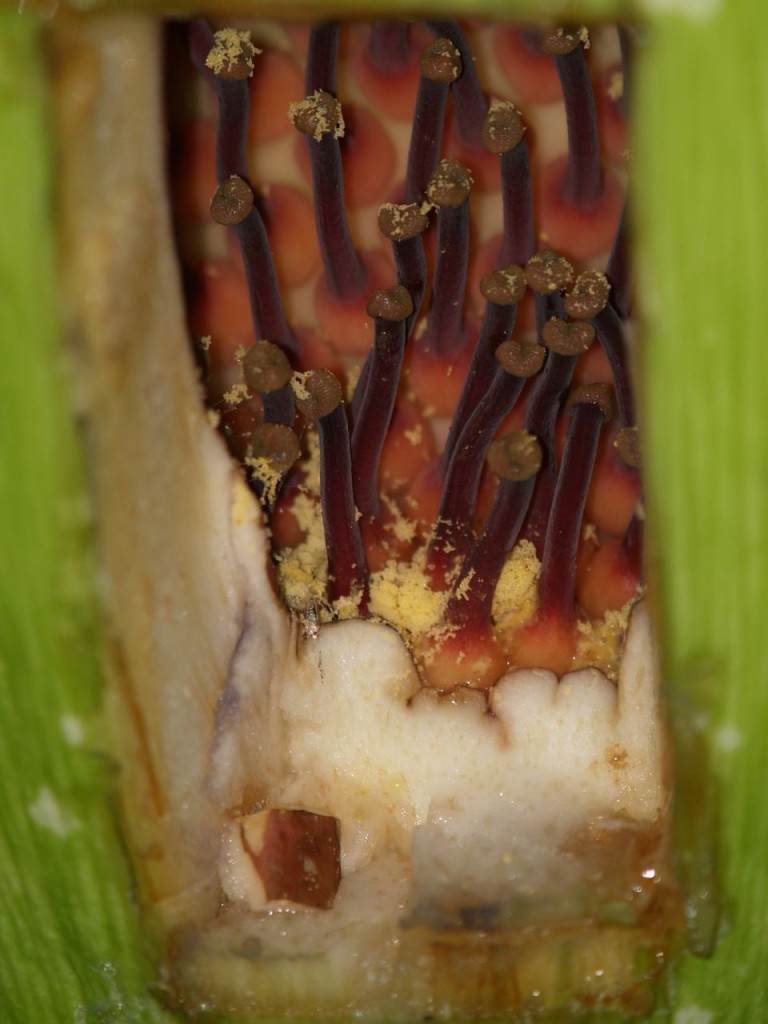
Below is the view through another slightly higher hole that was cut near the base of the spathe that shows the male flowers with the female flowers underneath the same flowers.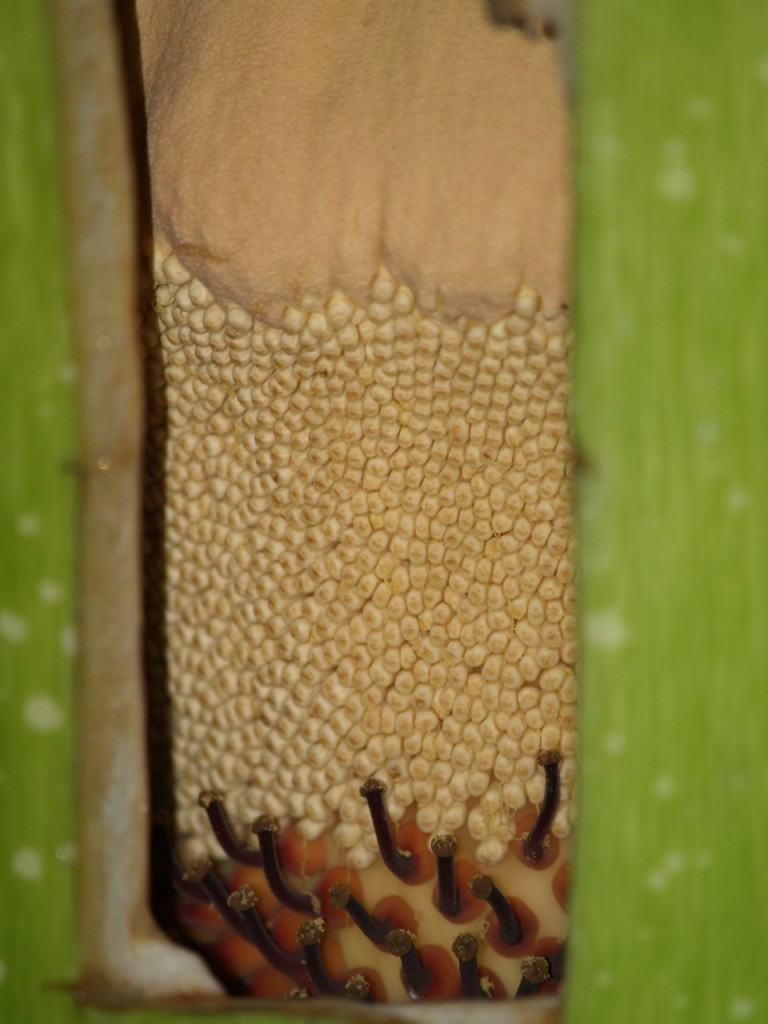
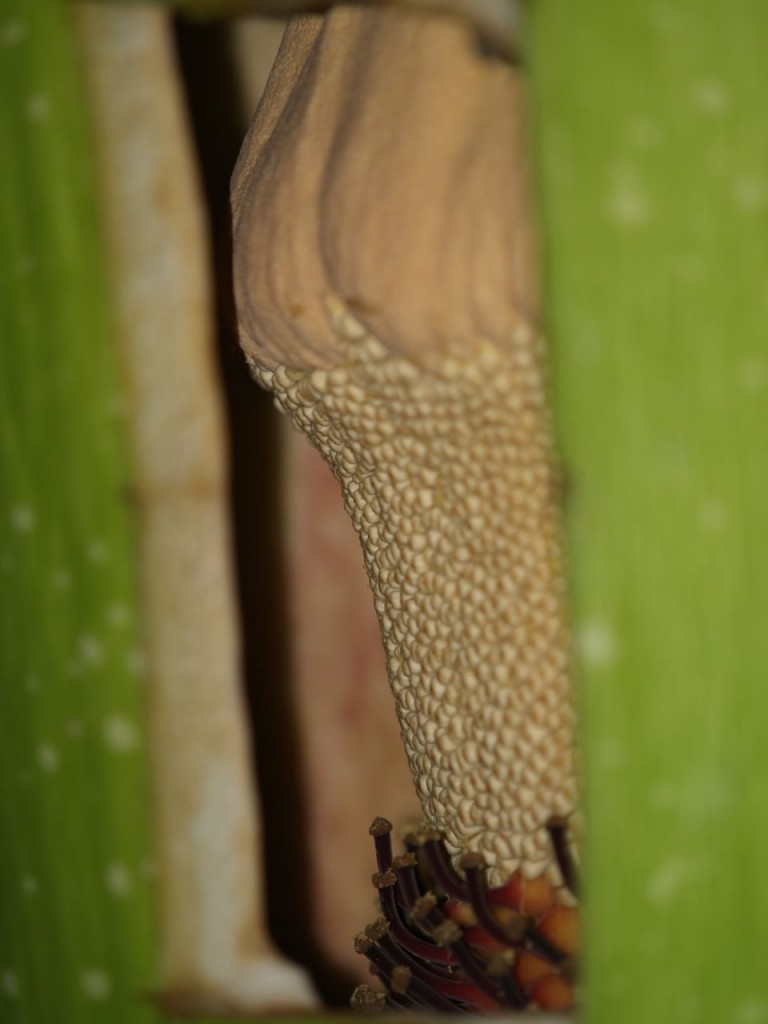
USBG Corpse Flower: July 24
I think I have already stated how I am obsessed with the corpse flower at Washington, DC’s US Botanical Garden. It should be obvious as I have photographed it everyday for the past thirteen days (July 11, July 12, July 13, July 14, July 15, July 16, July 17, July 18, July 19, July 20, July 21, July 22, and July 23). Today I realized I really am a bit too attached to it. The crowds visiting it have mostly died down, but some are still coming to see it. Some state they did not realize how quickly the bloom withered or didn’t realize they had missed the peak bloom. Today while I was photographing it, a group of teenagers were also there. They probably looked at it for only a few minutes. I saw one girl stand there, shrug her shoulders, then walk away with this “what’s the big deal” expression. I found myself thinking “don’t speak ill of the dying” as if the corpse flower might have its feelings hurt. Yes, I have grown far too attached to it. Then again, I am not the only person who anthropomorphizes it. While I was there, I heard someone tell some other people that the corpse flower was “moving on” as if it had found a better job at another botanical garden. This has caused me to get a mental image of the corpse flower dying back into its corm, then somehow extending wheels on its pot and wheeling itself over to a fancier botanical garden. This would somehow seems to be difficult without with arms or hands, but perhaps it is a really fancy pot that it can operate via low grade electrical charges in the soil. The large pot then takes to the road hauling the 80-lb or so corm to the fancier botanical garden with a better staff of botanists to care for it. DC traffic is bad enough without having to deal with a large pot containing a corpse flower corm slowing driving itself to a new greenhouse. Yes, I’ll stop with this nonsense now.
The blossom continues to wither. The spathe has collapsed completely back towards the spadix, and the spadix appears to be shrinking more. The plant is more yellow and the spathe looks crispy and dehydrated. I think the spadix is starting to lean also. As always, see the “Corpse Flower” page on my website that has photos from everyday that shows the whole plant so the photos can be more easily compared as well as a video that has a slide show of photos. Finally, I continue to give the smell report for old time’s sake. There is no smell.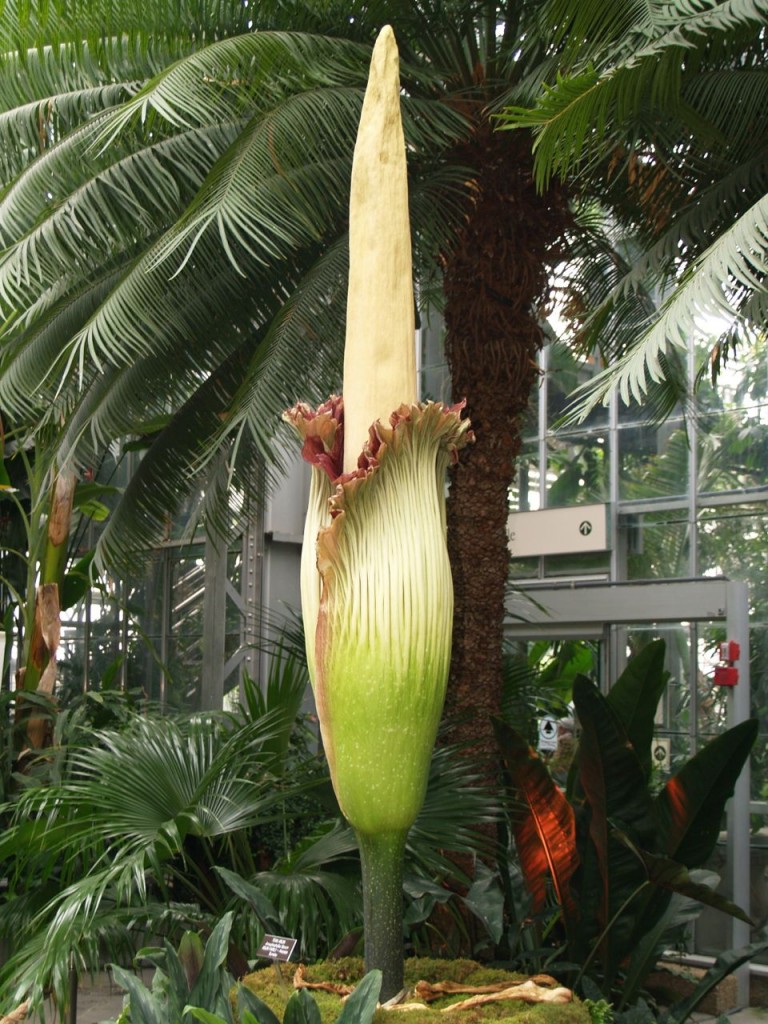
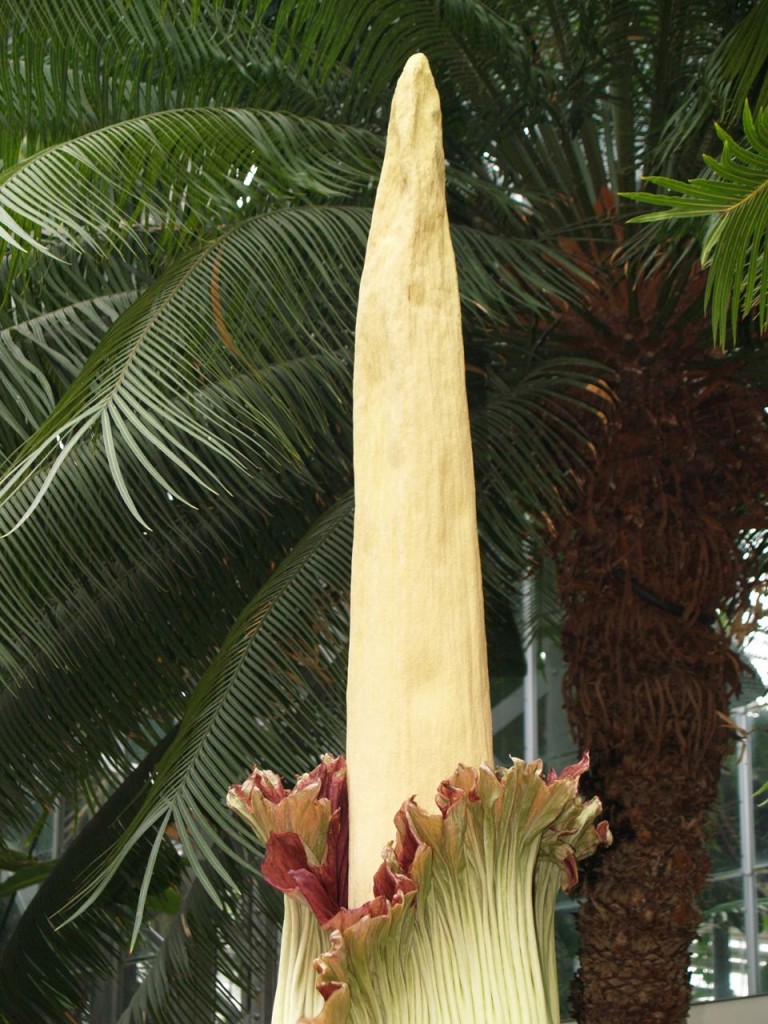
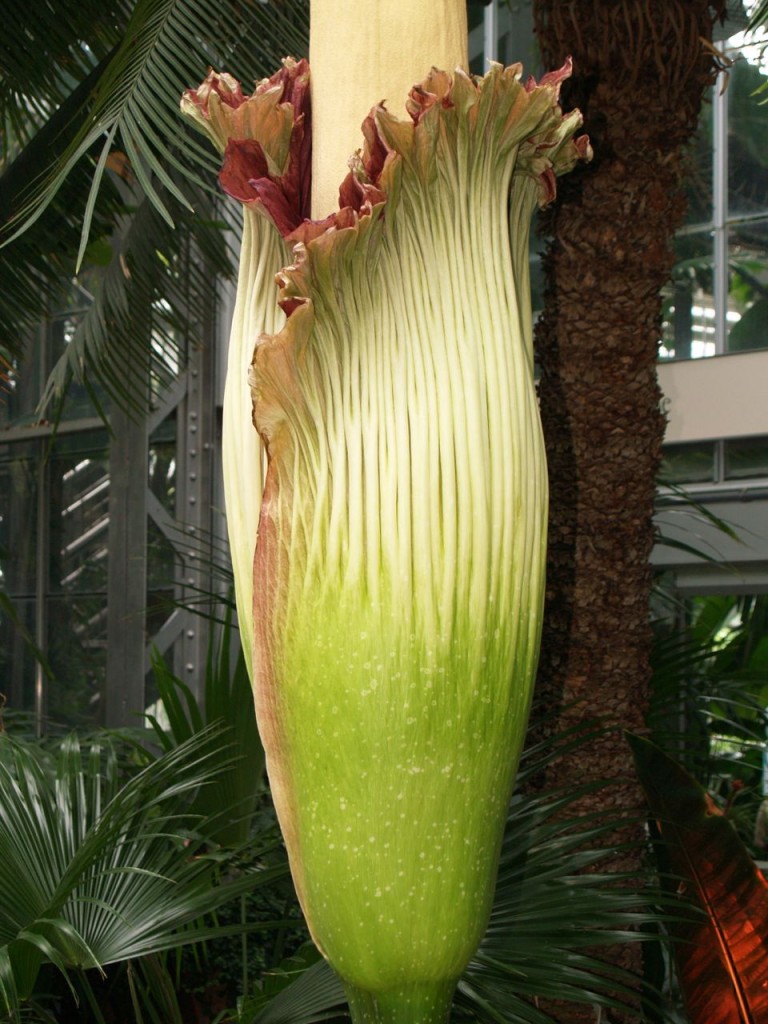
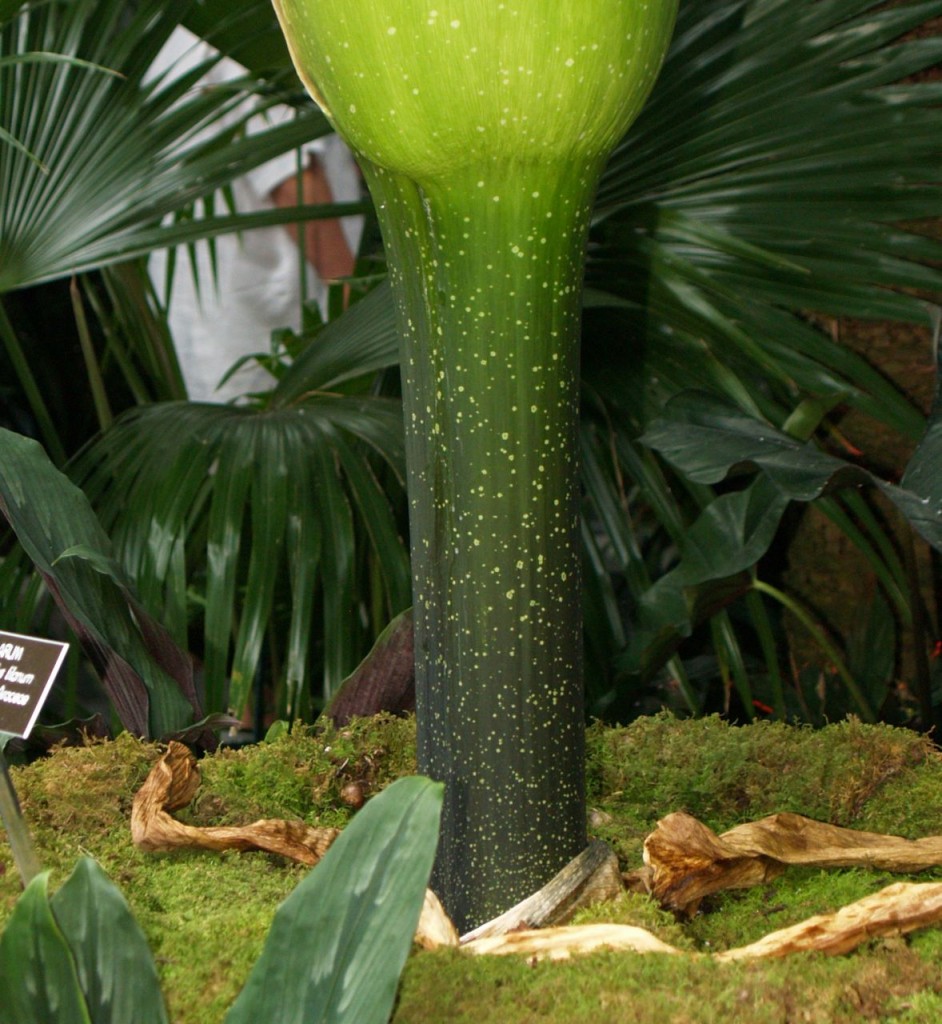
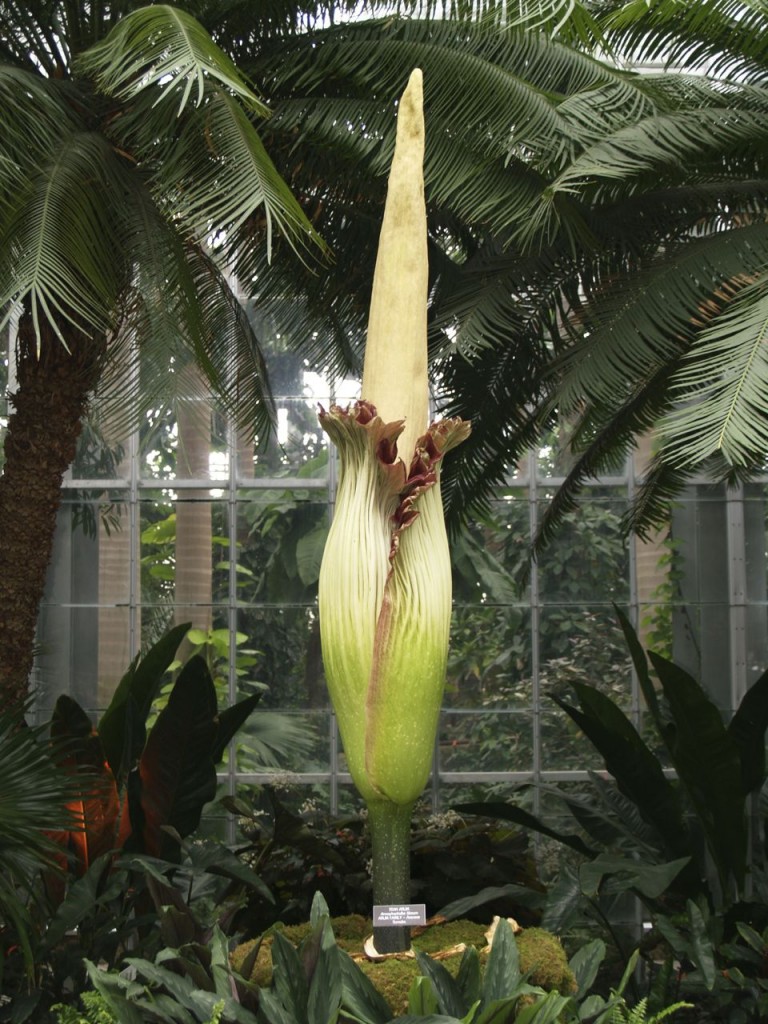
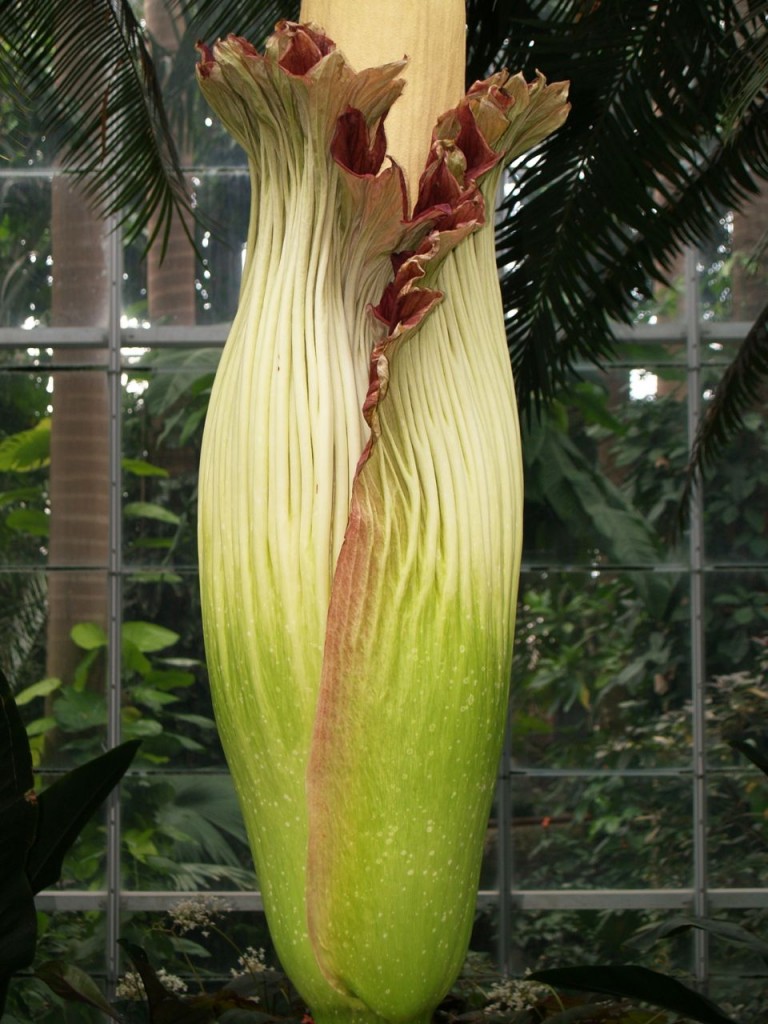
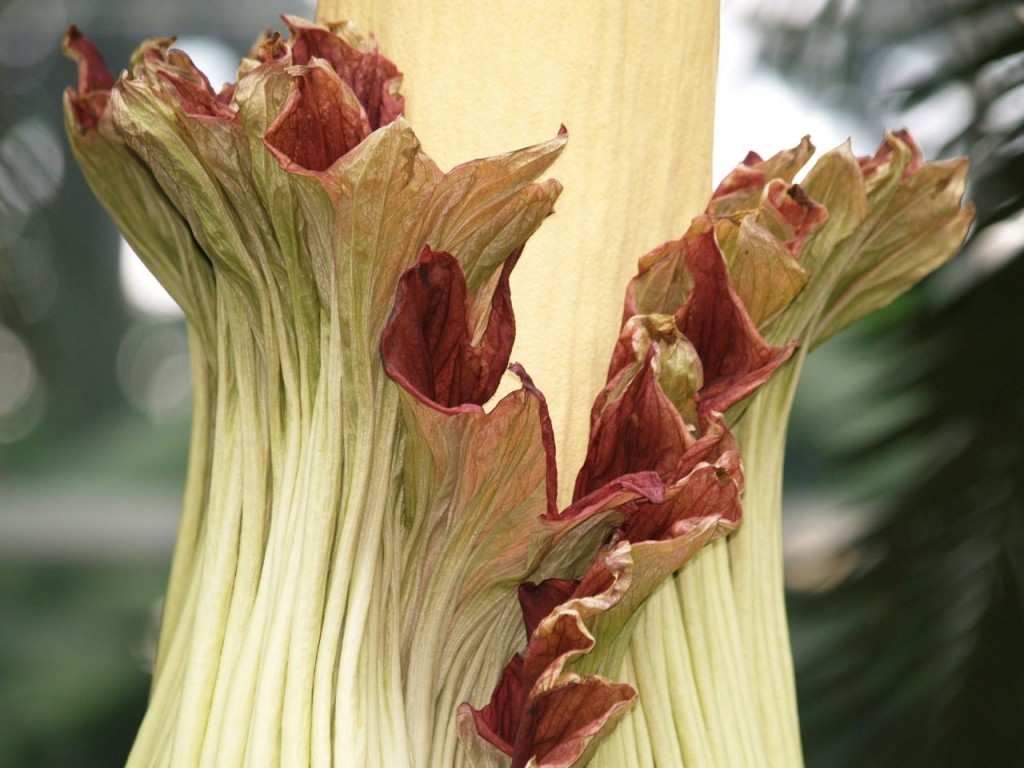
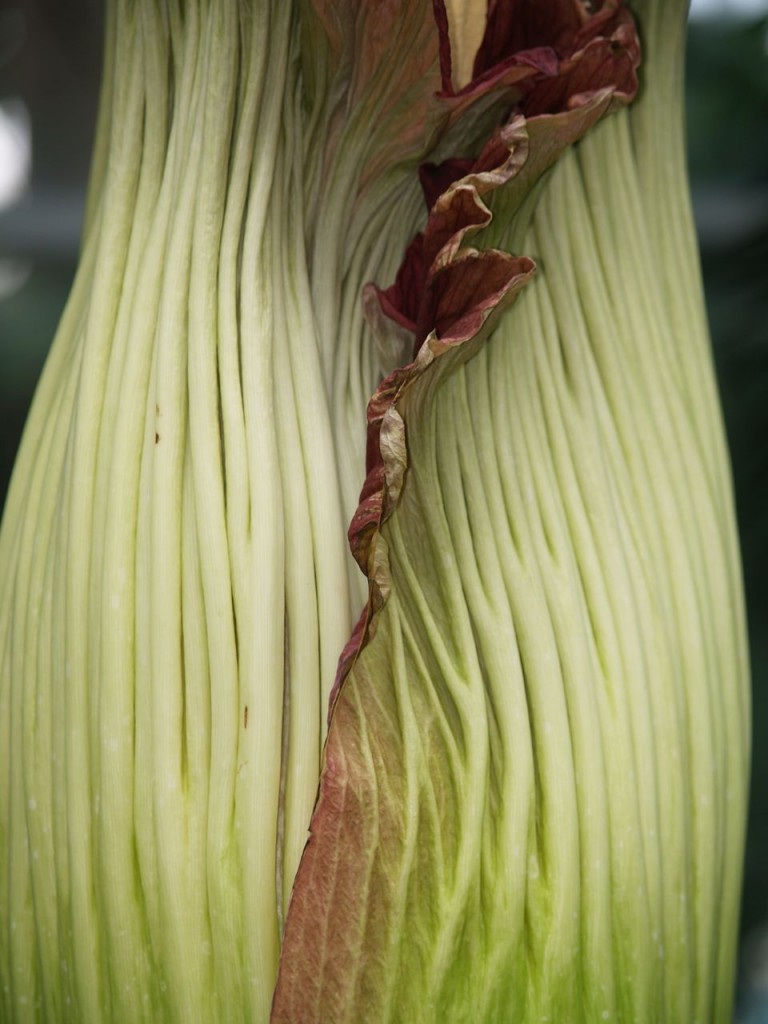
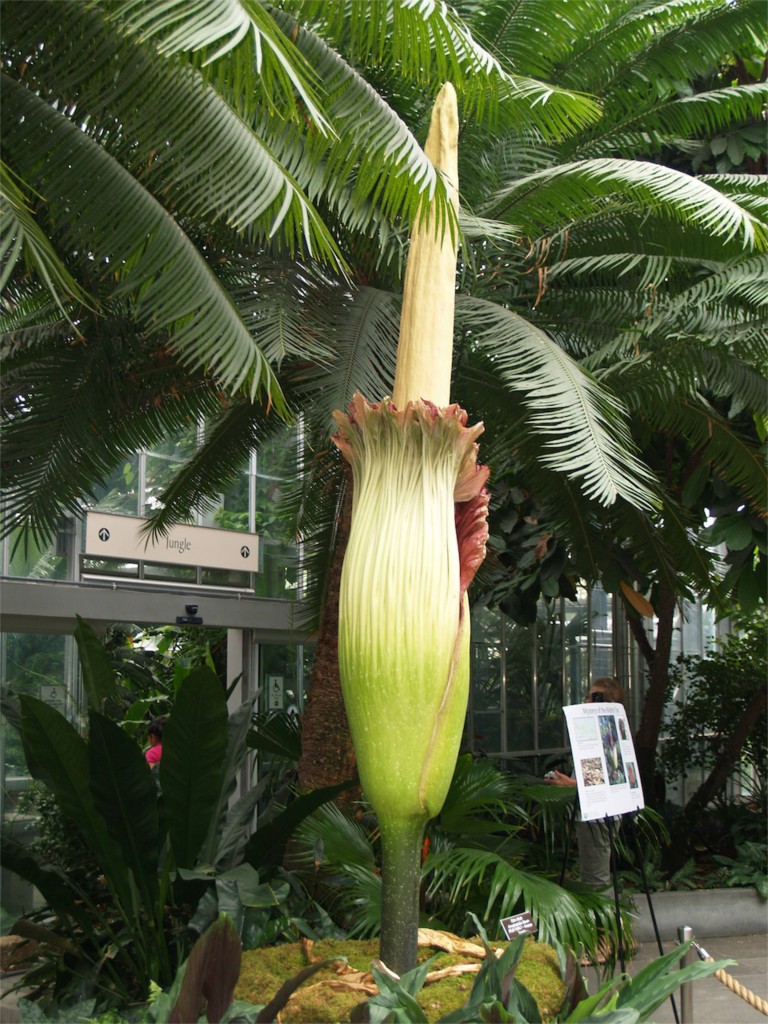
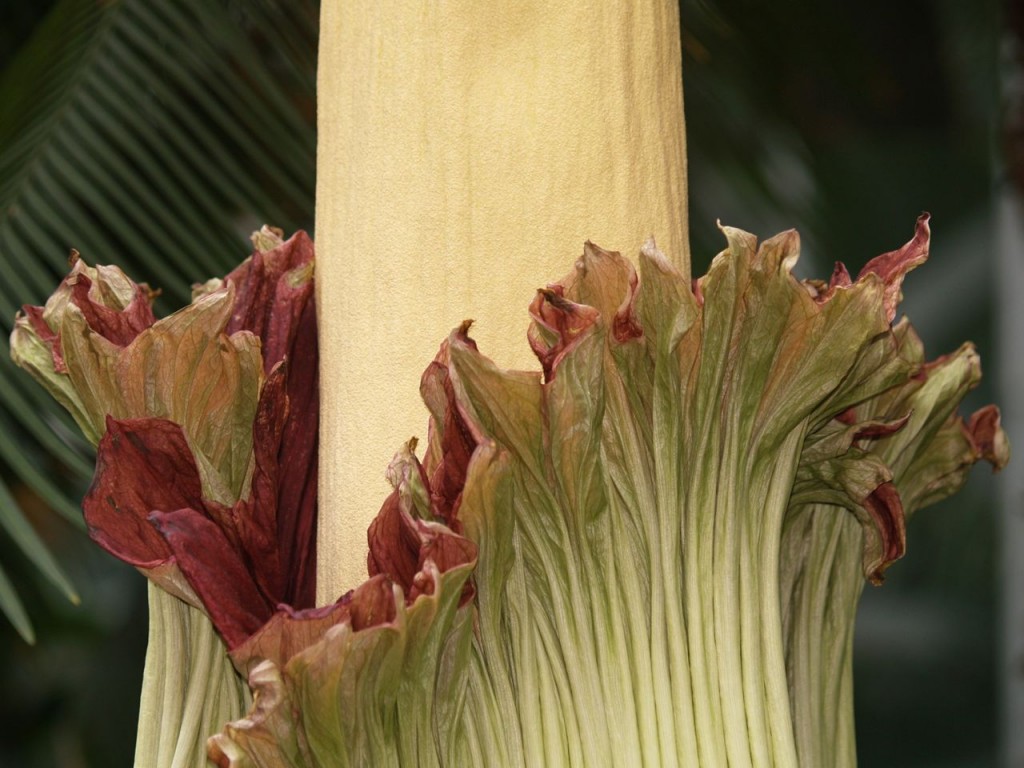
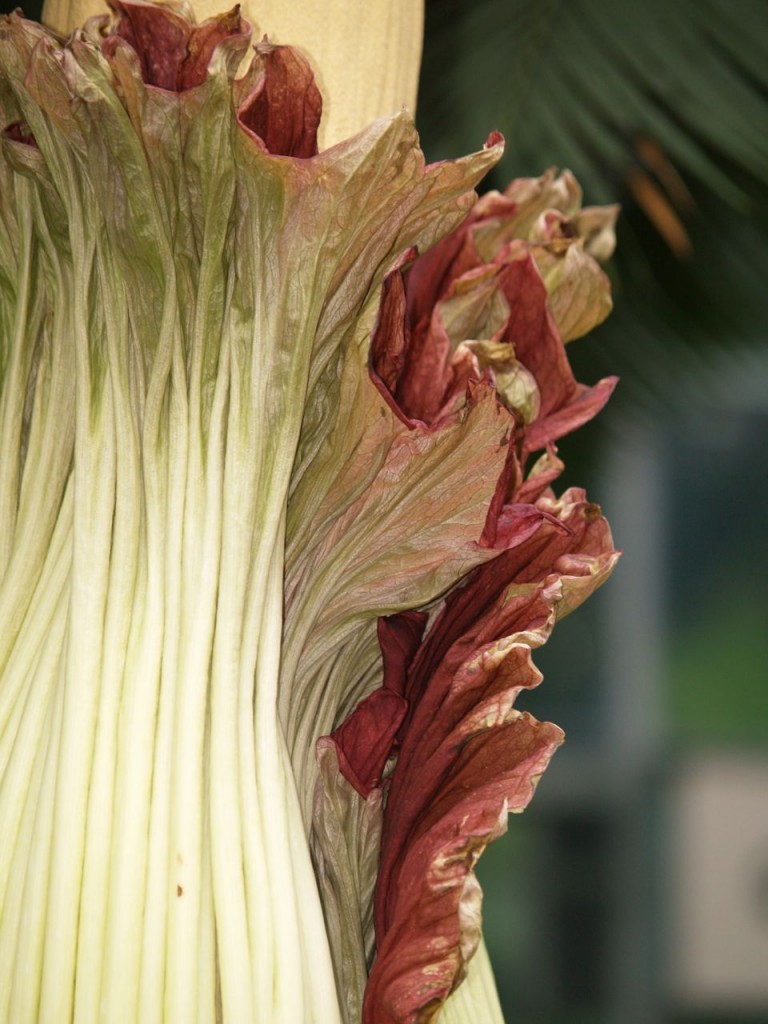
USBG Corpse Flower: July 23
The corpse flower at Washington, DC’s US Botanical Garden’s was in peak bloom yesterday. The spathe is now collapsing back towards the spadix, and the entire plant is starting to wither. The spadix and the upper part of the spathe are starting to become more yellow and less green. The fringe of the spathe reminds me of the leaves of a plant that needs water. As always, to see the changes the plant has gone through, view the photos from the past twelve days (July 11, July 12, July 13, July 14, July 15, July 16, July 17, July 18, July 19, July 20, July 21, and July 22). Also, see the “Corpse Flower” page on my website that has photos from everyday that shows the whole plant so the photos can be more easily compared as well as a video that has a slide show of photos. Finally, as for the daily smell report, there is no smell. The time for the smell is over, but I suppose if they leave it out long enough, it might start to smell as it decays.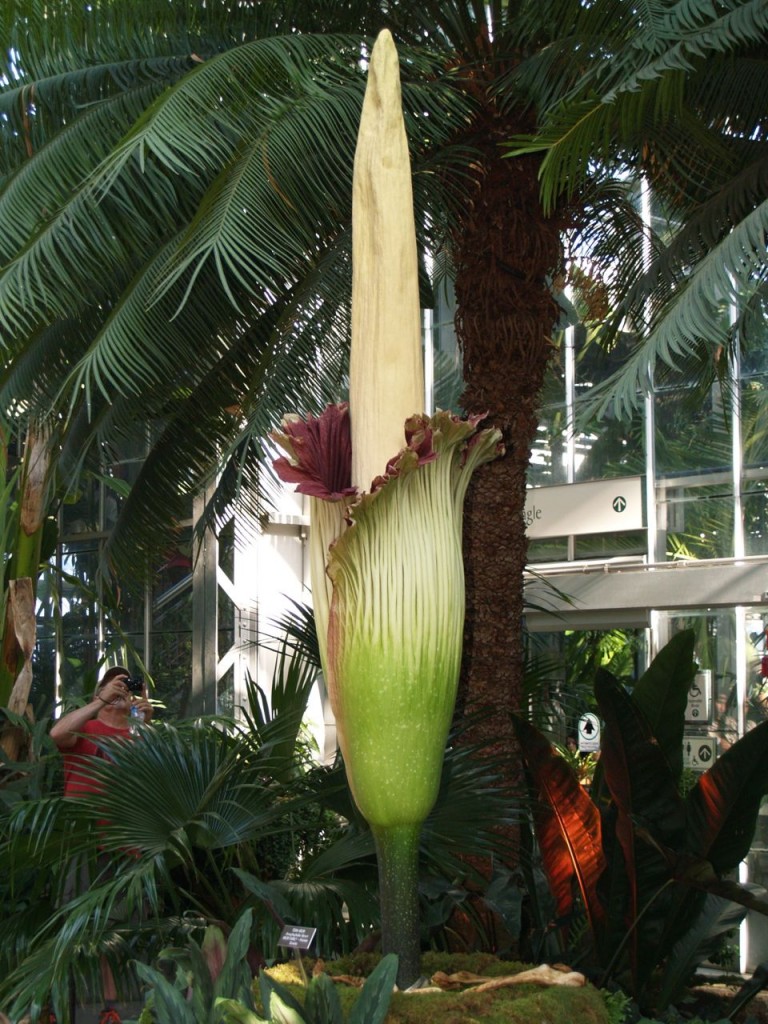
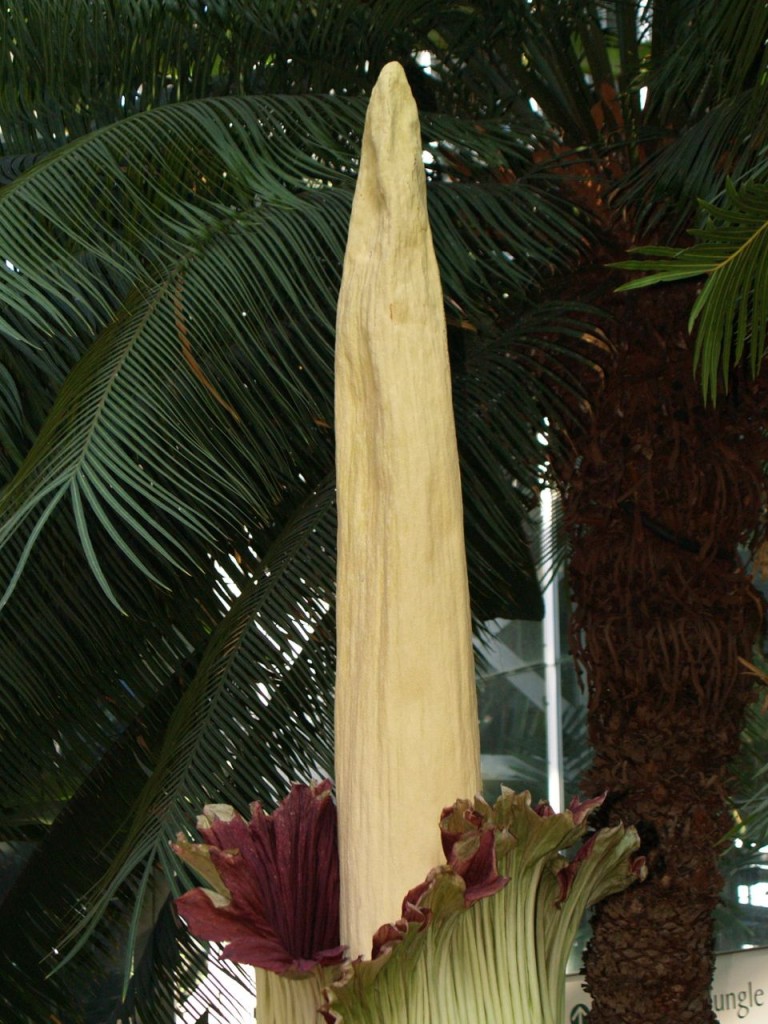

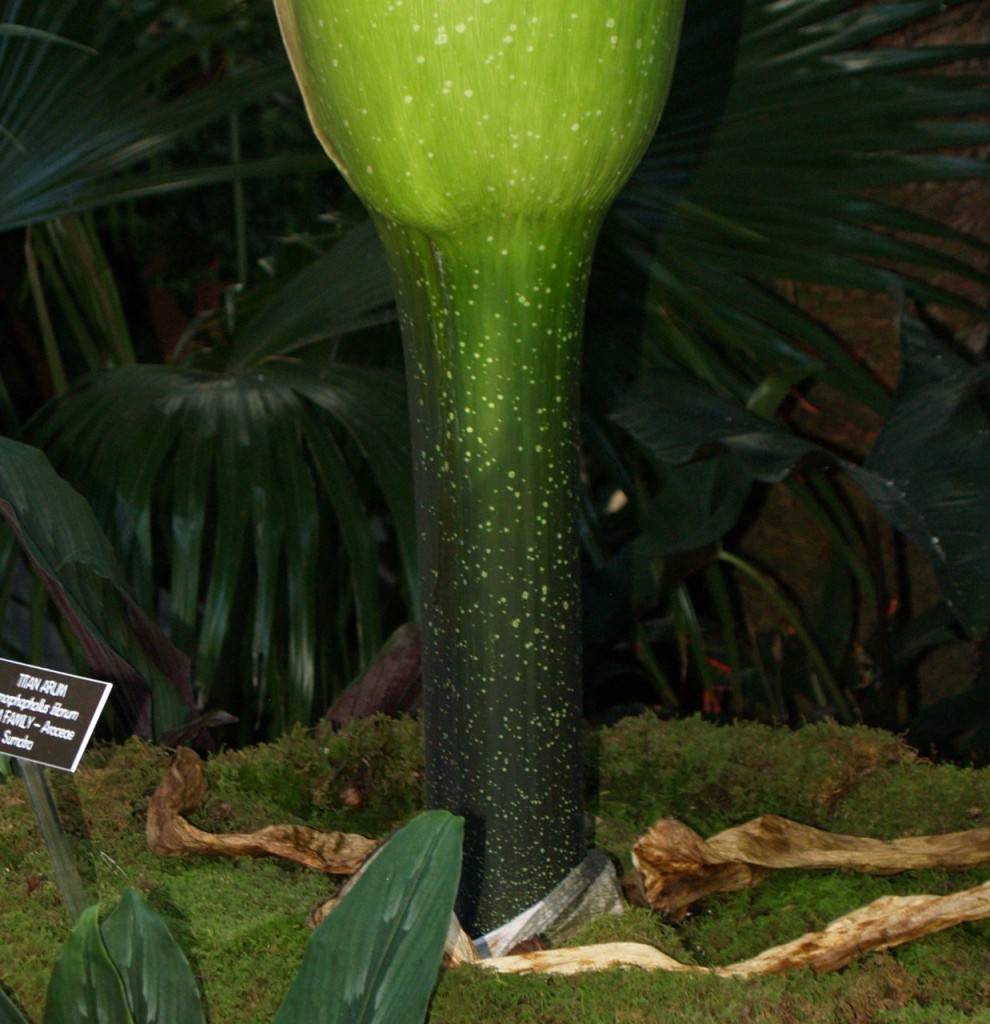
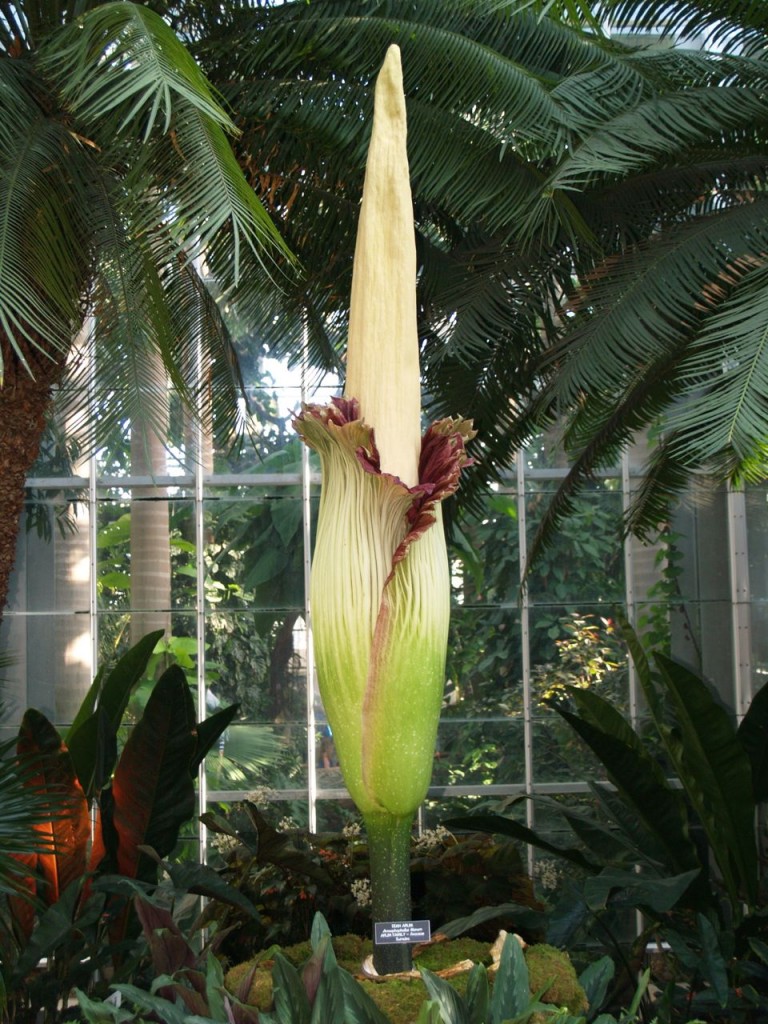
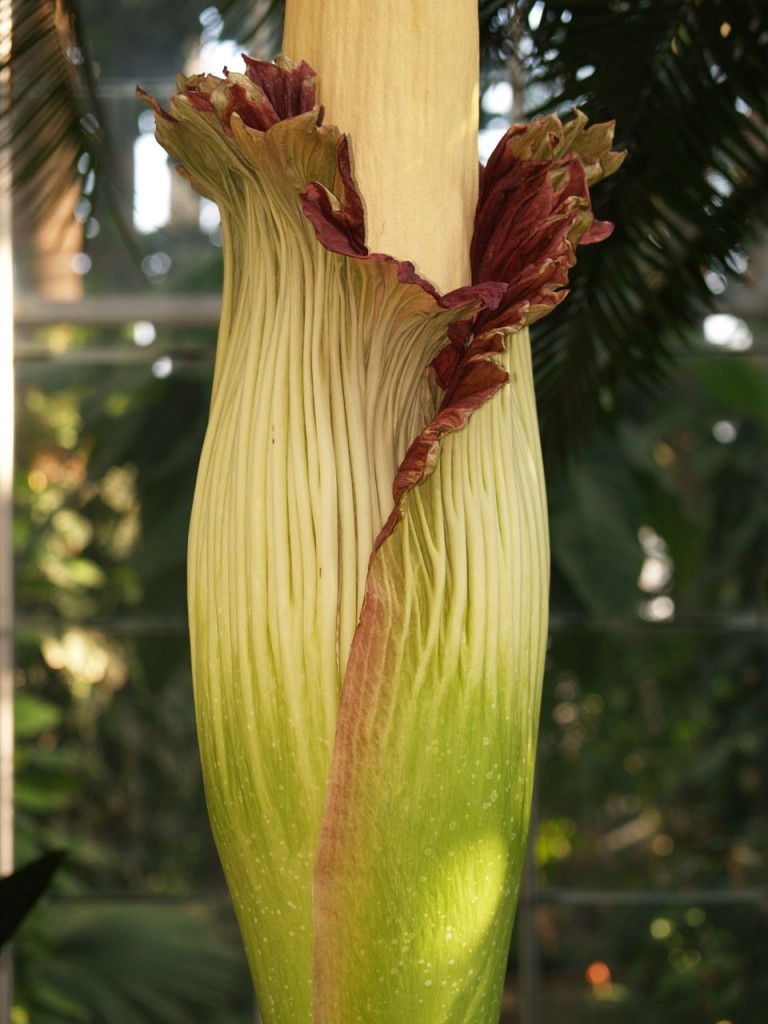
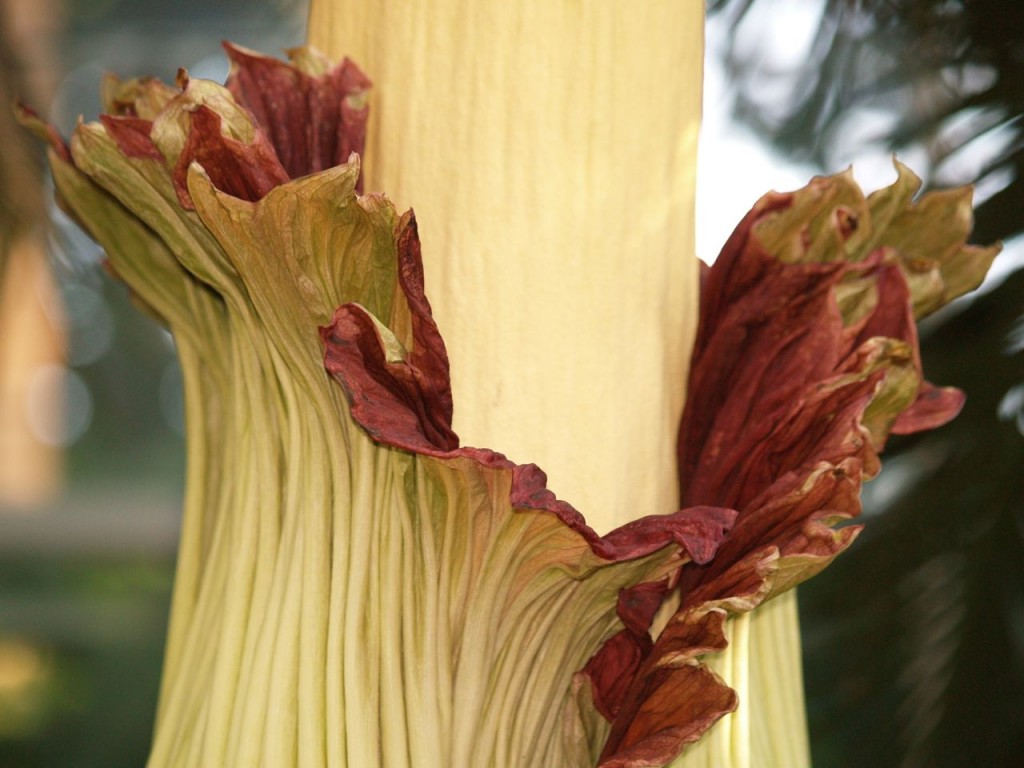
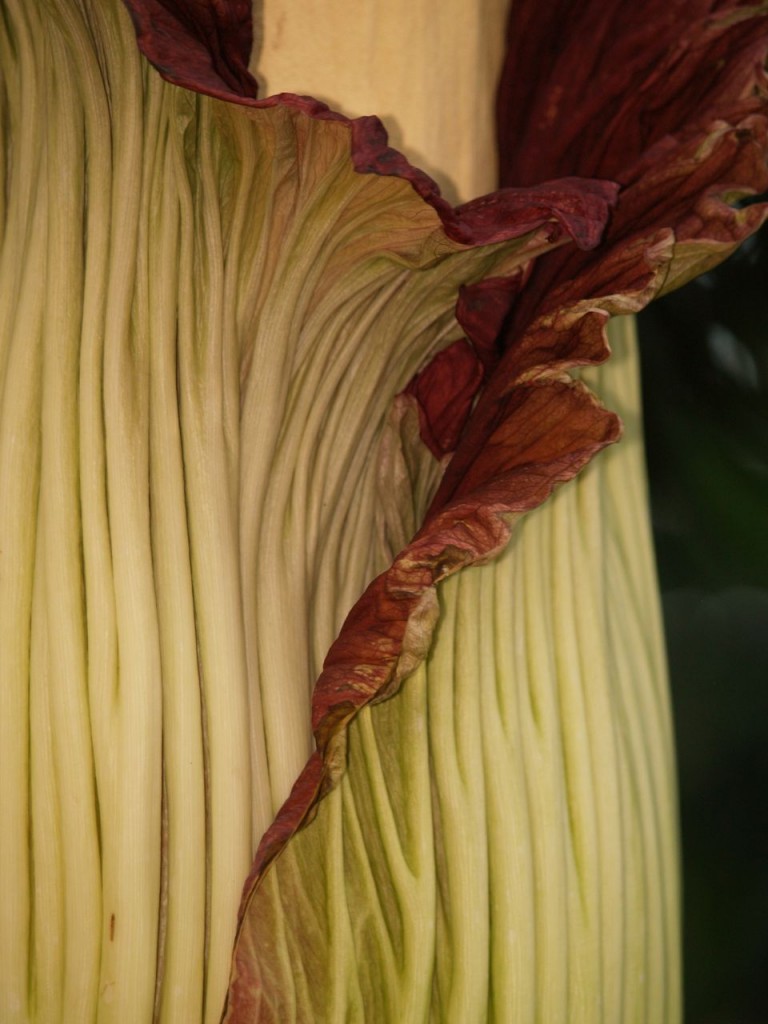
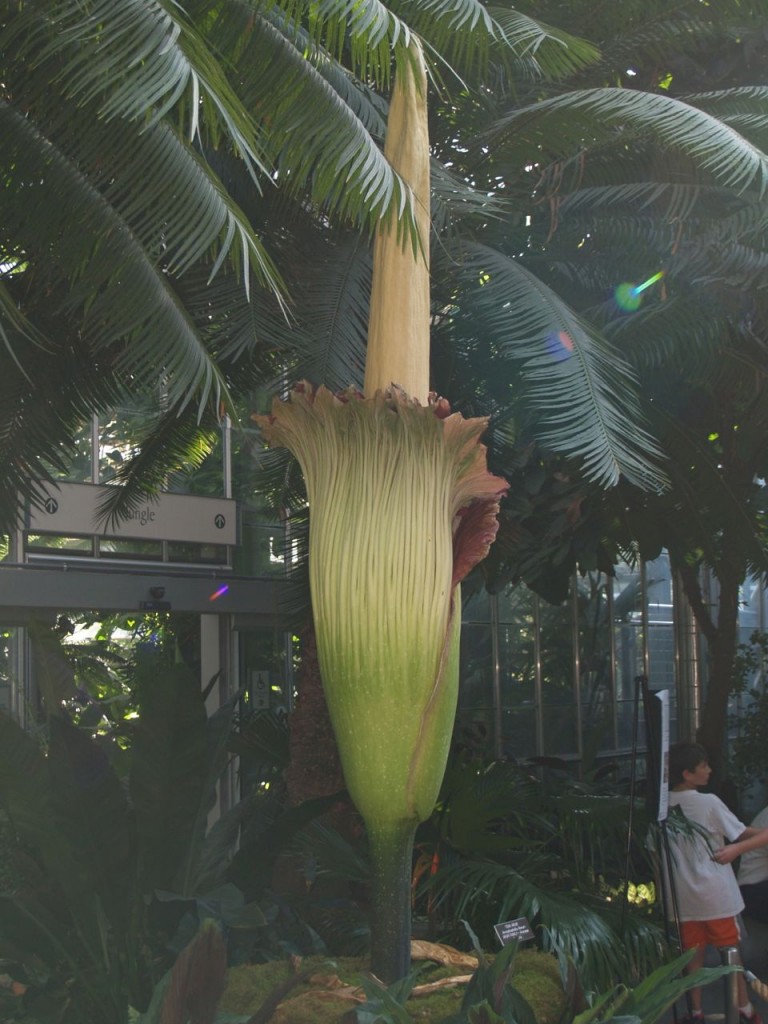
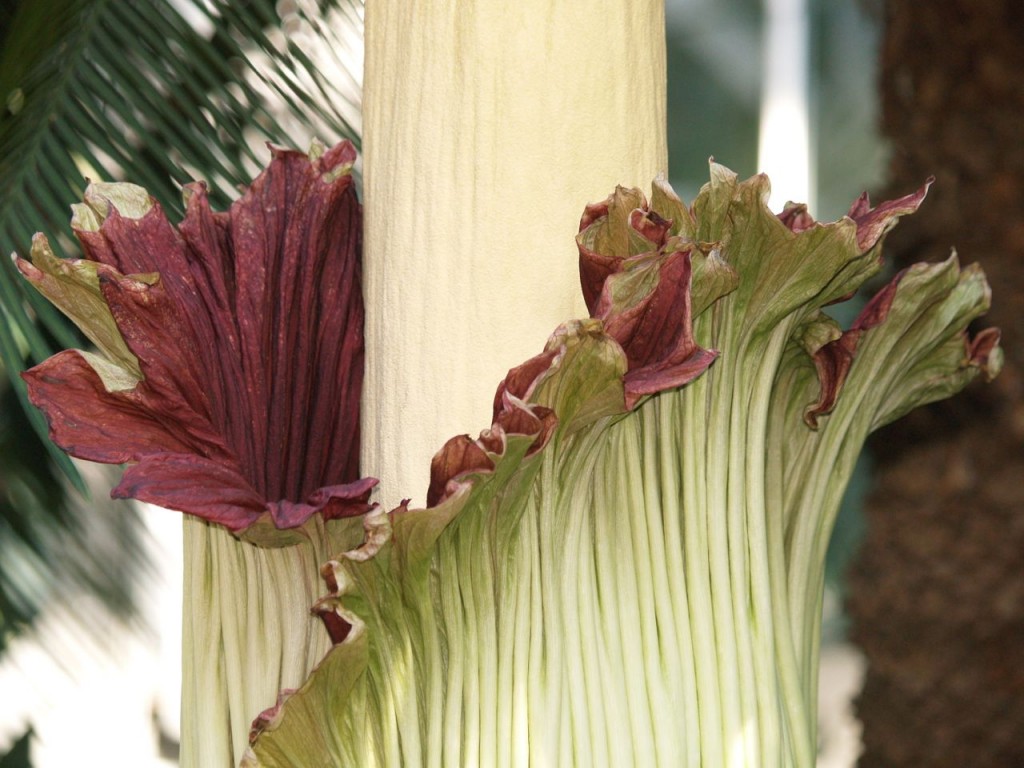
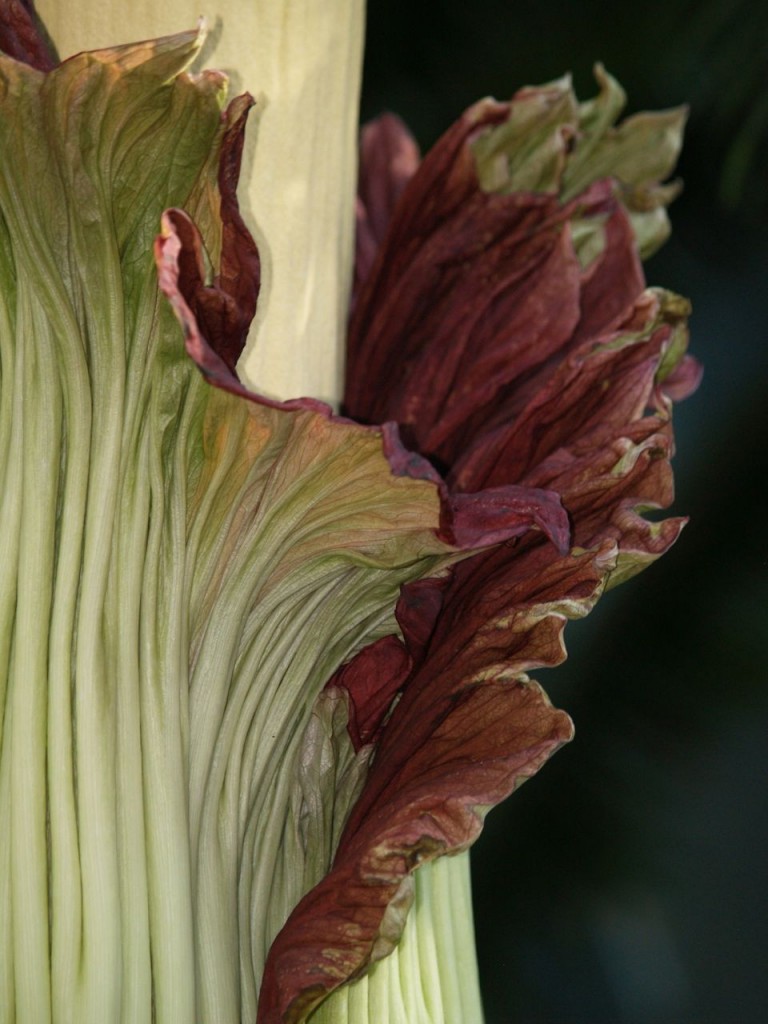
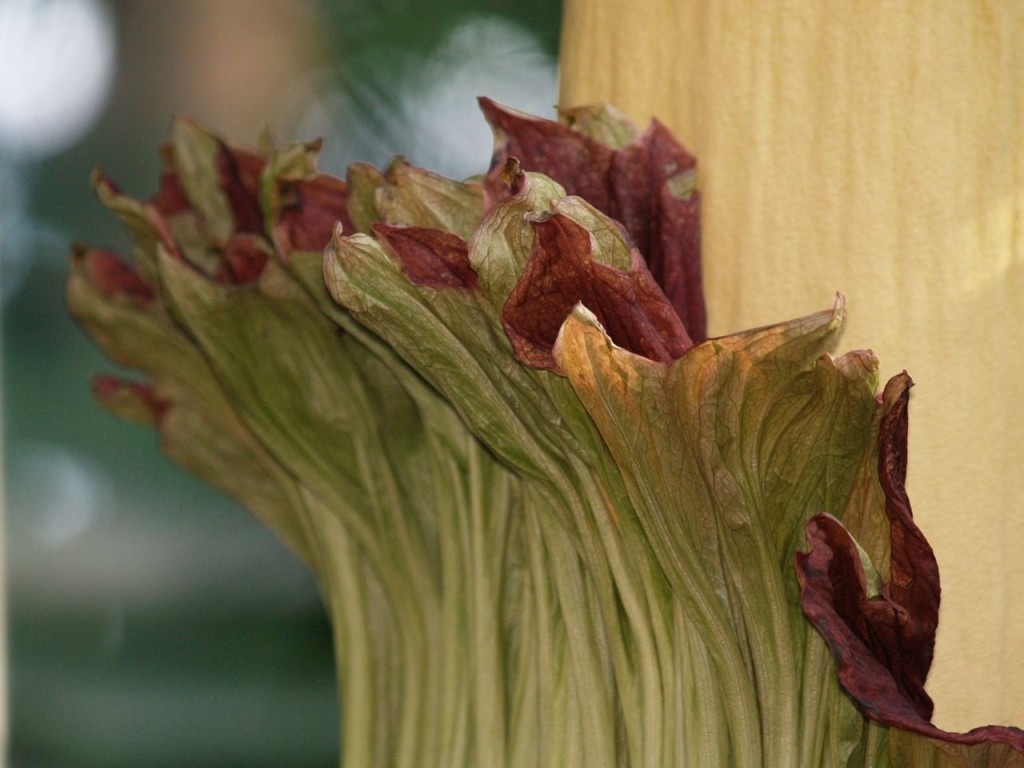
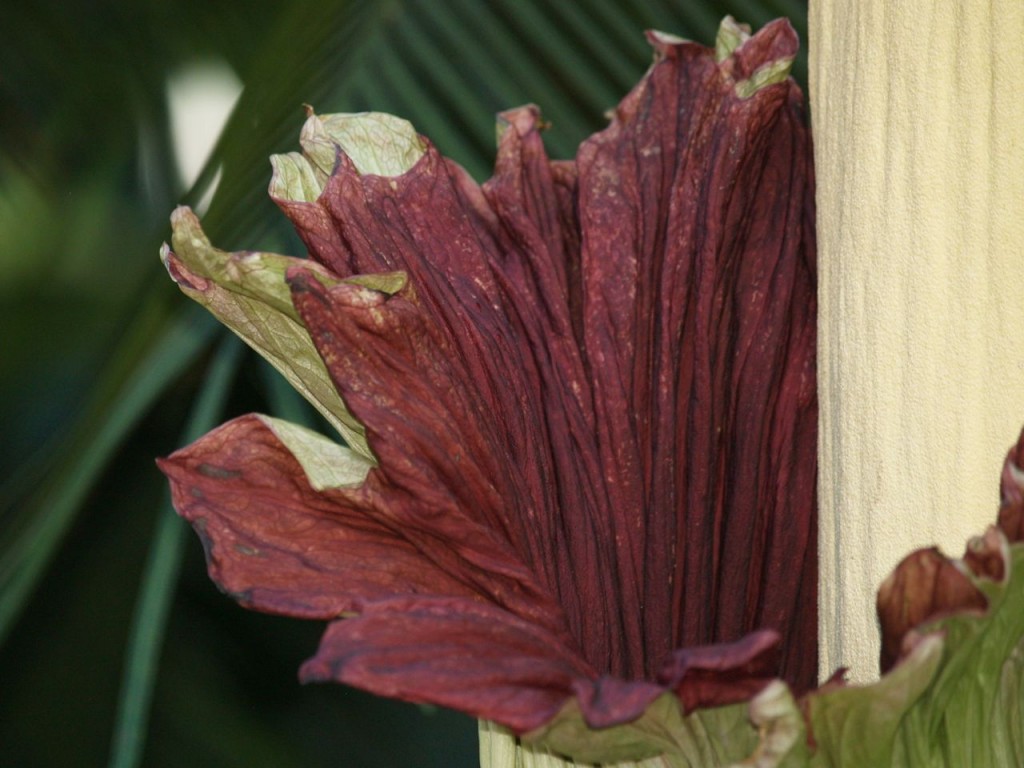
USBG Corpse Flower: July 22 am
The corpse flower at Washington, DC’s US Botanical Garden’s is finally blooming! It is in full bloom now with the spathe completely open. It is absolutely gorgeous. The interior is a deep crimson color, and when the spathe is viewed from below, it looks pinkish as the crimson color is filtered through it. I don’t think my photos can completely do it justice, but I certainly tried. As always, to see the changes the plant has gone through, view the photos from the past eleven days (July 11, July 12, July 13, July 14, July 15, July 16, July 17, July 18, July 19, July 20, and July 21). Also, see the “Corpse Flower” page on my website that has photos from everyday that shows the whole plant so the photos can be more easily compared as well as a video that has a slide show of photos. Finally, as for the daily smell report, I am sorry to report that when I was there from 10 to 11 this morning, there was no smell. I got within four feet of it, and I have a very sensitive nose, but I didn’t smell anything, other than the sweaty people around me. A staff member told me that the smell was most potent late last night. 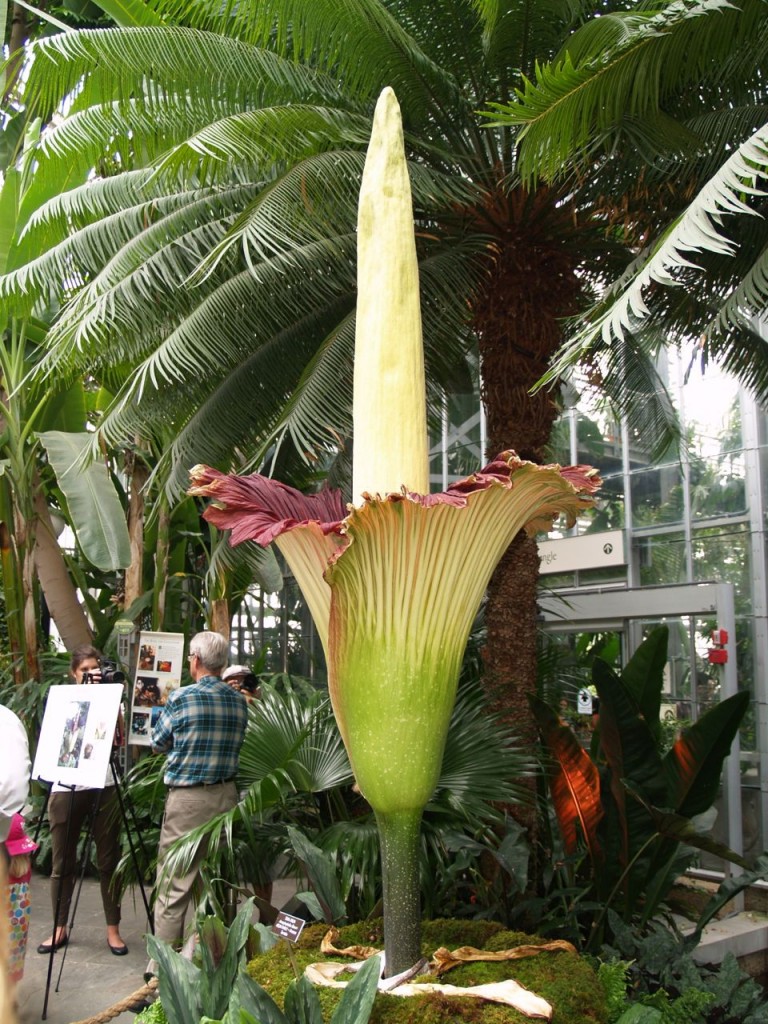
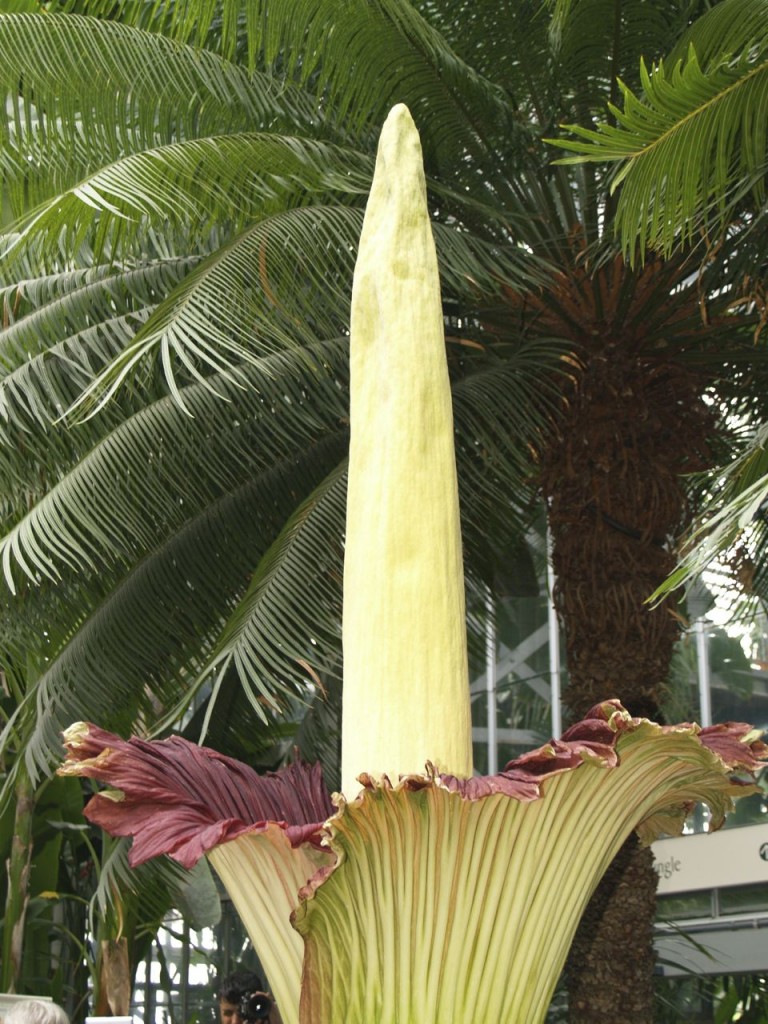
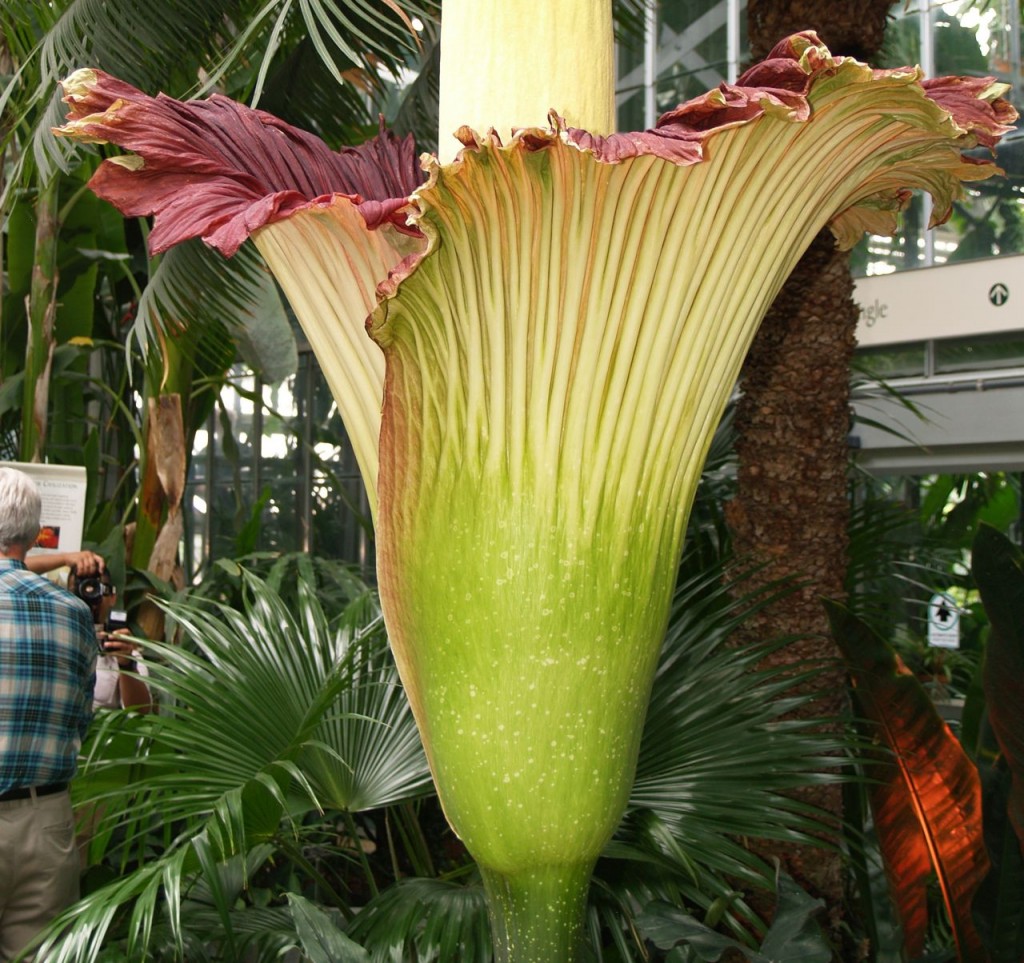
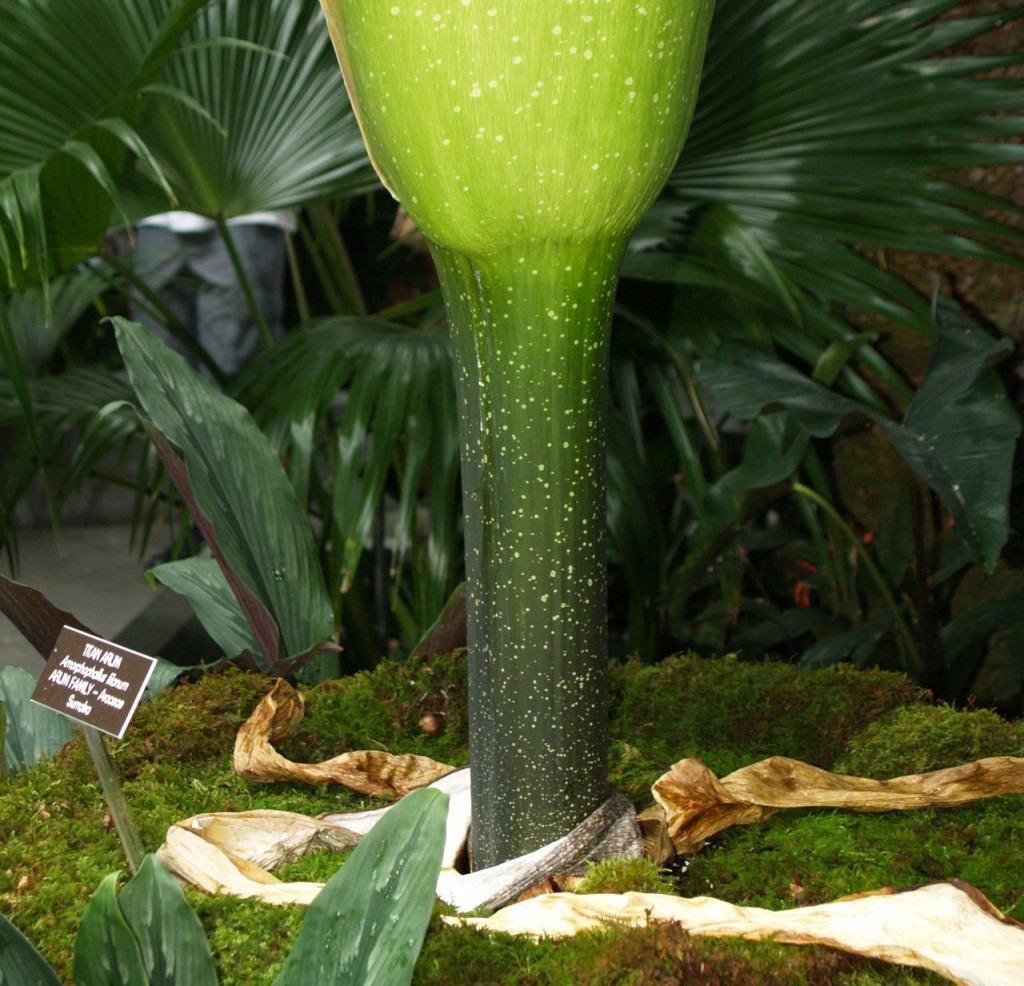
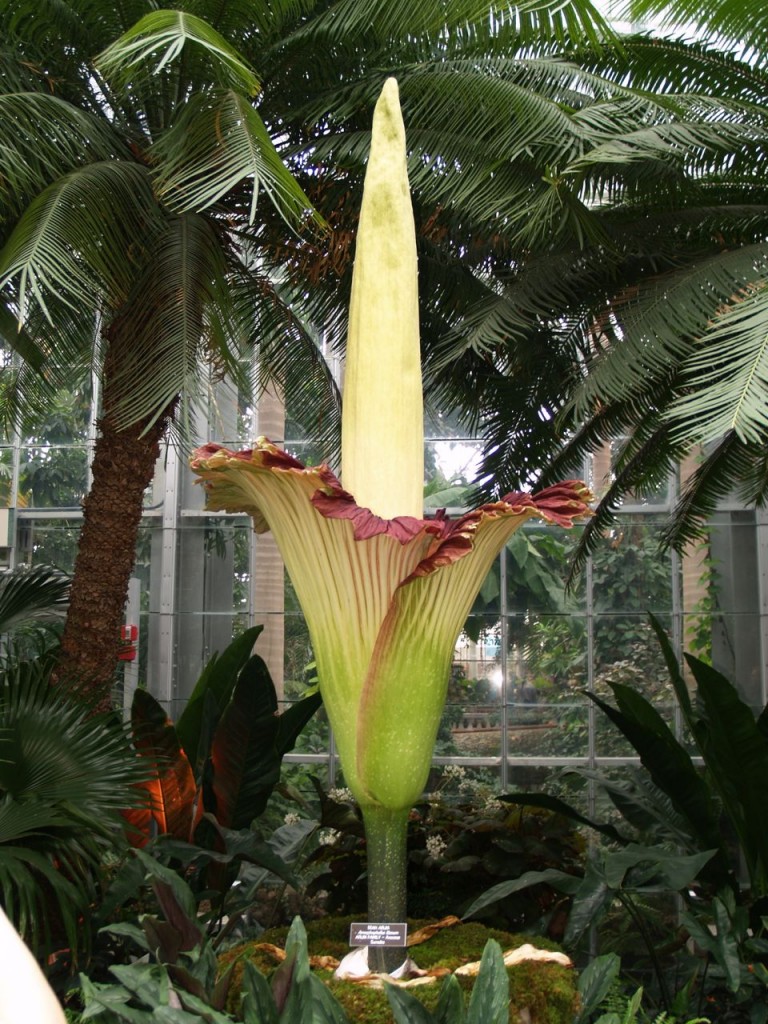
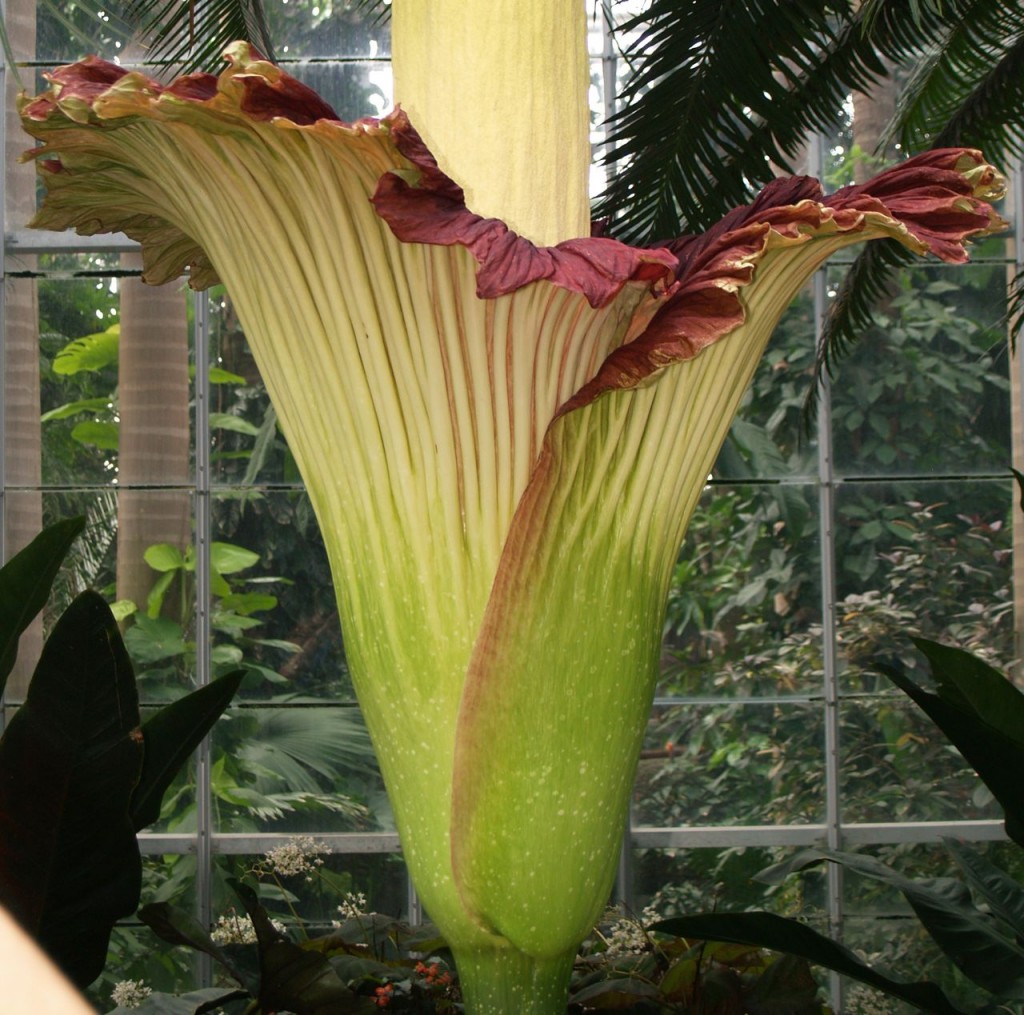
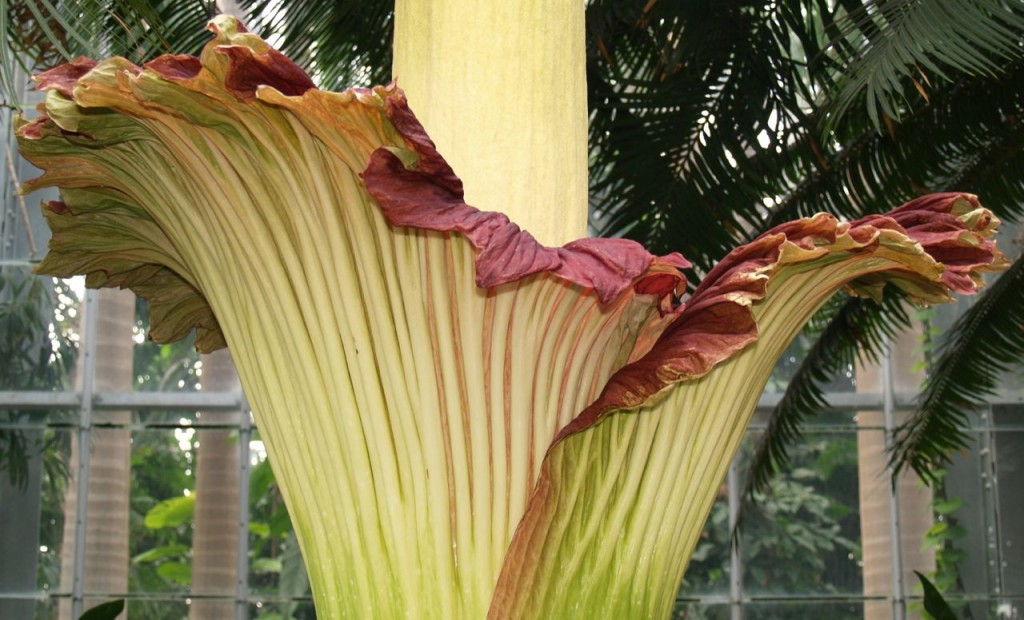
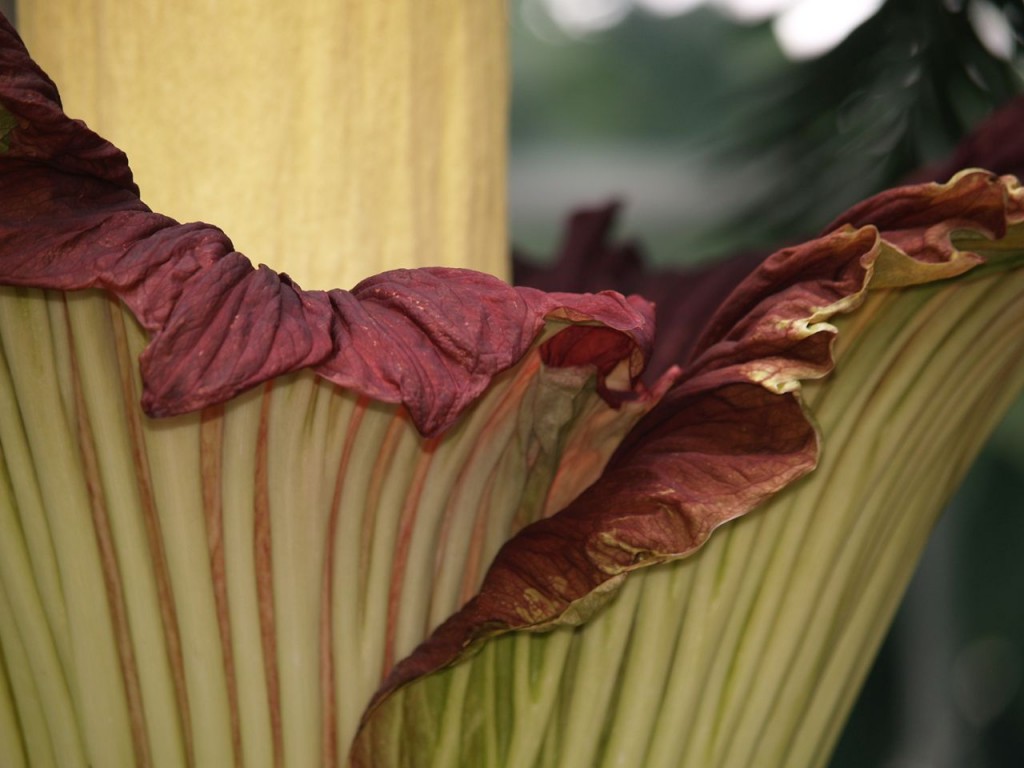
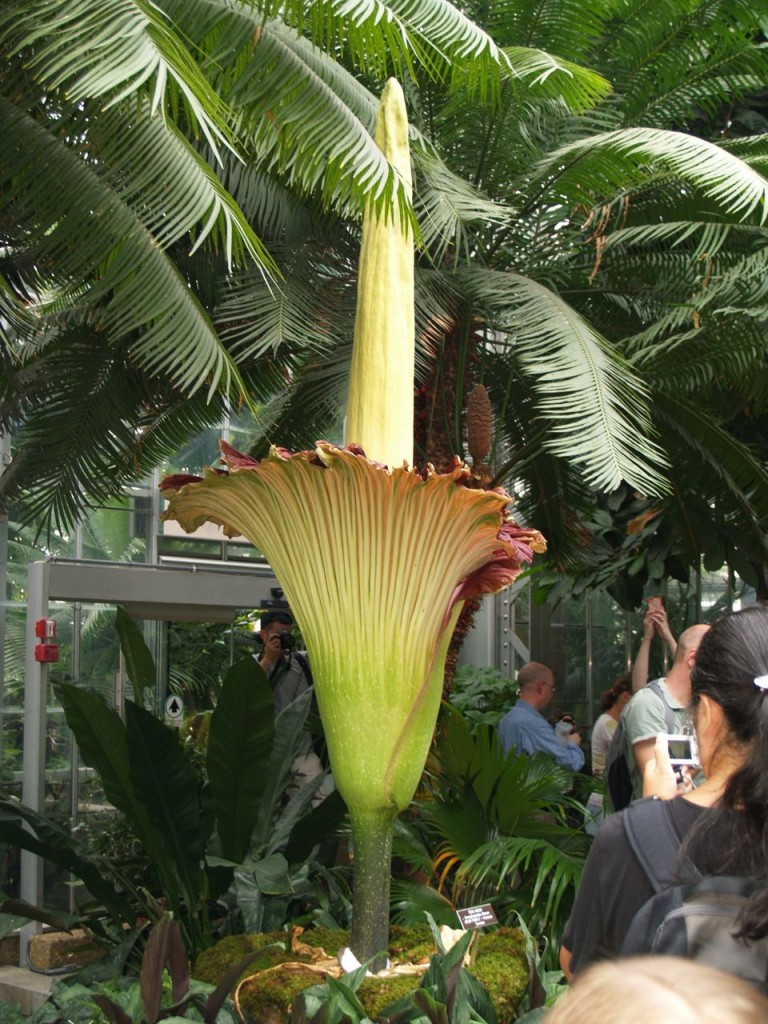
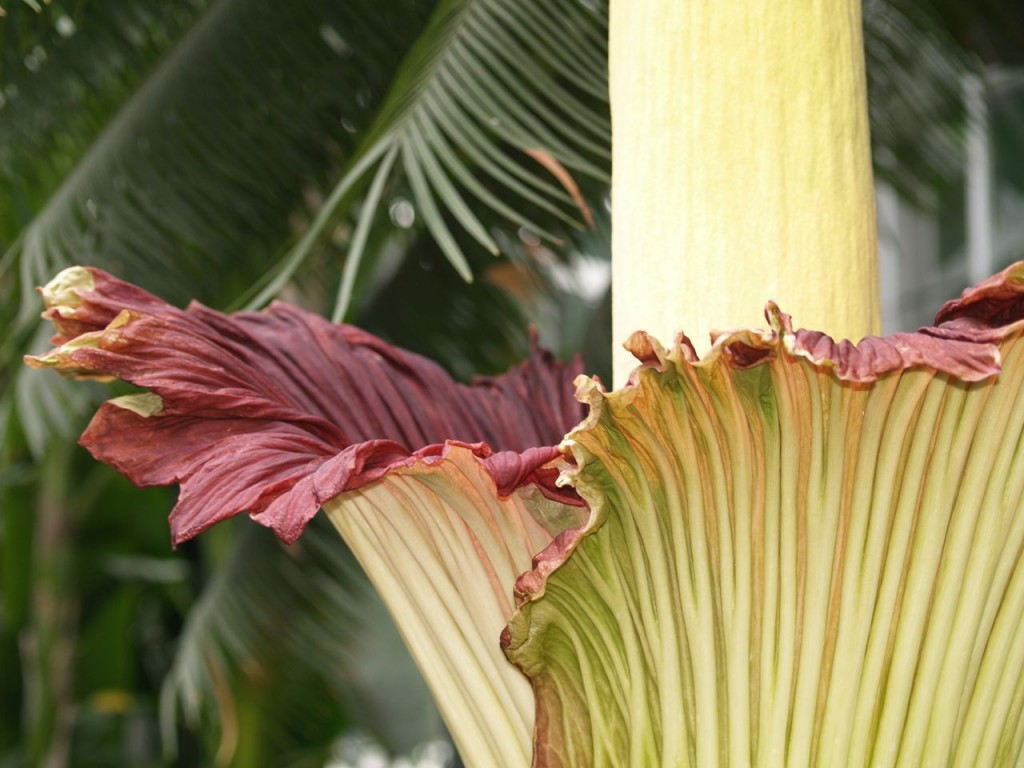
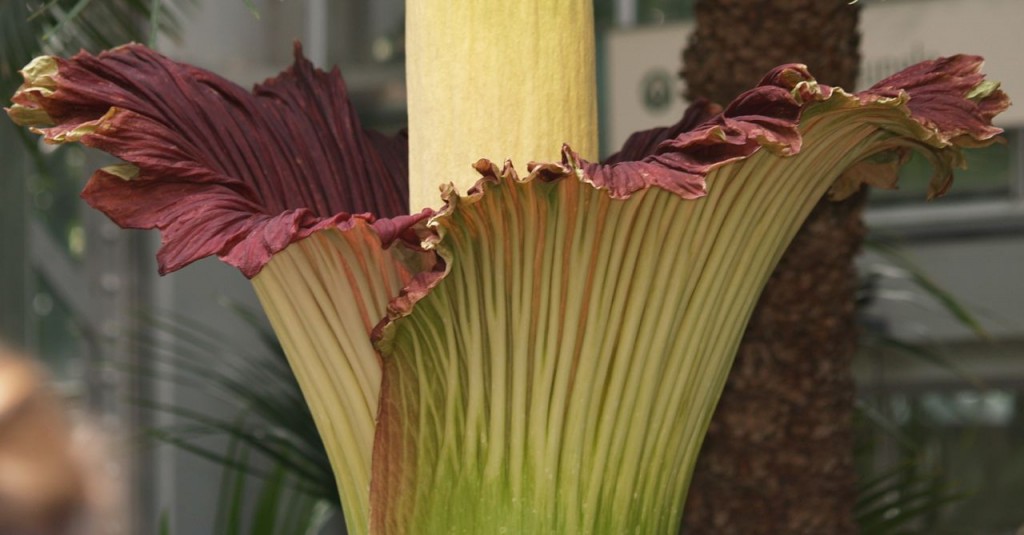
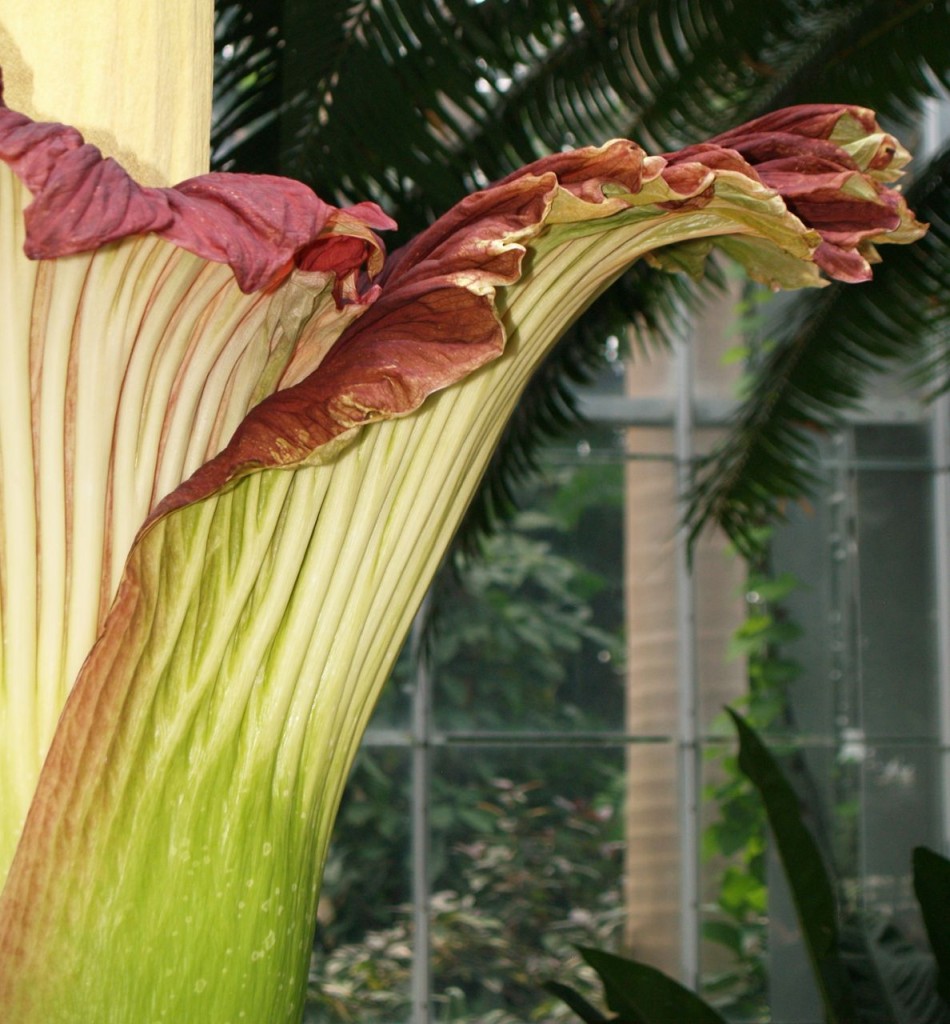
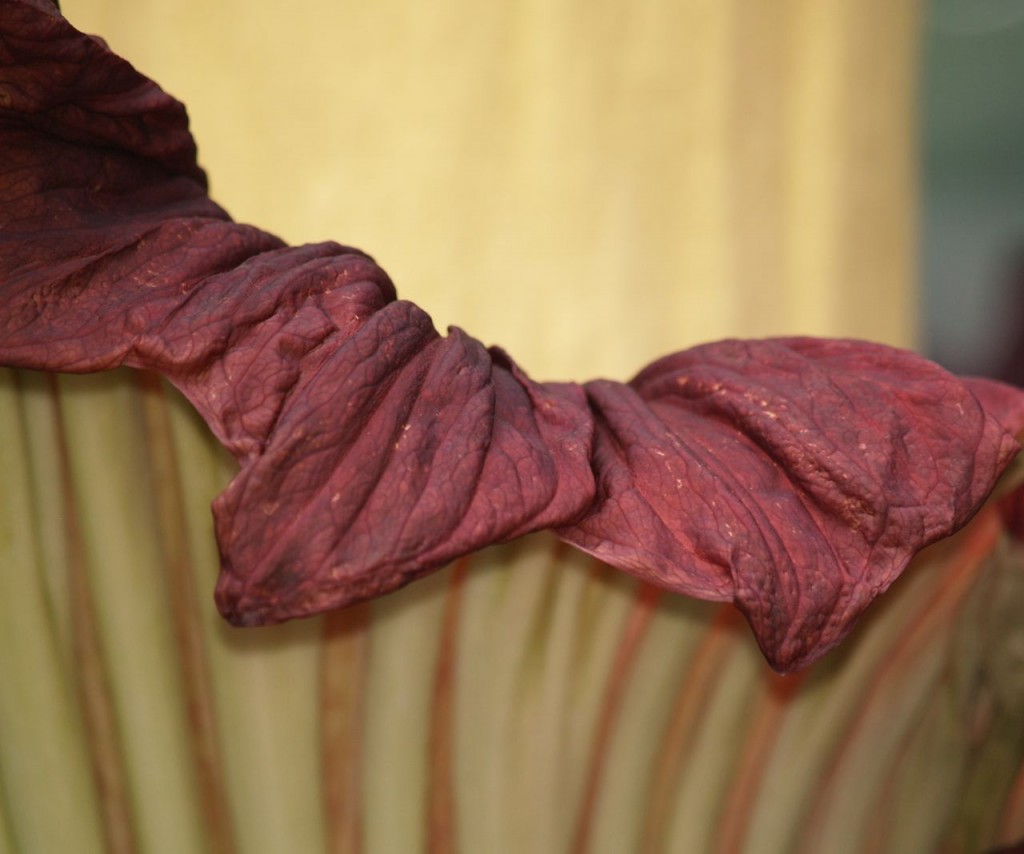
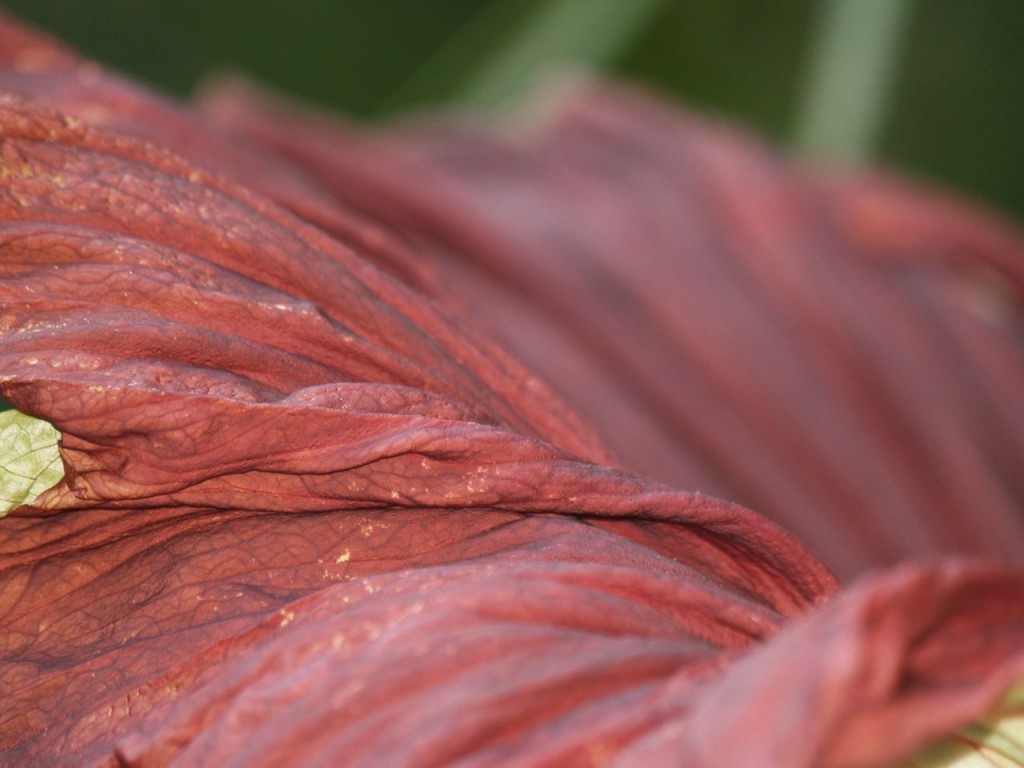
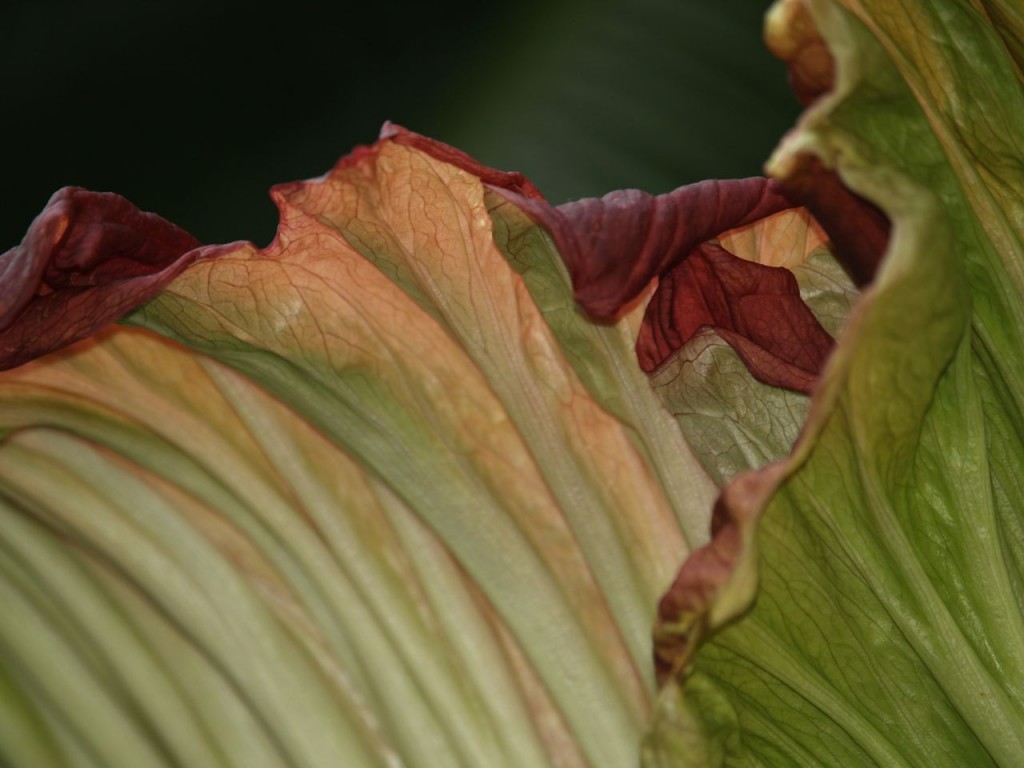 The below photo is almost the exact same photo as the one above, but it was taken without a flash, hence the out of focus-ness. I tried to capture the gorgeous pink color that filters through the spathe due to the spathe’s crimson interior.
The below photo is almost the exact same photo as the one above, but it was taken without a flash, hence the out of focus-ness. I tried to capture the gorgeous pink color that filters through the spathe due to the spathe’s crimson interior. 